Jacqueline Abelson's Blog, page 2
November 27, 2017
10 Books To Read After Watching “Alias Grace”
Lately there has been a slight obsession with Margaret Atwood. Specifically, her books. And honestly, after the year that the Canadian born author has had, who wouldn’t be engrossed with her novels of literary feminism? At the beginning of the month, Netflix released all six episodes to the miniseries, Alias Grace – the 8th novel Atwood had published in her writing career (published in 1996). But what is the most remarkable thing about Alias Grace is that this is the second adaptation of Atwood’s novel that has been brought to the small screen in the six months since Hulu’s release of The Handmaid’s Tale.  The premise of Alias Grace is chilling. Not because it involves murder, but rather how the elements of the story eerily echo the feminist struggles that was depicted in The Handmaid’s Tale. Unlike how Hulu depicted a dystopian society in which fertile women were enslaved to bare children, Netflix goes back in time, focusing solely on the treatment of woman in the mid 19th century. Framed in the form of an elliptical interrogation, Alias Grace opens in 1859, in Victorian Canada, where Grace Marks – a former household servant – has been imprisoned for the 1843 murder of her employer, Thomas Kinnear, and his housekeeper, Nancy Montgomery. The actual killer – or cohort – James McDermott, accuses Grace of using her wiles to manipulate him and mastermind the crime. Grace’s celebrity as a young accused murderer, attracts the attention of a doctor named Simon Jordan to question and hopefully save Grace from life imprisonment. But Simon and the rest of the viewers can’t help but wonder:
The premise of Alias Grace is chilling. Not because it involves murder, but rather how the elements of the story eerily echo the feminist struggles that was depicted in The Handmaid’s Tale. Unlike how Hulu depicted a dystopian society in which fertile women were enslaved to bare children, Netflix goes back in time, focusing solely on the treatment of woman in the mid 19th century. Framed in the form of an elliptical interrogation, Alias Grace opens in 1859, in Victorian Canada, where Grace Marks – a former household servant – has been imprisoned for the 1843 murder of her employer, Thomas Kinnear, and his housekeeper, Nancy Montgomery. The actual killer – or cohort – James McDermott, accuses Grace of using her wiles to manipulate him and mastermind the crime. Grace’s celebrity as a young accused murderer, attracts the attention of a doctor named Simon Jordan to question and hopefully save Grace from life imprisonment. But Simon and the rest of the viewers can’t help but wonder:
Did she actually do it?
As the viewers get further and further into Grace’s story, they learn that a single woman at this point in time is either an innocent virgin or a deceptive whore. Both the novel and in the Netflix miniseries accurately portray how women were treated in the 1800’s, and the manners in which they needed to adapt to survive. While Grace at times seems like the innocent victim she claims to be, viewers catch glimpses of her more manipulative side. So is she actually fully innocent? Is she completely guilty? Or is she a little bit of both? Overall, there is no doubt that Grace is a complex character with many secrets. She is either a convincingly timid child, or a toughened inmate. And in a time when men abused their power over women, sometimes a little manipulation was what was needed just to get by. So if you’re in search of crafty women whose actions may or may not be justified by their crimes, there’s luckily no shortage of books for an engrossing topic like that. And after finishing watching Alias Grace, these women – just like Grace Marks – will seem ambiguous, but also absolutely mesmerizing.
(Note: My suggestion would be to watch The Handmaid’s Tale first before watching Alias Grace in order to compare the two shows).
#10: Burial Rites by Hannah Kent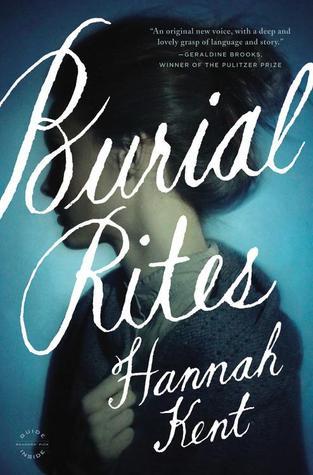 Based upon actual events, this fictional account tells the story of Agnes Magnúsdottir, the last person executed in Iceland in 1830. Agnes has already been convicted of the murder of Nathan Ketilson and Pétur Jónsson and condemned to death for her crime, along with her co-conspirators, Fridrik Sigurdsson and Sigga Gudmundsdóttir. As she awaits her execution, Agnes is housed at a farm in Kornsá, belonging to the District Officer, Jón and his family. At first the family in Kornsá is hostile around Agnes as she helps with the chores around the farm. It is there where she meets with her spiritual advisor, Tóti whom she tells her life story to him and her encounter with Nathan Ketilson on the farm. As her story unfolds, Nathan emerges as a manipulator and as a sexual predator. Agnes’s voice at times feels claustrophobic with tension. With a combination of the appalling Icelandic winter and the muggy conditions of the Kornsá farm, Burial Rites has a colder, more precise tone compared to Alias Grace. But like Atwood’s writing, Kent creates a striking character in Agnes. An ambiguous and perplexing young woman who, even in the face of death, cannot be pinned down.
Based upon actual events, this fictional account tells the story of Agnes Magnúsdottir, the last person executed in Iceland in 1830. Agnes has already been convicted of the murder of Nathan Ketilson and Pétur Jónsson and condemned to death for her crime, along with her co-conspirators, Fridrik Sigurdsson and Sigga Gudmundsdóttir. As she awaits her execution, Agnes is housed at a farm in Kornsá, belonging to the District Officer, Jón and his family. At first the family in Kornsá is hostile around Agnes as she helps with the chores around the farm. It is there where she meets with her spiritual advisor, Tóti whom she tells her life story to him and her encounter with Nathan Ketilson on the farm. As her story unfolds, Nathan emerges as a manipulator and as a sexual predator. Agnes’s voice at times feels claustrophobic with tension. With a combination of the appalling Icelandic winter and the muggy conditions of the Kornsá farm, Burial Rites has a colder, more precise tone compared to Alias Grace. But like Atwood’s writing, Kent creates a striking character in Agnes. An ambiguous and perplexing young woman who, even in the face of death, cannot be pinned down.
#9: Gone Girl by Gillian Flynn
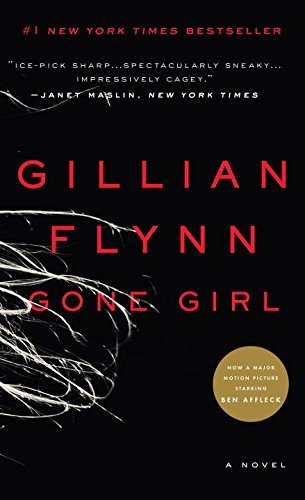 The first part of the novel centers around Nick Dunne and his wife Amy’s marriage. According to Nick, on the morning of their fifth anniversary, Nick wakes up to find that Amy has disappeared from their home in North Carthage, Missouri. As the days pass with no sign of Amy, the police and the media position their attention on Nick as the sole suspect for murder. The narration shifts when Amy chronicles her relationship with Nick through past diary entries, describing how her and Nick’s seemingly charmed romance begins to deteriorate. As the evidence against Nick continues to pile up against him, Nick continues to deny that he had any involvement with Amy’s disappearance. Yet, as the police find more and more clues to Amy’s disappearance, Nick becomes increasingly concerned that Amy knew more about some of his secrets than she let on. As a result, he tries not to reveal that his marriage was troubled or any other details that might implicate him. But did he actually have a hand in Amy’s disappearance? Just like Alias Grace, we get interesting scraps of information from the main characters. We think we know and understand them, until something comes out of left field to unhinge it all.
The first part of the novel centers around Nick Dunne and his wife Amy’s marriage. According to Nick, on the morning of their fifth anniversary, Nick wakes up to find that Amy has disappeared from their home in North Carthage, Missouri. As the days pass with no sign of Amy, the police and the media position their attention on Nick as the sole suspect for murder. The narration shifts when Amy chronicles her relationship with Nick through past diary entries, describing how her and Nick’s seemingly charmed romance begins to deteriorate. As the evidence against Nick continues to pile up against him, Nick continues to deny that he had any involvement with Amy’s disappearance. Yet, as the police find more and more clues to Amy’s disappearance, Nick becomes increasingly concerned that Amy knew more about some of his secrets than she let on. As a result, he tries not to reveal that his marriage was troubled or any other details that might implicate him. But did he actually have a hand in Amy’s disappearance? Just like Alias Grace, we get interesting scraps of information from the main characters. We think we know and understand them, until something comes out of left field to unhinge it all.
#8: In the Woods by Tana French
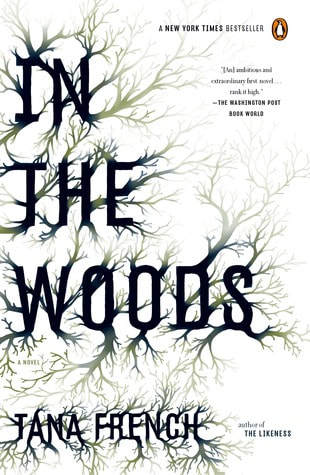 In 1984, in the charming little town of Knocknaree, Ireland, three kids went into the woods, and only one of them came back alive. Two decades later, another girl is found dead in the woods. And – coincidentally – the lead detective on the case, Rob Ryan, is the surviving boy who escaped from the woods twenty years ago. Rob has no memory about the day his friends went missing. The only thing he knows is that he emerged from the woods wearing nothing but a torn t-shirt and bloody sneakers. With his partner, Cassie Maddox, he and Cassie investigate the murder of the girl, Katy Devlin. But who would want to kill this twelve-year-old girl with a passion for dance? Could it be her father, Jonathan, who has a sketchy past? Mark, the archeologist who seems just a little too attached to the woods? Was it the mysterious man in a tracksuit who was seen at the crime scene by Damien, another archeologist, and Jessica, Katy’s twin sister? Or was it Sandra? As Rob and Cassie delve deeper and deeper into the case, Rob tries to remember what happened those twenty years ago, only for his repressed memories to come up with an unexpected clue.
In 1984, in the charming little town of Knocknaree, Ireland, three kids went into the woods, and only one of them came back alive. Two decades later, another girl is found dead in the woods. And – coincidentally – the lead detective on the case, Rob Ryan, is the surviving boy who escaped from the woods twenty years ago. Rob has no memory about the day his friends went missing. The only thing he knows is that he emerged from the woods wearing nothing but a torn t-shirt and bloody sneakers. With his partner, Cassie Maddox, he and Cassie investigate the murder of the girl, Katy Devlin. But who would want to kill this twelve-year-old girl with a passion for dance? Could it be her father, Jonathan, who has a sketchy past? Mark, the archeologist who seems just a little too attached to the woods? Was it the mysterious man in a tracksuit who was seen at the crime scene by Damien, another archeologist, and Jessica, Katy’s twin sister? Or was it Sandra? As Rob and Cassie delve deeper and deeper into the case, Rob tries to remember what happened those twenty years ago, only for his repressed memories to come up with an unexpected clue.
#7: The Silent Wife by A.S.A Harrison The Silent Wife is a tale of a long-term relationship gone bad with no possible way of fixing it. Jodi Brett and Todd Gilbert have been together for twenty years, but Todd’s infidelity lead to the demise of his relationship with Jodi. Todd has been unfaithful throughout his relationship, but Jodi has managed to look the other way in order to maintain the upscale lifestyle to which she has become accustomed to in their Chicago highrise. But when Todd’s latest indiscretion becomes pregnant, Todd leaves the well-ordered home he has shared with Jodi to live in an apartment with his now expecting mistress. When Todd’s lawyer orders Jodi to vacate the condo, Jodi is in disbelief that Todd would be capable of removing her from the home and life they shared for so many years. But when one of Jodi’s friends offers to assist her for a price, Jodi can’t help but be tempted by the proposal for revenge against Todd.
The Silent Wife is a tale of a long-term relationship gone bad with no possible way of fixing it. Jodi Brett and Todd Gilbert have been together for twenty years, but Todd’s infidelity lead to the demise of his relationship with Jodi. Todd has been unfaithful throughout his relationship, but Jodi has managed to look the other way in order to maintain the upscale lifestyle to which she has become accustomed to in their Chicago highrise. But when Todd’s latest indiscretion becomes pregnant, Todd leaves the well-ordered home he has shared with Jodi to live in an apartment with his now expecting mistress. When Todd’s lawyer orders Jodi to vacate the condo, Jodi is in disbelief that Todd would be capable of removing her from the home and life they shared for so many years. But when one of Jodi’s friends offers to assist her for a price, Jodi can’t help but be tempted by the proposal for revenge against Todd.
#6: Cartwheel by Jennifer duBois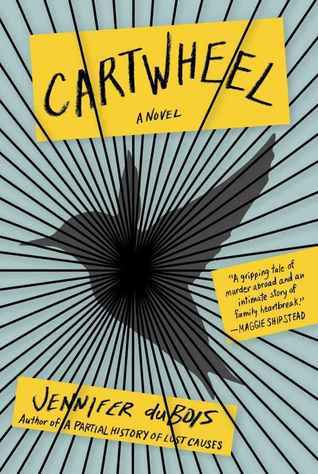 Just like the Amanda Knox case, Cartwheel is a suspenseful and haunting novel of an American foreign exchange student arrested for murder. When Lily Hayes arrives in Buenos Aires for her semester abroad, she is instantly enchanted by everything she encounters: the buildings, the food, but especially the handsome, elusive man next door. Nothing was going to stop Lily from having the time of her life, not even her boring American roommate Katy. But then five weeks into her study abroad program, Katy is found brutally murdered in their shared home. In between the revealing deceptions and the suspicious evidence of DNA, Lily is the prime suspect in the eyes of the media, her family and even in the man who seeks her conviction. So who exactly is Lily Hayes? And what happened to her roommate? No two readers will ever agree.
Just like the Amanda Knox case, Cartwheel is a suspenseful and haunting novel of an American foreign exchange student arrested for murder. When Lily Hayes arrives in Buenos Aires for her semester abroad, she is instantly enchanted by everything she encounters: the buildings, the food, but especially the handsome, elusive man next door. Nothing was going to stop Lily from having the time of her life, not even her boring American roommate Katy. But then five weeks into her study abroad program, Katy is found brutally murdered in their shared home. In between the revealing deceptions and the suspicious evidence of DNA, Lily is the prime suspect in the eyes of the media, her family and even in the man who seeks her conviction. So who exactly is Lily Hayes? And what happened to her roommate? No two readers will ever agree.
#5: The Passenger by Liza Lutz Lisa Lutz’s acclaimed thriller begins with a woman on the lamb after her husband’s body is found at the base of the stairs. Did she really do it? It’s hard to tell until the final pages. All the reader knows is that Tanya DuBois doesn’t exist. At least not anymore. As “Tanya” watches her life recede into the rearview mirror, we know that she has gone by many alias: Amelia Keen, Debra Maze, Emma Lark, Sonia Lubovich, or a girl called only Jo. She is known as “Amelia” when she meets Blue, another woman with a life similar to her own. But their pasts and futures clash as the body count rises around them. Lutz does a fantastic job capturing Tanya’s fragility hidden underneath her tough exterior. By creating a trust between the narrator and the reader, there is something about Tanya’s character that forces the readers to view her in an unlikely favorable light.
Lisa Lutz’s acclaimed thriller begins with a woman on the lamb after her husband’s body is found at the base of the stairs. Did she really do it? It’s hard to tell until the final pages. All the reader knows is that Tanya DuBois doesn’t exist. At least not anymore. As “Tanya” watches her life recede into the rearview mirror, we know that she has gone by many alias: Amelia Keen, Debra Maze, Emma Lark, Sonia Lubovich, or a girl called only Jo. She is known as “Amelia” when she meets Blue, another woman with a life similar to her own. But their pasts and futures clash as the body count rises around them. Lutz does a fantastic job capturing Tanya’s fragility hidden underneath her tough exterior. By creating a trust between the narrator and the reader, there is something about Tanya’s character that forces the readers to view her in an unlikely favorable light.
#4: Moral Defense by Marcia Clark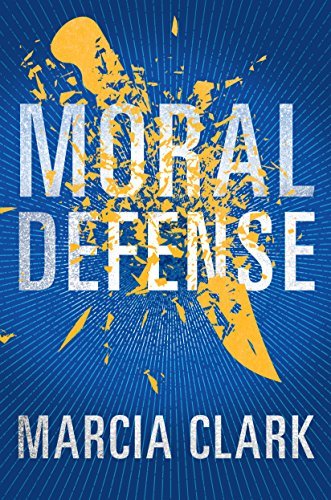 In the second book in the Samantha Brinkman series written by Marcia Clark (yes, you read that right. That Marcia Clark, from the O.J. Simpson trial), Samantha is not concerned about guilt or innocence. Her prime interests is making sure that her clients walk. She understands that a crime can sometimes be committed for personal reasons, business reasons, pleasure or justice. Whatever the reason, Samantha’s duty is to keep her clients free. In Moral Defense, a personal chord is struck when she meets Cassie Sonnenberg, an adopted teenager accused of fatally stabbing her brother and father and accused of being responsible for her mother clinging to life in the hospital. Suddenly, Sam is facing her biggest challenge yet. And as it turns out, the maybe-murder and her attorney have more in common than Sam ever could have imagined.
In the second book in the Samantha Brinkman series written by Marcia Clark (yes, you read that right. That Marcia Clark, from the O.J. Simpson trial), Samantha is not concerned about guilt or innocence. Her prime interests is making sure that her clients walk. She understands that a crime can sometimes be committed for personal reasons, business reasons, pleasure or justice. Whatever the reason, Samantha’s duty is to keep her clients free. In Moral Defense, a personal chord is struck when she meets Cassie Sonnenberg, an adopted teenager accused of fatally stabbing her brother and father and accused of being responsible for her mother clinging to life in the hospital. Suddenly, Sam is facing her biggest challenge yet. And as it turns out, the maybe-murder and her attorney have more in common than Sam ever could have imagined.
#3: The Girl Before by Rena Olsen When Clara is ripped from her husband and daughters as law enforcement raids their home – and told by her husband to keep her mouth shut – Clara finds herself depressed and in denial of the reason for her arrest. Initially, Clara refuses to cooperate – she insists that her marriage has been defined by love, rather than control and refuses to accept any information to the contrary. Through flashbacks, the readers are introduced to what appears to be a finishing school, where young girls are isolated from men and taught obedience and various “womanly arts,” or face violence or expulsion. The psychological manipulation, and Clara’s memories all contribute to a heart-rending description of a “good-girl” who, though behaving as she is told to her atrocious milieu, becomes guilty of unspeakable acts. Clara deludes herself into believing that the rules that govern her world are justified, and can only be obeyed. Yet, the more Clara finds out about herself, the more it becomes possible that the past could ruin her life as she knows it.
When Clara is ripped from her husband and daughters as law enforcement raids their home – and told by her husband to keep her mouth shut – Clara finds herself depressed and in denial of the reason for her arrest. Initially, Clara refuses to cooperate – she insists that her marriage has been defined by love, rather than control and refuses to accept any information to the contrary. Through flashbacks, the readers are introduced to what appears to be a finishing school, where young girls are isolated from men and taught obedience and various “womanly arts,” or face violence or expulsion. The psychological manipulation, and Clara’s memories all contribute to a heart-rending description of a “good-girl” who, though behaving as she is told to her atrocious milieu, becomes guilty of unspeakable acts. Clara deludes herself into believing that the rules that govern her world are justified, and can only be obeyed. Yet, the more Clara finds out about herself, the more it becomes possible that the past could ruin her life as she knows it.
#2: Luckiest Girl Alive by Jessica Knoll As Ani relives the trauma of her freshmen year of high school, she begins to realize some parts of her life were not best for her even though they seemed perfect on the surface. At her affluent school, Ani wanted to be part of the popular crowd. Just when she thinks her dreams are coming true when she gets invited to a party, three boys, Peyton, Liam and Dean, get her drunk and sexually assault her. Still struggling to be accepted by the crowd, Ani refuses to report the rape. As Ani enters adulthood, she discovers that her fiancé, Luke was not the person whom she thought he was. Luke does not believe Ani had been raped. Furthermore, he also doesn’t believe that Ani should participate in an upcoming documentary about her old high school. But in a twist, the readers learns that the subject of the documentary is about a mass school shooting that happened when Ani was a student. What happened? And does it all connect back to Ani on that one fateful night?
As Ani relives the trauma of her freshmen year of high school, she begins to realize some parts of her life were not best for her even though they seemed perfect on the surface. At her affluent school, Ani wanted to be part of the popular crowd. Just when she thinks her dreams are coming true when she gets invited to a party, three boys, Peyton, Liam and Dean, get her drunk and sexually assault her. Still struggling to be accepted by the crowd, Ani refuses to report the rape. As Ani enters adulthood, she discovers that her fiancé, Luke was not the person whom she thought he was. Luke does not believe Ani had been raped. Furthermore, he also doesn’t believe that Ani should participate in an upcoming documentary about her old high school. But in a twist, the readers learns that the subject of the documentary is about a mass school shooting that happened when Ani was a student. What happened? And does it all connect back to Ani on that one fateful night?
#1: In the Blood by Lisa Unger
 Lana Granger has told many lies about where she comes from and who she is that the truth is cloudy. With a few months to go until she graduates from college, but with her trust fund almost tapped out, Lana takes a job babysitting a troubled boy named Luke. Luke is manipulative, and is accustomed to controlling the people in his life. But in Lana, he might’ve just met his match. Or has Lana met hers? When Lana’s friend, Beck mysteriously disappears, Lana resumes her lying ways – to friends, to the police and to herself. But the police have a lot of questions for Lana when the story about her whereabouts the night Beck disappeared doesn’t match with the eyewitness accounts. Lana would do anything to hide from the truth, but it might not be enough. Especially if someone else knows about Lana’s lies and is dying to reveal them.
Lana Granger has told many lies about where she comes from and who she is that the truth is cloudy. With a few months to go until she graduates from college, but with her trust fund almost tapped out, Lana takes a job babysitting a troubled boy named Luke. Luke is manipulative, and is accustomed to controlling the people in his life. But in Lana, he might’ve just met his match. Or has Lana met hers? When Lana’s friend, Beck mysteriously disappears, Lana resumes her lying ways – to friends, to the police and to herself. But the police have a lot of questions for Lana when the story about her whereabouts the night Beck disappeared doesn’t match with the eyewitness accounts. Lana would do anything to hide from the truth, but it might not be enough. Especially if someone else knows about Lana’s lies and is dying to reveal them.
So, do you think you know what happens? Only way to find out is the read the books!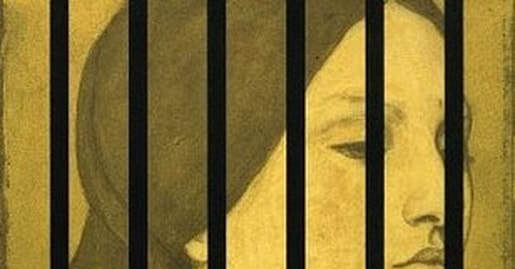
 The premise of Alias Grace is chilling. Not because it involves murder, but rather how the elements of the story eerily echo the feminist struggles that was depicted in The Handmaid’s Tale. Unlike how Hulu depicted a dystopian society in which fertile women were enslaved to bare children, Netflix goes back in time, focusing solely on the treatment of woman in the mid 19th century. Framed in the form of an elliptical interrogation, Alias Grace opens in 1859, in Victorian Canada, where Grace Marks – a former household servant – has been imprisoned for the 1843 murder of her employer, Thomas Kinnear, and his housekeeper, Nancy Montgomery. The actual killer – or cohort – James McDermott, accuses Grace of using her wiles to manipulate him and mastermind the crime. Grace’s celebrity as a young accused murderer, attracts the attention of a doctor named Simon Jordan to question and hopefully save Grace from life imprisonment. But Simon and the rest of the viewers can’t help but wonder:
The premise of Alias Grace is chilling. Not because it involves murder, but rather how the elements of the story eerily echo the feminist struggles that was depicted in The Handmaid’s Tale. Unlike how Hulu depicted a dystopian society in which fertile women were enslaved to bare children, Netflix goes back in time, focusing solely on the treatment of woman in the mid 19th century. Framed in the form of an elliptical interrogation, Alias Grace opens in 1859, in Victorian Canada, where Grace Marks – a former household servant – has been imprisoned for the 1843 murder of her employer, Thomas Kinnear, and his housekeeper, Nancy Montgomery. The actual killer – or cohort – James McDermott, accuses Grace of using her wiles to manipulate him and mastermind the crime. Grace’s celebrity as a young accused murderer, attracts the attention of a doctor named Simon Jordan to question and hopefully save Grace from life imprisonment. But Simon and the rest of the viewers can’t help but wonder:Did she actually do it?
As the viewers get further and further into Grace’s story, they learn that a single woman at this point in time is either an innocent virgin or a deceptive whore. Both the novel and in the Netflix miniseries accurately portray how women were treated in the 1800’s, and the manners in which they needed to adapt to survive. While Grace at times seems like the innocent victim she claims to be, viewers catch glimpses of her more manipulative side. So is she actually fully innocent? Is she completely guilty? Or is she a little bit of both? Overall, there is no doubt that Grace is a complex character with many secrets. She is either a convincingly timid child, or a toughened inmate. And in a time when men abused their power over women, sometimes a little manipulation was what was needed just to get by. So if you’re in search of crafty women whose actions may or may not be justified by their crimes, there’s luckily no shortage of books for an engrossing topic like that. And after finishing watching Alias Grace, these women – just like Grace Marks – will seem ambiguous, but also absolutely mesmerizing.
(Note: My suggestion would be to watch The Handmaid’s Tale first before watching Alias Grace in order to compare the two shows).
#10: Burial Rites by Hannah Kent
 Based upon actual events, this fictional account tells the story of Agnes Magnúsdottir, the last person executed in Iceland in 1830. Agnes has already been convicted of the murder of Nathan Ketilson and Pétur Jónsson and condemned to death for her crime, along with her co-conspirators, Fridrik Sigurdsson and Sigga Gudmundsdóttir. As she awaits her execution, Agnes is housed at a farm in Kornsá, belonging to the District Officer, Jón and his family. At first the family in Kornsá is hostile around Agnes as she helps with the chores around the farm. It is there where she meets with her spiritual advisor, Tóti whom she tells her life story to him and her encounter with Nathan Ketilson on the farm. As her story unfolds, Nathan emerges as a manipulator and as a sexual predator. Agnes’s voice at times feels claustrophobic with tension. With a combination of the appalling Icelandic winter and the muggy conditions of the Kornsá farm, Burial Rites has a colder, more precise tone compared to Alias Grace. But like Atwood’s writing, Kent creates a striking character in Agnes. An ambiguous and perplexing young woman who, even in the face of death, cannot be pinned down.
Based upon actual events, this fictional account tells the story of Agnes Magnúsdottir, the last person executed in Iceland in 1830. Agnes has already been convicted of the murder of Nathan Ketilson and Pétur Jónsson and condemned to death for her crime, along with her co-conspirators, Fridrik Sigurdsson and Sigga Gudmundsdóttir. As she awaits her execution, Agnes is housed at a farm in Kornsá, belonging to the District Officer, Jón and his family. At first the family in Kornsá is hostile around Agnes as she helps with the chores around the farm. It is there where she meets with her spiritual advisor, Tóti whom she tells her life story to him and her encounter with Nathan Ketilson on the farm. As her story unfolds, Nathan emerges as a manipulator and as a sexual predator. Agnes’s voice at times feels claustrophobic with tension. With a combination of the appalling Icelandic winter and the muggy conditions of the Kornsá farm, Burial Rites has a colder, more precise tone compared to Alias Grace. But like Atwood’s writing, Kent creates a striking character in Agnes. An ambiguous and perplexing young woman who, even in the face of death, cannot be pinned down. #9: Gone Girl by Gillian Flynn
 The first part of the novel centers around Nick Dunne and his wife Amy’s marriage. According to Nick, on the morning of their fifth anniversary, Nick wakes up to find that Amy has disappeared from their home in North Carthage, Missouri. As the days pass with no sign of Amy, the police and the media position their attention on Nick as the sole suspect for murder. The narration shifts when Amy chronicles her relationship with Nick through past diary entries, describing how her and Nick’s seemingly charmed romance begins to deteriorate. As the evidence against Nick continues to pile up against him, Nick continues to deny that he had any involvement with Amy’s disappearance. Yet, as the police find more and more clues to Amy’s disappearance, Nick becomes increasingly concerned that Amy knew more about some of his secrets than she let on. As a result, he tries not to reveal that his marriage was troubled or any other details that might implicate him. But did he actually have a hand in Amy’s disappearance? Just like Alias Grace, we get interesting scraps of information from the main characters. We think we know and understand them, until something comes out of left field to unhinge it all.
The first part of the novel centers around Nick Dunne and his wife Amy’s marriage. According to Nick, on the morning of their fifth anniversary, Nick wakes up to find that Amy has disappeared from their home in North Carthage, Missouri. As the days pass with no sign of Amy, the police and the media position their attention on Nick as the sole suspect for murder. The narration shifts when Amy chronicles her relationship with Nick through past diary entries, describing how her and Nick’s seemingly charmed romance begins to deteriorate. As the evidence against Nick continues to pile up against him, Nick continues to deny that he had any involvement with Amy’s disappearance. Yet, as the police find more and more clues to Amy’s disappearance, Nick becomes increasingly concerned that Amy knew more about some of his secrets than she let on. As a result, he tries not to reveal that his marriage was troubled or any other details that might implicate him. But did he actually have a hand in Amy’s disappearance? Just like Alias Grace, we get interesting scraps of information from the main characters. We think we know and understand them, until something comes out of left field to unhinge it all.#8: In the Woods by Tana French
 In 1984, in the charming little town of Knocknaree, Ireland, three kids went into the woods, and only one of them came back alive. Two decades later, another girl is found dead in the woods. And – coincidentally – the lead detective on the case, Rob Ryan, is the surviving boy who escaped from the woods twenty years ago. Rob has no memory about the day his friends went missing. The only thing he knows is that he emerged from the woods wearing nothing but a torn t-shirt and bloody sneakers. With his partner, Cassie Maddox, he and Cassie investigate the murder of the girl, Katy Devlin. But who would want to kill this twelve-year-old girl with a passion for dance? Could it be her father, Jonathan, who has a sketchy past? Mark, the archeologist who seems just a little too attached to the woods? Was it the mysterious man in a tracksuit who was seen at the crime scene by Damien, another archeologist, and Jessica, Katy’s twin sister? Or was it Sandra? As Rob and Cassie delve deeper and deeper into the case, Rob tries to remember what happened those twenty years ago, only for his repressed memories to come up with an unexpected clue.
In 1984, in the charming little town of Knocknaree, Ireland, three kids went into the woods, and only one of them came back alive. Two decades later, another girl is found dead in the woods. And – coincidentally – the lead detective on the case, Rob Ryan, is the surviving boy who escaped from the woods twenty years ago. Rob has no memory about the day his friends went missing. The only thing he knows is that he emerged from the woods wearing nothing but a torn t-shirt and bloody sneakers. With his partner, Cassie Maddox, he and Cassie investigate the murder of the girl, Katy Devlin. But who would want to kill this twelve-year-old girl with a passion for dance? Could it be her father, Jonathan, who has a sketchy past? Mark, the archeologist who seems just a little too attached to the woods? Was it the mysterious man in a tracksuit who was seen at the crime scene by Damien, another archeologist, and Jessica, Katy’s twin sister? Or was it Sandra? As Rob and Cassie delve deeper and deeper into the case, Rob tries to remember what happened those twenty years ago, only for his repressed memories to come up with an unexpected clue.#7: The Silent Wife by A.S.A Harrison
 The Silent Wife is a tale of a long-term relationship gone bad with no possible way of fixing it. Jodi Brett and Todd Gilbert have been together for twenty years, but Todd’s infidelity lead to the demise of his relationship with Jodi. Todd has been unfaithful throughout his relationship, but Jodi has managed to look the other way in order to maintain the upscale lifestyle to which she has become accustomed to in their Chicago highrise. But when Todd’s latest indiscretion becomes pregnant, Todd leaves the well-ordered home he has shared with Jodi to live in an apartment with his now expecting mistress. When Todd’s lawyer orders Jodi to vacate the condo, Jodi is in disbelief that Todd would be capable of removing her from the home and life they shared for so many years. But when one of Jodi’s friends offers to assist her for a price, Jodi can’t help but be tempted by the proposal for revenge against Todd.
The Silent Wife is a tale of a long-term relationship gone bad with no possible way of fixing it. Jodi Brett and Todd Gilbert have been together for twenty years, but Todd’s infidelity lead to the demise of his relationship with Jodi. Todd has been unfaithful throughout his relationship, but Jodi has managed to look the other way in order to maintain the upscale lifestyle to which she has become accustomed to in their Chicago highrise. But when Todd’s latest indiscretion becomes pregnant, Todd leaves the well-ordered home he has shared with Jodi to live in an apartment with his now expecting mistress. When Todd’s lawyer orders Jodi to vacate the condo, Jodi is in disbelief that Todd would be capable of removing her from the home and life they shared for so many years. But when one of Jodi’s friends offers to assist her for a price, Jodi can’t help but be tempted by the proposal for revenge against Todd.#6: Cartwheel by Jennifer duBois
 Just like the Amanda Knox case, Cartwheel is a suspenseful and haunting novel of an American foreign exchange student arrested for murder. When Lily Hayes arrives in Buenos Aires for her semester abroad, she is instantly enchanted by everything she encounters: the buildings, the food, but especially the handsome, elusive man next door. Nothing was going to stop Lily from having the time of her life, not even her boring American roommate Katy. But then five weeks into her study abroad program, Katy is found brutally murdered in their shared home. In between the revealing deceptions and the suspicious evidence of DNA, Lily is the prime suspect in the eyes of the media, her family and even in the man who seeks her conviction. So who exactly is Lily Hayes? And what happened to her roommate? No two readers will ever agree.
Just like the Amanda Knox case, Cartwheel is a suspenseful and haunting novel of an American foreign exchange student arrested for murder. When Lily Hayes arrives in Buenos Aires for her semester abroad, she is instantly enchanted by everything she encounters: the buildings, the food, but especially the handsome, elusive man next door. Nothing was going to stop Lily from having the time of her life, not even her boring American roommate Katy. But then five weeks into her study abroad program, Katy is found brutally murdered in their shared home. In between the revealing deceptions and the suspicious evidence of DNA, Lily is the prime suspect in the eyes of the media, her family and even in the man who seeks her conviction. So who exactly is Lily Hayes? And what happened to her roommate? No two readers will ever agree. #5: The Passenger by Liza Lutz
 Lisa Lutz’s acclaimed thriller begins with a woman on the lamb after her husband’s body is found at the base of the stairs. Did she really do it? It’s hard to tell until the final pages. All the reader knows is that Tanya DuBois doesn’t exist. At least not anymore. As “Tanya” watches her life recede into the rearview mirror, we know that she has gone by many alias: Amelia Keen, Debra Maze, Emma Lark, Sonia Lubovich, or a girl called only Jo. She is known as “Amelia” when she meets Blue, another woman with a life similar to her own. But their pasts and futures clash as the body count rises around them. Lutz does a fantastic job capturing Tanya’s fragility hidden underneath her tough exterior. By creating a trust between the narrator and the reader, there is something about Tanya’s character that forces the readers to view her in an unlikely favorable light.
Lisa Lutz’s acclaimed thriller begins with a woman on the lamb after her husband’s body is found at the base of the stairs. Did she really do it? It’s hard to tell until the final pages. All the reader knows is that Tanya DuBois doesn’t exist. At least not anymore. As “Tanya” watches her life recede into the rearview mirror, we know that she has gone by many alias: Amelia Keen, Debra Maze, Emma Lark, Sonia Lubovich, or a girl called only Jo. She is known as “Amelia” when she meets Blue, another woman with a life similar to her own. But their pasts and futures clash as the body count rises around them. Lutz does a fantastic job capturing Tanya’s fragility hidden underneath her tough exterior. By creating a trust between the narrator and the reader, there is something about Tanya’s character that forces the readers to view her in an unlikely favorable light.#4: Moral Defense by Marcia Clark
 In the second book in the Samantha Brinkman series written by Marcia Clark (yes, you read that right. That Marcia Clark, from the O.J. Simpson trial), Samantha is not concerned about guilt or innocence. Her prime interests is making sure that her clients walk. She understands that a crime can sometimes be committed for personal reasons, business reasons, pleasure or justice. Whatever the reason, Samantha’s duty is to keep her clients free. In Moral Defense, a personal chord is struck when she meets Cassie Sonnenberg, an adopted teenager accused of fatally stabbing her brother and father and accused of being responsible for her mother clinging to life in the hospital. Suddenly, Sam is facing her biggest challenge yet. And as it turns out, the maybe-murder and her attorney have more in common than Sam ever could have imagined.
In the second book in the Samantha Brinkman series written by Marcia Clark (yes, you read that right. That Marcia Clark, from the O.J. Simpson trial), Samantha is not concerned about guilt or innocence. Her prime interests is making sure that her clients walk. She understands that a crime can sometimes be committed for personal reasons, business reasons, pleasure or justice. Whatever the reason, Samantha’s duty is to keep her clients free. In Moral Defense, a personal chord is struck when she meets Cassie Sonnenberg, an adopted teenager accused of fatally stabbing her brother and father and accused of being responsible for her mother clinging to life in the hospital. Suddenly, Sam is facing her biggest challenge yet. And as it turns out, the maybe-murder and her attorney have more in common than Sam ever could have imagined.#3: The Girl Before by Rena Olsen
 When Clara is ripped from her husband and daughters as law enforcement raids their home – and told by her husband to keep her mouth shut – Clara finds herself depressed and in denial of the reason for her arrest. Initially, Clara refuses to cooperate – she insists that her marriage has been defined by love, rather than control and refuses to accept any information to the contrary. Through flashbacks, the readers are introduced to what appears to be a finishing school, where young girls are isolated from men and taught obedience and various “womanly arts,” or face violence or expulsion. The psychological manipulation, and Clara’s memories all contribute to a heart-rending description of a “good-girl” who, though behaving as she is told to her atrocious milieu, becomes guilty of unspeakable acts. Clara deludes herself into believing that the rules that govern her world are justified, and can only be obeyed. Yet, the more Clara finds out about herself, the more it becomes possible that the past could ruin her life as she knows it.
When Clara is ripped from her husband and daughters as law enforcement raids their home – and told by her husband to keep her mouth shut – Clara finds herself depressed and in denial of the reason for her arrest. Initially, Clara refuses to cooperate – she insists that her marriage has been defined by love, rather than control and refuses to accept any information to the contrary. Through flashbacks, the readers are introduced to what appears to be a finishing school, where young girls are isolated from men and taught obedience and various “womanly arts,” or face violence or expulsion. The psychological manipulation, and Clara’s memories all contribute to a heart-rending description of a “good-girl” who, though behaving as she is told to her atrocious milieu, becomes guilty of unspeakable acts. Clara deludes herself into believing that the rules that govern her world are justified, and can only be obeyed. Yet, the more Clara finds out about herself, the more it becomes possible that the past could ruin her life as she knows it.#2: Luckiest Girl Alive by Jessica Knoll
 As Ani relives the trauma of her freshmen year of high school, she begins to realize some parts of her life were not best for her even though they seemed perfect on the surface. At her affluent school, Ani wanted to be part of the popular crowd. Just when she thinks her dreams are coming true when she gets invited to a party, three boys, Peyton, Liam and Dean, get her drunk and sexually assault her. Still struggling to be accepted by the crowd, Ani refuses to report the rape. As Ani enters adulthood, she discovers that her fiancé, Luke was not the person whom she thought he was. Luke does not believe Ani had been raped. Furthermore, he also doesn’t believe that Ani should participate in an upcoming documentary about her old high school. But in a twist, the readers learns that the subject of the documentary is about a mass school shooting that happened when Ani was a student. What happened? And does it all connect back to Ani on that one fateful night?
As Ani relives the trauma of her freshmen year of high school, she begins to realize some parts of her life were not best for her even though they seemed perfect on the surface. At her affluent school, Ani wanted to be part of the popular crowd. Just when she thinks her dreams are coming true when she gets invited to a party, three boys, Peyton, Liam and Dean, get her drunk and sexually assault her. Still struggling to be accepted by the crowd, Ani refuses to report the rape. As Ani enters adulthood, she discovers that her fiancé, Luke was not the person whom she thought he was. Luke does not believe Ani had been raped. Furthermore, he also doesn’t believe that Ani should participate in an upcoming documentary about her old high school. But in a twist, the readers learns that the subject of the documentary is about a mass school shooting that happened when Ani was a student. What happened? And does it all connect back to Ani on that one fateful night?#1: In the Blood by Lisa Unger
 Lana Granger has told many lies about where she comes from and who she is that the truth is cloudy. With a few months to go until she graduates from college, but with her trust fund almost tapped out, Lana takes a job babysitting a troubled boy named Luke. Luke is manipulative, and is accustomed to controlling the people in his life. But in Lana, he might’ve just met his match. Or has Lana met hers? When Lana’s friend, Beck mysteriously disappears, Lana resumes her lying ways – to friends, to the police and to herself. But the police have a lot of questions for Lana when the story about her whereabouts the night Beck disappeared doesn’t match with the eyewitness accounts. Lana would do anything to hide from the truth, but it might not be enough. Especially if someone else knows about Lana’s lies and is dying to reveal them.
Lana Granger has told many lies about where she comes from and who she is that the truth is cloudy. With a few months to go until she graduates from college, but with her trust fund almost tapped out, Lana takes a job babysitting a troubled boy named Luke. Luke is manipulative, and is accustomed to controlling the people in his life. But in Lana, he might’ve just met his match. Or has Lana met hers? When Lana’s friend, Beck mysteriously disappears, Lana resumes her lying ways – to friends, to the police and to herself. But the police have a lot of questions for Lana when the story about her whereabouts the night Beck disappeared doesn’t match with the eyewitness accounts. Lana would do anything to hide from the truth, but it might not be enough. Especially if someone else knows about Lana’s lies and is dying to reveal them. So, do you think you know what happens? Only way to find out is the read the books!

Published on November 27, 2017 17:57
October 16, 2017
Mount Holyoke Ghost Stories
Every college as at least one or two ghost stories that resonates with the students on campus. Stories of suicides, murders or sudden disappearances that don't quite leave the confines of the college grounds. They are stories like these that explain the unexplainable. At my old college, Mount Holyoke, one story went a little something like this: 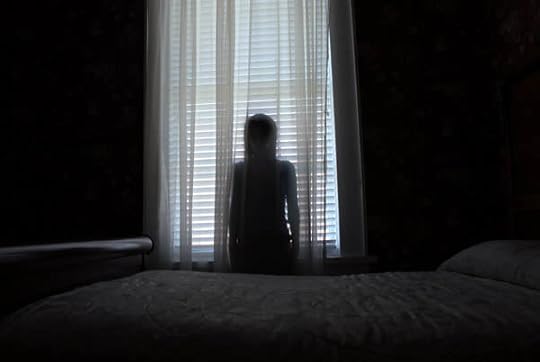 Sometime during her spring semester at Mount Holyoke, a young student learned that she would not be graduating with her fellow classmates. She was a senior and had become very distraught when she had discovered that she had failed all four of her exams. Her parents couldn’t afford another semester of college. They had spent all of their life savings to send their only child to receive a good education all the way out in Western Massachusetts. And what they got in return, was nothing.
Sometime during her spring semester at Mount Holyoke, a young student learned that she would not be graduating with her fellow classmates. She was a senior and had become very distraught when she had discovered that she had failed all four of her exams. Her parents couldn’t afford another semester of college. They had spent all of their life savings to send their only child to receive a good education all the way out in Western Massachusetts. And what they got in return, was nothing.
Driven by stress and by guilt, the night before what should’ve been her graduation, the student went outside and crossed the tiny wooden bridge above the waterfall of Lower Lake. Today, the bridge is known as Spider Bridge because (as it’s name suggests) it was always crawling with spiders.
The student, perched herself up on the ledge and tied a rope around her neck. But not before drawing out a knife and plunging the blade straight through her chest. Of course – as the logic of physics would have it – she fell.
Later that night, another student walked across the bridge to return to her dorm when she heard a voice saying, “Help me! I’m down here.” Naturally, the student looked over the bridge and saw the bloody and strangled body. The suicidal student’s icy toes dangling just above the water beneath her.
When the student called the police, they cut the rope and dragged her body back to the bridge. However, when the student recounted hearing the words, “I’m down here,” the police gave her a grave look. The body, it turned out, had been hanging over the bridge for more than an hour.
To this day, every night during finals week in the spring, some students have claimed to see The Lady of Lower Lake, swinging from the bridge or even heard her whisper “I’m down here,” as students cross the bridge during the late hours of the night. That story was told to me when I was a First Year student going in for my first ever college exams. It’s a story that had been repeated by the upperclassmen to warn the First Year students not to give into the stress and turmoil that finals week can sometimes inflict upon a person’s mentality. As someone like myself who has a fear of taking (really) important exams, the story stuck with me.
That story was told to me when I was a First Year student going in for my first ever college exams. It’s a story that had been repeated by the upperclassmen to warn the First Year students not to give into the stress and turmoil that finals week can sometimes inflict upon a person’s mentality. As someone like myself who has a fear of taking (really) important exams, the story stuck with me.
Thankfully, you can rest easy at night, because the story is unequivocally false. It was a story that was easily debunked since there were no records that exist of this outrageous account actually taking place. It was just a myth.
But myth or not, the stories like The Lady of Lower Lake had grown legs (if you will) and had begun to creep and manifest into the minds of the students at Mount Holyoke. And can you blame us for growing so close with these implausible stories?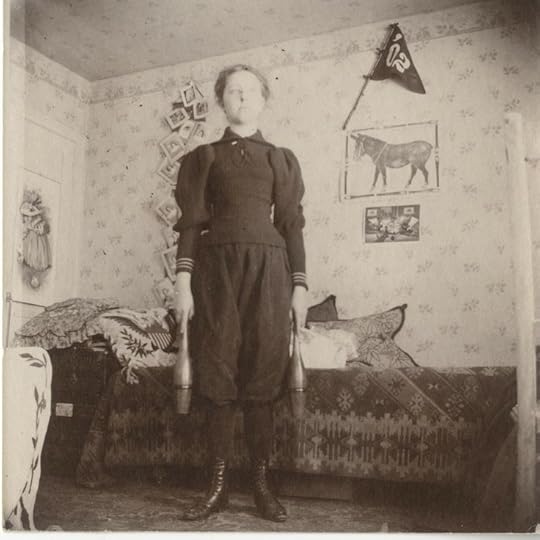 Susan B. Cole, class of 1902, practices gymnastics. Mount Holyoke College, 1902. Photographer Unknown. Mount Holyoke College Archives. Mount Holyoke was a college built in 1837, a year that was thriving on old-world superstitions and simple answers. Mount Holyoke, just like every school, was a constant thread, tying every students together. All philosophy aside, these stories were born out of the stress students underwent and shared when they left home or felt out of place at their new institution. Tales that were passed down from student to student because they were straightforward answers to the complex feelings of emotions that everyone had while on campus. Just like how the lesson The Lady of Lower Lake taught students to never give into the “stress culture” of finals week, stories like The Woman in White examined the extremes of heartbreak, or how The Portrait of Mary Mandelle heeded warnings of tampering with things that should be left alone.
Susan B. Cole, class of 1902, practices gymnastics. Mount Holyoke College, 1902. Photographer Unknown. Mount Holyoke College Archives. Mount Holyoke was a college built in 1837, a year that was thriving on old-world superstitions and simple answers. Mount Holyoke, just like every school, was a constant thread, tying every students together. All philosophy aside, these stories were born out of the stress students underwent and shared when they left home or felt out of place at their new institution. Tales that were passed down from student to student because they were straightforward answers to the complex feelings of emotions that everyone had while on campus. Just like how the lesson The Lady of Lower Lake taught students to never give into the “stress culture” of finals week, stories like The Woman in White examined the extremes of heartbreak, or how The Portrait of Mary Mandelle heeded warnings of tampering with things that should be left alone.
It’s no wonder that these stories refused to stay buried, even when they have been proven to have been debunked. Stories like The Lady of Lower Lake still has one foot in our world. And the only thing keeping that story and the other countless ghost tales that we had heard during our years at Mount Holyoke, is us. By retelling the stories, over and over again, they grow roots and feel more real than ever.
So with Halloween just around the corner, I will be sharing a few Mount Holyoke's ghosts stories with you.
Hopefully, you’re not reading this at night.
The Lakeside Insane Asylum In 1949, a building was built just on the outskirts of Mount Holyoke. It wasn’t a dorm, nor did it share any association with the neighboring college campus. Instead, this particular building was privately owned by the state of Massachusetts and appropriately named, Lakeside since it resided just near Upper Lake. To put simply, Lakeside was a mental hospital, full of sick people in need of help.
In 1949, a building was built just on the outskirts of Mount Holyoke. It wasn’t a dorm, nor did it share any association with the neighboring college campus. Instead, this particular building was privately owned by the state of Massachusetts and appropriately named, Lakeside since it resided just near Upper Lake. To put simply, Lakeside was a mental hospital, full of sick people in need of help.
The hospital was designed to house 122 patients, covering a wide spectrum of mental illnesses who were served by a team of one dozen staff. It had four floors and a glass covered mezzanine in the attempt to expose more patients to sunlight in the hopes of a quicker recovery. But frequently, the patients were only offered pain and suffering.
Before the days of institutional care for the mentally ill – this was the late 40’s / early 50’s after all – the jobs at Lakeside were mostly left largely to independent contractors. People who were hired, by the state, to look after others. That was a system with too many opportunities for abuse. The patients at Lakeside were routinely placed in cages or stalls for long isolated periods. They were even chained and beaten into submission. Violence and death were everyday occurrences at Lakeside. The blame was pointed to decreased state funding, but that didn’t justify the staff’s inhumane treatment of its patients.
With a mental hospital so close to the college campus, the students at Mount Holyoke would on occasion hear the screams of terror from the patients on their way to class. Worse, some of the patients who occupied the rooms of Lakeside were former Mount Holyoke students. Students who had a sudden severe mental breakdown, were forced by the college to be shipped off to Lakeside for a few nights of treatment. But those few nights always turned into years. The former Mount Holyoke students (now Lakeside patients) would regularly be subjected to hydrotherapy and electroshock therapy. And yet, they never got better.
The horrors of Lakeside ended in 1954, when the drug Thorazine was introduced and was marketed as a chemical lobotomy for mental patients. The number of patients at Lakeside dropped dramatically, and soon, the hospital closed its doors in 1956. The state of Massachusetts, donated building to the Mount Holyoke campus and the school turned it into a dorm, renaming it Torrey Hall, in honor of Louisa Torrey (class of 1845), who was the mother of former president William Howard Taft. But the nightmare didn’t stop when the building was open for students to move in.
Reports began to filter out of hearing a woman sweeping up and down the hall, or sounds of whistling or humming reverberating against the walls of the basement. One account said that a student and her roommate were both asleep when they were awoken by a man’s loud laughter in their room. But there was no one there.
The rooms that once played host to the mindless victims of the staff and doctors at Lakeside became the home of newly arrived Mount Holyoke students. They built their lives around the glass covered mezzanine, the dining hall and the bathrooms. They were probably the healthiest inmate population the building had known for years.
The Starving Student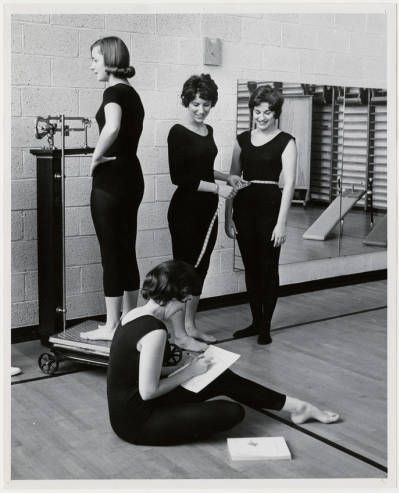 The year was 1967 and she was living in 1837 Hall, overlooking Lower Lake. The girl was a First Year, and her parents had high hopes for her marry a prominent young man from either Amherst or Dartmouth by the end her senior year. Once the girl moved in, her mother stayed in South Hadley for a little while, getting her settled, signing her up for a couple of courses to better hone her homemaking skills, and accompanying her to her first soirée with eligible men from around the Pioneer Valley. Everything was going exactly as planned . . . until it wasn’t.
The year was 1967 and she was living in 1837 Hall, overlooking Lower Lake. The girl was a First Year, and her parents had high hopes for her marry a prominent young man from either Amherst or Dartmouth by the end her senior year. Once the girl moved in, her mother stayed in South Hadley for a little while, getting her settled, signing her up for a couple of courses to better hone her homemaking skills, and accompanying her to her first soirée with eligible men from around the Pioneer Valley. Everything was going exactly as planned . . . until it wasn’t.
At the soirées no men found the girl attractive, and the girls on her floor were talking constantly about the latest dieting fad. The girl became convinced that her unattractiveness resided with her weight. She called her mom and told her these fears. Her mother on the other hand, added to her daughter’s distress. Well, she was enrolled at a prestigious all-women’s college, a competitive market if one wanted to mingle and breed with the right kind of people. This only brought on more pressure about the girl’s appearance. So, she suddenly, stopped eating.
“Come eat with us!” The girls on her floor would try and coax her. But she declined. The girl refused to eat. She ate nothing that day, and nothing the next night. She claimed to have already eaten breakfast before leaving to go to class. And she would purposely fall asleep through her lunch period. The other girls on her floor could feel the stress coming off of her, palpable and terrifying. Nobody acknowledge any of this, at least not aloud. Anorexia was a mental disorder after all. But nobody dared to be involved in something they themselves could not quite yet understand. All at once, the girls on her floor, stopped socializing with her. Sure enough, the girl gradually grew skinnier and skinnier. The change was obvious.
Before, according to her neighbor, she was lithe and glowing. But a month later, she was gaunt. Her eyes looking sunken into her face, her head too big for her body, weighing her neck down and her skin was turned to an ashen pale. The fat on her wrists had receded to thin knobby sticks and all the tendons in her neck bulged like puppet strings whenever she turned her head. She looked . . . brittle.
A week before the Thanksgiving break, the girl’s neighbor invited her to come home with her for the holiday. She had taken pity on the girl and thought that maybe a homecooked meal and a plump turkey might make her look more lively. But when she knocked on the girl’s door. There was no answer. Three days went by. The neighbor figured that maybe the girl had already left with another student for the Thanksgiving Break. So the neighbor packed up and left to join her family.
After a long week back home full of pumpkin pies and stuffings, the neighbor returned back to 1837 Hall, but noticed that the girl’s door was still closed. The other residents on the fifth floor became curious about the girl’s whereabouts. As far as they knew, the girl didn’t go home with anybody for the Thanksgiving Break. By Monday, the girl’s door was still closed. One girl reasoned that she had went home early and missed the last bus to take her back to Mount Holyoke. By Tuesday, the door was still shut closed. Wednesday, still nothing. Finally, by Thursday, the girls on the floor began to worry.
On Friday night, the girls of the fifth floor woke up their House Mother who got the spare key to the girl’s room. So the House Mother headed upstairs, the girls following behind her. Once at the door, the House Mother fit the key in the lock and turned it open.
The girl was lying on top of her bed, her cheek pressed against her pillow. She was curled up, and completely naked. It was the very sight of her that terrorized both the girls and the House Mother. The girl, was all bones and knobs. Every bump in her spine protruding and visible. Her hips poked out at odd angles and her knees were skinny and pale. And the sharpness of her her shoulder blades rose out of her skin like the wings of a baby bird. She had died. Starved herself.
1837 Hall sealed off her room for three years before reopening it again. But her presence, no matter how thin she had spread herself, had somehow filled up the entire fifth floor of that dorm. Over the years, students had recognized seeing her in their room, reporting that a woman “wrath-looking” would be staring right back at them. Despite the fact that she had died in her old room, the most activity to be reported on the fifth floor was actually the bathroom. This actually made sense since she was found naked, and the bathroom was likely the only place for her to purge any meals she may have eaten while suffering from her disorder. One student claimed to have woken up at 3 AM, gone to the bathroom on the fifth floor, and as she was washing her hands, looked up and saw the thin woman gazing right back at her.
The Pearsons' Murders There are two structures on campus that are both named Pearsons. There’s the dorm, Pearsons Hall, and then right next to it is Pearsons Annex, a building that is suppose to actually be older than Pearsons Hall. The administration believed that it was built before 1810 and was known in South Hadley as the “Brick Store.” The college had purchased it and converted it into a First Year house, bestowing the name given to the dorm next door. Throughout the years it had housed multiple undergraduates, and today, it houses the Frances Perkins scholars.
There are two structures on campus that are both named Pearsons. There’s the dorm, Pearsons Hall, and then right next to it is Pearsons Annex, a building that is suppose to actually be older than Pearsons Hall. The administration believed that it was built before 1810 and was known in South Hadley as the “Brick Store.” The college had purchased it and converted it into a First Year house, bestowing the name given to the dorm next door. Throughout the years it had housed multiple undergraduates, and today, it houses the Frances Perkins scholars.
However, before Pearsons’ Annex was adopted by the school, the owner of the Brick Store lived there with his wife and child. Both were young and recently married. They had immigrated to the US to escape the hardships that had befallen them in their home country of Ireland. But the wife had come from a very superstitious family. Her ancestors had believed in fairy folklore, mostly stories about fairies substituting one of their own for a kidnapped human adult or child. A challenging, if you will. And this wife took this fairy folklore very seriously.
And her logic was simple: If a child was born sickly or ill-tempered, they were often thought to be a fairy substitute, left behind when their real child was taken from their home. Or if an adult went missing and suddenly turned up again, people would often assume that they had been swapped with a fairy that looked, sounded and spoke exactly like their loved one. And the over-well being of the wife’s family was hinged on the knowledge of these changeling creatures.
It started when the wife found out her husband was having an affair with a woman in town. This was a sign, to the woman at least, that her beloved husband had been swapped by a changeling. He had been showing the symptoms of what she had been taught to recognize a changeling. Lately, her husband had been suffering from mood-swings, becoming more argumentative and had lost complete and utter interest in spending time with his friends outside of work. Worse, she had started to suspect even her own baby of being a changeling. The baby never stopped crying and always seemed to have an enormous appetite. An obvious sign – to her, at least – that the baby she was carrying for, wasn’t her baby at all.
One rainy night, the woman’s husband left home on an errand. There was no doubt that this so-called “errand” was really an excuse to meet with his mistress. But later that evening when he had returned, things took a turn for the worst. Upon entering his home, he had discovered a pool of blood in the middle of the kitchen floor, leading up to the sink. As he slowly approached the basin of the sink, he saw the small pink body of his child, dead with it’s tiny throat slit open. That’s when he heard the floorboards creaking behind him. He turned, just in time to see his wife charging at him with a butcher knife. The blade, already bloody from its first kill. She tackled her husband to the floor.
“You’re not my husband! You’re not my husband!” She cried over and over again as she held his face in front of the burning fireplace while holding the butcher blade to his throat. She demanded that her husband state before God that he was indeed her husband and not a changeling. But even though the husband answered yes, his wife did not believe him. His wife was convinced that if she killed him, just like how she killed the child she had believed to be the changeling, then both her real baby and her devoted husband would come home. Again, she pressed the blade of the knife a little deeper against her husband’s throat, and demanded that he declare his identity.
But this time, her husband refused. He pushed his wife off and rolled on top of her. Caught off guard, the butcher knife slipped out of her hands, and her husband scrambled to grab it, before plowing the blade of the knife directly into the center of her chest. Both his child and his wife, were now both dead.
What happened next, can only be speculation. In one telling, the realization of his dead wife and child sent the husband mad. The neighbors had heard the screams next door and called the police. When the local authorities entered the house, they found the husband trembling by the dead bodies. He was taken to a mental institution, where he died thirty years later.
In another telling, the husband was so distraught by what he had done that he drowned himself in Lower Lake. Eventually, the Brick Store was sold to the school. But whatever horrific events had happened to both the husband and his child, the wife seemed to not have gone anywhere.
Having extended herself, her spirit had apparently reached the grounds of both Pearsons' buildings. One sophomore who lived in Pearsons Hall awoke to see that the light to her roommate’s closet had suddenly turned on, only to be aware of a dark female figure standing right next to the closet’s doors.
In her report, the sophomore claimed that just by looking at the figure, she could tell that she was rabid with anger. She kept making frequent visits again and again to the student’s room, glaring at her with menacing eyes or whirling her arms in the air as if to hit her. Or, more precisely, wielding a butcher knife at her.
The Portrait of Mary Mandelle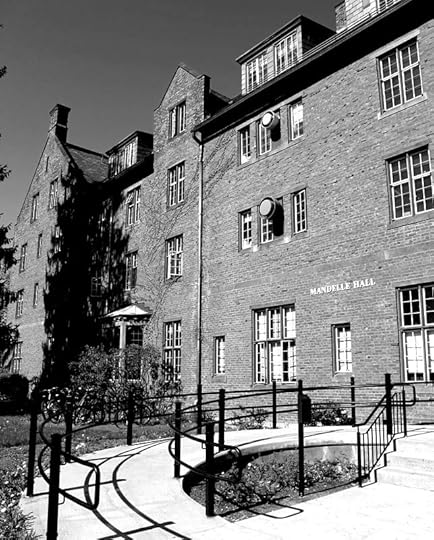 In 1951, something odd happened on the fourth floor of the South Mandelle’s Tower Room. A girl – that some people to this day have called “Matilda” – went up that room and ended her life. Her body was found the next day and taken away. None of the girls on the fourth floor knew why Matilda had suddenly decided to commit suicide. She never seemed in distress or upset. Overall, she had seemed perfectly normal. She got good grades, was social and had come from a wealthy family in Boston.
In 1951, something odd happened on the fourth floor of the South Mandelle’s Tower Room. A girl – that some people to this day have called “Matilda” – went up that room and ended her life. Her body was found the next day and taken away. None of the girls on the fourth floor knew why Matilda had suddenly decided to commit suicide. She never seemed in distress or upset. Overall, she had seemed perfectly normal. She got good grades, was social and had come from a wealthy family in Boston.
A group of girls on the fourth floor were puzzled by Matilda’s death. She had locked the door to the Tower Room behind her, and slashed her wrists with a knife she had stolen from the dining hall, ultimately bleeding to death. No suicide note was found. After the school locked off the Tower Room, that was when things started to get disquiet. The girls on the fourth floor began to hear sounds of someone wailing outside their doors in the middle of the night. But when they opened their doors, no one was there. One of the girls even woke up and saw the image of Matilda sitting in her chair across the room. Another claimed to have left the bathroom just as the lights above her flickered off, and the shadow of Matilda stood watching her at the end of the hallway.
The group of girls on the fourth floor all agreed that these sightings of Matilda were strange. They didn't know how to explain Matilda’s appearance to their House Mother nor any of their friends, but something had to be done. One of the girls suggested to perform a seance in an attempt to communicate with Matilda. She believed that if they could reach out between the curtain of life and death and feel for something tangible that might’ve explained Matilda’s suicide, she might leave the girls alone and find some peace.
So in the late hour of the night, the girls conducted their own seance right in the common room of the North Mandelle’s. Why the North Mandelle’s common room instead of the South Mandelle’s? Because the North Mandelle’s common room had an activate fireplace, and it was the chosen common room that they knew Matilda liked to spend the most time in before her untimely death.
Side note: What made the North Mandelle common room interesting, was that hanging just above the fireplace was a portrait of Mary Mandelle, one of the biggest donors to the college. I’ll get to her in a second. Because, even though this random portrait of a Mount Holyoke donor might seem like a random diverge from the story, it isn’t.
Anyway, as the girls were gathered in a circle around the fireplace, holding hands, they called out a response from the spirit world. The girls reported a distant knocking, but nothing that indicated Matilda’s presence for the rest of that night. The girls decided to try it again the next night. But that was also when things started to escalate around the fourth floor of the South Mandelle’s. Later, details were reported of objects appearing out of thin air, and slowly moving across the room. Even the fireplace tools in the North Mandelle’s common room during the nightly seances were said to move around the common room on their own. Granted, these moving objects and knocking sounds were what the majority of the girls believed to be unmalicious activity. They just thought it was Matilda trying to communicate with them.
But then the physical attacks began. It started off at first as just pinches and slaps until it became more life threatening. One girl was awakened when she felt her pillow being pressed down against her face, and another girl suddenly felt a pair of hands throttling her throat. Both girls survived, but it became clear to the rest of the group of girls that Matilda – if that’s what it really was – was far from being benign. Books and clothes were thrown at the girls in their rooms during study period on multiple occasions. One girl even witnessed her roommate being thrown across their room. All by an unseen force. And much to the concern of the group of girls, the final straw was when one of them was dragged by their hair across the floor during a seance towards the licking flames of the fireplace. Thankfully, the girls had pulled her away in time, unharmed and put the fire out. But the threat was very real.
The girls became more and more frustrated, and began to shout to whoever was responsible for these attacks. They assumed it was Matilda, and they demanded her to stop. But she never did. As a final attempted to free themselves from whatever force was threatening them on the fourth floor, the group of girls decided to perform one last seance in the hopes to negotiate with Matilda to have the attacks stop. The seance began and according to the girls, the spirit identified itself. But it wasn’t Matilda. It was Mary Mandelle, the donor whose portrait had been watching them since the very first seance. But it was still unclear what Mary Mandelle wanted. The girls took a moment to plead with Mary to cease her haunting of them on the fourth floor but the spirit only laughed at them. What happened next was chilling.
The spirit had responded that she would never stop, not after the fun she had tormenting their friend Matilda. At the mention of their friend’s name, some other force moved around the room. The portrait of Mary Mandelle, they noticed, began to shake and rattle, finally tearing itself from the wall and landing into the fire. And then, everything went quiet. The knocking noises stopped, and the throwing of objects halted. All, was back to normal. But why?
A few days later, one of the girls did some background research at the library about Mary Mandelle. What she discovered, she later shared with the rest of the group of girls: Mary Mandelle had died four years earlier in Detroit, burnt alive from a house fire. Whatever had knocked down her portrait into the flames of the fireplace had severed the connection of the harm she was causing to the girls from beyond the grave.
And what exactly had knocked down Mary Mandelle’s portrait into the fireplace? A little after the last seance, the girls would recognize the ghostly image of their friend Matilda wandering the halls on the fourth floor. The girls could only guess that Matilda had been watching over them, and had been the one that saved them from Mary Mandelle’s presence in the common room.
While today, the fourth floor of the South Mandelle’s is relatively quiet, some slightly out-of-the-norm occurrences still happen on that floor. Matilda for one, is still up there, wandering the hallways. Some students have heard her slow-moving footsteps, others had watched her shadow creep under the crack of their door. As if making sure, that all is right.
The Wrath of Hannah Porter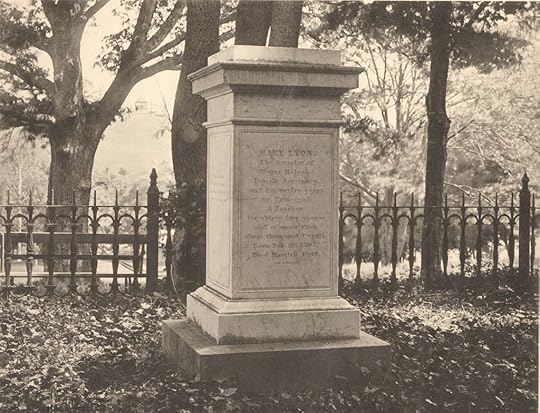 When Hannah Coleman married an older deacon from a wealthy family in 1827, she had no idea how important a role her husband would play in the establishment of Mount Holyoke College (back then, known as Mount Holyoke Female Seminary). So important, that it nearly drove her mad. Because as it turns out, Hannah wasn’t the only woman in her husband’s life.
When Hannah Coleman married an older deacon from a wealthy family in 1827, she had no idea how important a role her husband would play in the establishment of Mount Holyoke College (back then, known as Mount Holyoke Female Seminary). So important, that it nearly drove her mad. Because as it turns out, Hannah wasn’t the only woman in her husband’s life.
You see, her husband, Deacon Porter, was very good friends with another woman. The woman as it turns out was Hannah Coleman’s rival: Mary Lyon. For those who do not know who Mary Lyon is, she was the founder of the now established Mount Holyoke College in South Hadley, Massachusetts. And Hannah hated her.
This wasn’t the first time Hannah had a feud with another woman for her husband’s attention. In fact, prior to her marriage to the Deacon, the second woman that Hannah couldn’t stand had actually been dead for five years. The woman, was Deacon Porter’s first wife, Clara. And she despised her for the fact that her husband would accidentally call her by his first wife’s name on occasion. It was safe to say, that Hannah felt as if she were invisible around her husband. His mind was either focused on his former dead wife, or attending to the living and breathing Mary Lyon.
But what’s also important to note, is that shortly after his marriage to Hannah, it was said that Deacon Porter swore to his new bride that if she ever suspected him of ever being unfaithful, he would willingly eat his own hat. As Deacon Porter was away, aiding Mary Lyon in the construction of the school, things took a darker turn.
A rumor began to spread throughout the town of South Hadley that Mary and the Deacon were having an affair. Of course, the rumors were brought to Hannah’s attention and drove her more and more into an unfathomable jealous rage. And some historians think that this rumor was what sparked the vengeful blaze inside of her.
One document described how when Hannah suspected the affair, she invited Mary Lyon to dinner and served a steamed pudding that held a strange similarity to her errant husband’s stovepipe hat. And she did it, to see if her husband would actually eat it. If he did, it proved that he had been going behind her back with Mary. If not, well then the rumors weren’t true. And even though she was still unconvinced of her husband fidelity when he didn’t eat the pudding, Mary did and declared it to be delicious. So much so, that she would serve the dessert to her students in honor of the Porter’s contributions to the establishment of the school. Hannah was beyond furious. Her response was to accompany her husband everywhere he went, mainly to supervise his meetings about the school with Mary Lyon. Hannah was determined not to let her husband out of her sight.
When Mary Lyon passed away in 1849, she was buried in the middle of the school’s campus. Today, her grave has been the spot for ice cream socials and Laurel Parades. But there were theories that suggested that Mary Lyon’s body wasn’t buried on Mount Holyoke’s campus at all. There had been some debate as to where exactly her body had ended up being buried. Some sources had claimed that she was interred in a family cemetery in her hometown of Buckland, Massachusetts. Others swore, that her body had been carried away before her burial at Mount Holyoke to Wheaton College, the second school Mary Lyon had helped established. And probably the grimmest version of it all, was that Hannah Porter had ordered Mary Lyon’s body to be unearthed.
She had believed that after Mary’s death, her husband would finally give his full, undivided attention to her. But instead, she continuously found him on the Mount Holyoke campus grounds, paying his respects to Mary Lyon. Enraged, Hannah privately hired an associate to rally a group of Amherst students down the road to dig up the body of Mary Lyon. The orders were to sneak out onto the campus late in the night, excavate the grave, open her coffin and steal the body to be reburied in an unmarked grave on Amherst College’s campus. That way, at least, whenever her husband would be visiting Mary’s grave, Hannah would have the satisfaction of knowing that he would only be talking to an empty tomb.
However, Hannah Porter might’ve taken her actions too far. Years after Mary Lyon’s funeral and the alleged removal of her body, the influx of students enrolling at Mount Holyoke seemed to have begun reporting on a couple of mysterious occurrences. One student claimed that she had seen a figure standing in front of Mary Lyon's grave. Other students had felt an overwhelming sense of anger. Another student who was cheerful to start her first year at Mount Holyoke, took a walk through the campus after dinner only to return to her dorm shortly after telling her peers, “I never want to go near that tombstone, again.”
Noises had been heard throughout each of the first dorms established on the campus. Safford, Pearsons, and Brigham Hall. Knocking sounds, footsteps, and what sounded like the snapping of branches have all been reported by students. Compared to the three dorms on campus, a fourth dorm had claimed to be afflicted most by these unexplainable sounds. And that dorm was none other than Porter Hall, named aptly in honor of the contributions made by Deacon Porter no doubt. It seemed like Mary Lyon’s spirit – if it was her – had known who had removed her body from her grave, and seeked to wreak havoc on the students who were occupying the dorm named after her former rival.
The students living in Porter had heard what sounded like distant harsh voices of two women arguing with each other. And sometimes, the movement of furniture. Others have heard what they have described as a screaming woman, someone who is exercising rage and fury. Those who were familiar with the rumors of the rivalry, have assumed that it is Mary Lyon, fuming over her defiled body. A few have even seen the figure of an older woman wearing a mop cap and a black dress in various places in Porter, looking as if to strangle someone.
When both Deacon Porter and Hannah Porter passed away, both of their portraits were hung up in the common room of Porter Hall. And as if the only problem was the wandering spirit of Mary Lyon, something new had entered the atmosphere of Porter Hall as soon as both of those portraits were hung up. The portrait of Deacon Porter, was admired greatly by the students, yet Hannah’s portrait was unsettling. This time, rather than a second ghost occupying the residents of Porter Hall, the portrait of Hannah Porter seemed to almost be glaring at each of the students whenever they looked up at her frame. One student had looked into the eyes of Hannah Porter’s portrait for too long that she fell to the floor and went into an epileptic seizure. The student was carted away to the nearest hospital, but not before these epileptic episodes began happening more and more frequently in the Porter Hall common room. Evidently, news of these appalling seizures had reached the administration where they concluded to take down Hannah Porter’s portrait. Coincidentally, the seizures just also happened to stopped.
The Woman in White (or The Wilder Ghost)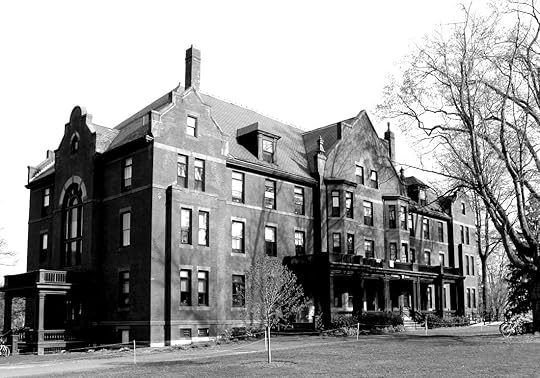 This is probably the most famous ghost story on Mount Holyoke’s campus.
This is probably the most famous ghost story on Mount Holyoke’s campus.
According to a popular Mount Holyoke legend, it started with the arrival of a woman back at the turn of the century. They say that this woman was extremely beautiful, and after a year studying at Mount Holyoke, she met a young man from Amherst College who was instantly captivated by her. The couple was always seen together on the college campus. She, having a smile on her face in his presence. And he, holding her lovingly close to him.
For an all-woman’s college during this time, witnessing a woman and her beau strolling together on the campus grounds wasn’t an unusual sight. It usually meant that an engagement would happen soon. Naturally, people talked. And that talk spread to conversations of excitement for the young couple. In an era when a woman’s duty was to find a suitable husband, it seemed like things were going well for the woman during her first three years at Mount Holyoke.
Then on April 6th, 1917, the United States declared war against Germany. Men, all across the US offered their services to the fight. And among them, the woman’s beau. While the woman was devastated to see her significant other go, he promised that he would return in time for her graduation ball by the end of her senior year, and marry her. A year later, in 1918, the beau was captured by Germans forces and taken to a reprisal camp in Ingolstadt where he was imprisoned.
These reprisal camps in Germany during the First World War were notorious for their unsanitary conditions and the diseases that went wild through the inmates. They were often located in regions where the climate or the terrain made life more difficult, and the prisoners were often kept in tents resting in mud.
Soon, during the evening of her graduation ball, the woman received word that her suitor had died while incarcerated in a German POW camp. She was dressed in her white gown from the Laurel Parade earlier that day. Grief consumed her, and she left the ball to return straight to her room on the fourth floor of Wilder Hall.
After a time, the woman’s peers became worried. Their friend hadn’t come back to rejoin them at the ball. And so, they made their way across the campus to Wilder Hall and asked the undergraduates inside if they had seen her. They climbed the steps up to the fourth floor and found her door slightly opened. When they pushed the door back, they discovered a grim sight.
Their friend, the woman, dressed in her white gown, was hanging by a noose from one of the rafters of her room. Dead. The body was taken back to the woman’s family. The woman and her beau were buried in their hometown cemetery. But due to burial customs of the time, they were not allowed to share the same plot. Instead, they were separated by forty feet. Close, but not close enough.
It sounds like the end of a tragic love story, and in some ways it is. The couple were never able to marry, and their young lives were cut short. But in other ways, the woman lived on. Interestingly enough, before her death, the woman’s parents, who were big donors to the college, commissioned to have a portrait to be painted of their daughter, dressed in her white gown. The painting had been completed a little over a week after the woman’s suicide. Unable to bear the sight of their once beloved child, the parents donated the portrait to the school, where it was then hung in the Wilder common room.
Then things started to get weird. According to some students, they thought the portrait of the woman in white was a morbid shire to the woman’s suicide. So they tried to take it down. Except, they couldn’t move it. They called the administration to remove the portrait, but the frame refused to come off the wall. As an alternative, the administration decided to cover up the portrait with a second portrait that’s still there to this day. That seemed to appease the students for a short time, until several reports were released about the the restless spirit on the fourth floor of Wilder Hall.
As the years went by, residents who had ended up living in the woman’s old dorm room, claimed to have seen a strange figure dressed in white. They say it’s the Wilder Ghost – the Woman in White – gliding into the room where she used to occupy. But this ghost, was seen apparently very often on the fourth floor. So often that it nobody wanted to sleep in her old room again.
The President of the college at the time had to deal with an overcrowded housing crunch that year and tried to prompt students to move into the eerie room on the fourth floor of Wilder. But there were no volunteers. The President, of course, had heard the tale of the Woman in White, and decided to prove the student's wrong about the ghost’s presence by sleeping in the room herself for a night. And the next day, the president had ordered the room to be boarded up and locked.
Nobody knew exactly what the President saw that night, but the students had an idea that the Woman in White had made her presence known to her. But even though today her room has finally been prohibited, many students still feel anxious living on the fourth floor of Wilder. Students say, you could hear voices murmuring on the fourth floor. When on rainy days or when the snow falls into sheets, the fourth floor inhabitants claim that you can hear something besides the claps of thunder or howls of the snowy winds. It’s the sound of a woman crying out in pain.
Rumors circulated about a second motivation for her suicide. In an alternative telling, the woman had gotten herself pregnant as she awaited her beau’s return. And instead of receiving a message declaring his death, it was a message declaring his return. So in an act of guilt and infidelity, the woman hung herself in her room before her beau could see her.
During the winter of 2006, there was a heavy storm that knocked over a large tree that had been in front of Wilder Hall. The tree had crashed into the building during that storm, caving the ceiling of the infamous haunted room. Thankfully, no one was injured, but the students wondered if maybe this event had released the ghost from Wilder.
Others have said, she is still there, waiting for her and her beau to be reunited, once more.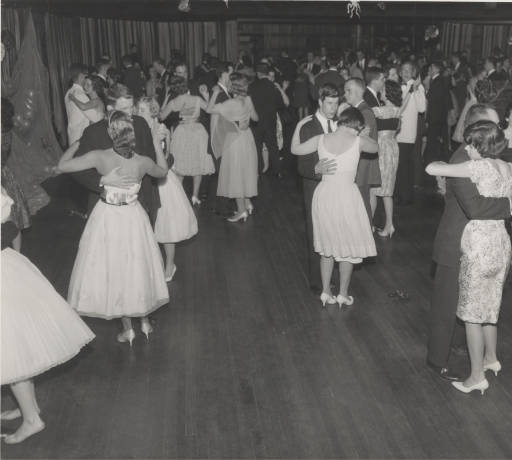 Fall semester of my senior year, I was living in Pearsons Hall. Some students have jokingly considered Pearsons to be a type of “off-campus” housing, since the dorm itself is located on a plot of land directly across the street from the main college campus. It housed 136 students on four floors and had two beautiful common rooms and a spacious dining room.
Fall semester of my senior year, I was living in Pearsons Hall. Some students have jokingly considered Pearsons to be a type of “off-campus” housing, since the dorm itself is located on a plot of land directly across the street from the main college campus. It housed 136 students on four floors and had two beautiful common rooms and a spacious dining room.
I really liked Persons. Despite the fact that I lived on the fourth floor, and the dorm itself didn’t have an elevator nor a dumbwaiter to help me carrying up my mini fridge up the narrow flights of stairs, it felt homey and comfortable. I still think about Pearsons as my home whenever I’m feeling nostalgic for the good-old college days.
I shot a short movie for my film class in the sunroom, served tea to my friends as we were studying for finals in the piano room, and hosted parties in the grand dining room that shared a fireplace and old love seats near the windows. My friend Sojie even once threw a toga party at Pearsons for her birthday. It was the place where I built and crafted my memories of senior year.
But I could only imagine how the students in 1897 felt about living in here. The well-worn carpets, the imperfect wallpaper, the noisy plumbing, the finicky lights and the sounds of a settling structure made me more and more curious about the previous occupants that used to roam throughout the dorm. Or any dorm on the Mount Holyoke campus for that matter. What stories were told behind those dorm walls? What events took place on the college grounds? Or how many ghosts have wandered these halls?
You will be happy to know that the seven stories that you had just read earlier, were all fictitious.
They were tales that we were told that got passed down from student to student in order to ensure our behavior on the college campus. Yet, there are some truth to those stories. We, as young undergraduates, had related to the characters and places so personally that we could almost sense a type of ghostly presence in the late hours of the night.
When we felt like we were about to lose our minds during a midterm or a final, we were reminded of The Lady of Lower Lake and The Lakeview Insane Asylum. When we found ourselves jumping too fast to conclusions, we were haunted by the telling of The Pearsons Murders. If it seemed like a student might be in distress or isolating themselves, then the story of The Starving Student comes to mind to motivate us to lend a helping hand. Opening a door that should’ve remained closed gave us frightening chills whenever we would remember the story of The Portrait of Mary Mandelle. We would often reevaluate our feelings of jealousy whenever we thought about The Wrath of Hannah Porter. And we weighed our broken hearts against the grief of The White Woman. These stories you see, kept us on our toes. And it’s only a matter of time before we create new stories and weave new narratives to the next wide-eyed undergraduates.
And soon, we ourselves, become the ghosts.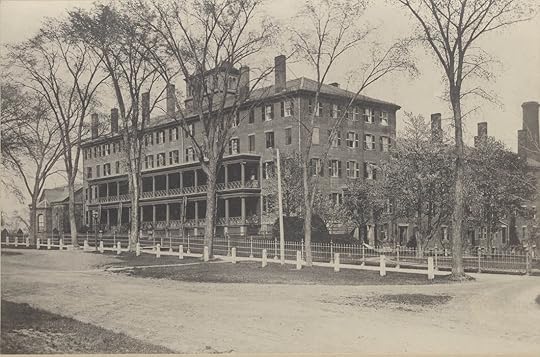 Sources:
Sources:
MHC Alumnae Association | Mount Holyoke College
http://alumnae.mtholyoke.edu/blog/haunted-mount-holyoke./
Haunted Mount Holyoke
Archives & Special Collections Assistant
http://hauntedmhc.blogspot.com/
The Odyssey Online
https://www.theodysseyonline.com/the-horrors-of-holyoke
The Odyssey Online
https://www.theodysseyonline.com/mount-holyoke-ghost-stories
 Sometime during her spring semester at Mount Holyoke, a young student learned that she would not be graduating with her fellow classmates. She was a senior and had become very distraught when she had discovered that she had failed all four of her exams. Her parents couldn’t afford another semester of college. They had spent all of their life savings to send their only child to receive a good education all the way out in Western Massachusetts. And what they got in return, was nothing.
Sometime during her spring semester at Mount Holyoke, a young student learned that she would not be graduating with her fellow classmates. She was a senior and had become very distraught when she had discovered that she had failed all four of her exams. Her parents couldn’t afford another semester of college. They had spent all of their life savings to send their only child to receive a good education all the way out in Western Massachusetts. And what they got in return, was nothing.Driven by stress and by guilt, the night before what should’ve been her graduation, the student went outside and crossed the tiny wooden bridge above the waterfall of Lower Lake. Today, the bridge is known as Spider Bridge because (as it’s name suggests) it was always crawling with spiders.
The student, perched herself up on the ledge and tied a rope around her neck. But not before drawing out a knife and plunging the blade straight through her chest. Of course – as the logic of physics would have it – she fell.
Later that night, another student walked across the bridge to return to her dorm when she heard a voice saying, “Help me! I’m down here.” Naturally, the student looked over the bridge and saw the bloody and strangled body. The suicidal student’s icy toes dangling just above the water beneath her.
When the student called the police, they cut the rope and dragged her body back to the bridge. However, when the student recounted hearing the words, “I’m down here,” the police gave her a grave look. The body, it turned out, had been hanging over the bridge for more than an hour.
To this day, every night during finals week in the spring, some students have claimed to see The Lady of Lower Lake, swinging from the bridge or even heard her whisper “I’m down here,” as students cross the bridge during the late hours of the night.
 That story was told to me when I was a First Year student going in for my first ever college exams. It’s a story that had been repeated by the upperclassmen to warn the First Year students not to give into the stress and turmoil that finals week can sometimes inflict upon a person’s mentality. As someone like myself who has a fear of taking (really) important exams, the story stuck with me.
That story was told to me when I was a First Year student going in for my first ever college exams. It’s a story that had been repeated by the upperclassmen to warn the First Year students not to give into the stress and turmoil that finals week can sometimes inflict upon a person’s mentality. As someone like myself who has a fear of taking (really) important exams, the story stuck with me.Thankfully, you can rest easy at night, because the story is unequivocally false. It was a story that was easily debunked since there were no records that exist of this outrageous account actually taking place. It was just a myth.
But myth or not, the stories like The Lady of Lower Lake had grown legs (if you will) and had begun to creep and manifest into the minds of the students at Mount Holyoke. And can you blame us for growing so close with these implausible stories?
 Susan B. Cole, class of 1902, practices gymnastics. Mount Holyoke College, 1902. Photographer Unknown. Mount Holyoke College Archives. Mount Holyoke was a college built in 1837, a year that was thriving on old-world superstitions and simple answers. Mount Holyoke, just like every school, was a constant thread, tying every students together. All philosophy aside, these stories were born out of the stress students underwent and shared when they left home or felt out of place at their new institution. Tales that were passed down from student to student because they were straightforward answers to the complex feelings of emotions that everyone had while on campus. Just like how the lesson The Lady of Lower Lake taught students to never give into the “stress culture” of finals week, stories like The Woman in White examined the extremes of heartbreak, or how The Portrait of Mary Mandelle heeded warnings of tampering with things that should be left alone.
Susan B. Cole, class of 1902, practices gymnastics. Mount Holyoke College, 1902. Photographer Unknown. Mount Holyoke College Archives. Mount Holyoke was a college built in 1837, a year that was thriving on old-world superstitions and simple answers. Mount Holyoke, just like every school, was a constant thread, tying every students together. All philosophy aside, these stories were born out of the stress students underwent and shared when they left home or felt out of place at their new institution. Tales that were passed down from student to student because they were straightforward answers to the complex feelings of emotions that everyone had while on campus. Just like how the lesson The Lady of Lower Lake taught students to never give into the “stress culture” of finals week, stories like The Woman in White examined the extremes of heartbreak, or how The Portrait of Mary Mandelle heeded warnings of tampering with things that should be left alone.It’s no wonder that these stories refused to stay buried, even when they have been proven to have been debunked. Stories like The Lady of Lower Lake still has one foot in our world. And the only thing keeping that story and the other countless ghost tales that we had heard during our years at Mount Holyoke, is us. By retelling the stories, over and over again, they grow roots and feel more real than ever.
So with Halloween just around the corner, I will be sharing a few Mount Holyoke's ghosts stories with you.
Hopefully, you’re not reading this at night.
The Lakeside Insane Asylum
 In 1949, a building was built just on the outskirts of Mount Holyoke. It wasn’t a dorm, nor did it share any association with the neighboring college campus. Instead, this particular building was privately owned by the state of Massachusetts and appropriately named, Lakeside since it resided just near Upper Lake. To put simply, Lakeside was a mental hospital, full of sick people in need of help.
In 1949, a building was built just on the outskirts of Mount Holyoke. It wasn’t a dorm, nor did it share any association with the neighboring college campus. Instead, this particular building was privately owned by the state of Massachusetts and appropriately named, Lakeside since it resided just near Upper Lake. To put simply, Lakeside was a mental hospital, full of sick people in need of help. The hospital was designed to house 122 patients, covering a wide spectrum of mental illnesses who were served by a team of one dozen staff. It had four floors and a glass covered mezzanine in the attempt to expose more patients to sunlight in the hopes of a quicker recovery. But frequently, the patients were only offered pain and suffering.
Before the days of institutional care for the mentally ill – this was the late 40’s / early 50’s after all – the jobs at Lakeside were mostly left largely to independent contractors. People who were hired, by the state, to look after others. That was a system with too many opportunities for abuse. The patients at Lakeside were routinely placed in cages or stalls for long isolated periods. They were even chained and beaten into submission. Violence and death were everyday occurrences at Lakeside. The blame was pointed to decreased state funding, but that didn’t justify the staff’s inhumane treatment of its patients.
With a mental hospital so close to the college campus, the students at Mount Holyoke would on occasion hear the screams of terror from the patients on their way to class. Worse, some of the patients who occupied the rooms of Lakeside were former Mount Holyoke students. Students who had a sudden severe mental breakdown, were forced by the college to be shipped off to Lakeside for a few nights of treatment. But those few nights always turned into years. The former Mount Holyoke students (now Lakeside patients) would regularly be subjected to hydrotherapy and electroshock therapy. And yet, they never got better.
The horrors of Lakeside ended in 1954, when the drug Thorazine was introduced and was marketed as a chemical lobotomy for mental patients. The number of patients at Lakeside dropped dramatically, and soon, the hospital closed its doors in 1956. The state of Massachusetts, donated building to the Mount Holyoke campus and the school turned it into a dorm, renaming it Torrey Hall, in honor of Louisa Torrey (class of 1845), who was the mother of former president William Howard Taft. But the nightmare didn’t stop when the building was open for students to move in.
Reports began to filter out of hearing a woman sweeping up and down the hall, or sounds of whistling or humming reverberating against the walls of the basement. One account said that a student and her roommate were both asleep when they were awoken by a man’s loud laughter in their room. But there was no one there.
The rooms that once played host to the mindless victims of the staff and doctors at Lakeside became the home of newly arrived Mount Holyoke students. They built their lives around the glass covered mezzanine, the dining hall and the bathrooms. They were probably the healthiest inmate population the building had known for years.
The Starving Student
 The year was 1967 and she was living in 1837 Hall, overlooking Lower Lake. The girl was a First Year, and her parents had high hopes for her marry a prominent young man from either Amherst or Dartmouth by the end her senior year. Once the girl moved in, her mother stayed in South Hadley for a little while, getting her settled, signing her up for a couple of courses to better hone her homemaking skills, and accompanying her to her first soirée with eligible men from around the Pioneer Valley. Everything was going exactly as planned . . . until it wasn’t.
The year was 1967 and she was living in 1837 Hall, overlooking Lower Lake. The girl was a First Year, and her parents had high hopes for her marry a prominent young man from either Amherst or Dartmouth by the end her senior year. Once the girl moved in, her mother stayed in South Hadley for a little while, getting her settled, signing her up for a couple of courses to better hone her homemaking skills, and accompanying her to her first soirée with eligible men from around the Pioneer Valley. Everything was going exactly as planned . . . until it wasn’t.At the soirées no men found the girl attractive, and the girls on her floor were talking constantly about the latest dieting fad. The girl became convinced that her unattractiveness resided with her weight. She called her mom and told her these fears. Her mother on the other hand, added to her daughter’s distress. Well, she was enrolled at a prestigious all-women’s college, a competitive market if one wanted to mingle and breed with the right kind of people. This only brought on more pressure about the girl’s appearance. So, she suddenly, stopped eating.
“Come eat with us!” The girls on her floor would try and coax her. But she declined. The girl refused to eat. She ate nothing that day, and nothing the next night. She claimed to have already eaten breakfast before leaving to go to class. And she would purposely fall asleep through her lunch period. The other girls on her floor could feel the stress coming off of her, palpable and terrifying. Nobody acknowledge any of this, at least not aloud. Anorexia was a mental disorder after all. But nobody dared to be involved in something they themselves could not quite yet understand. All at once, the girls on her floor, stopped socializing with her. Sure enough, the girl gradually grew skinnier and skinnier. The change was obvious.
Before, according to her neighbor, she was lithe and glowing. But a month later, she was gaunt. Her eyes looking sunken into her face, her head too big for her body, weighing her neck down and her skin was turned to an ashen pale. The fat on her wrists had receded to thin knobby sticks and all the tendons in her neck bulged like puppet strings whenever she turned her head. She looked . . . brittle.
A week before the Thanksgiving break, the girl’s neighbor invited her to come home with her for the holiday. She had taken pity on the girl and thought that maybe a homecooked meal and a plump turkey might make her look more lively. But when she knocked on the girl’s door. There was no answer. Three days went by. The neighbor figured that maybe the girl had already left with another student for the Thanksgiving Break. So the neighbor packed up and left to join her family.
After a long week back home full of pumpkin pies and stuffings, the neighbor returned back to 1837 Hall, but noticed that the girl’s door was still closed. The other residents on the fifth floor became curious about the girl’s whereabouts. As far as they knew, the girl didn’t go home with anybody for the Thanksgiving Break. By Monday, the girl’s door was still closed. One girl reasoned that she had went home early and missed the last bus to take her back to Mount Holyoke. By Tuesday, the door was still shut closed. Wednesday, still nothing. Finally, by Thursday, the girls on the floor began to worry.
On Friday night, the girls of the fifth floor woke up their House Mother who got the spare key to the girl’s room. So the House Mother headed upstairs, the girls following behind her. Once at the door, the House Mother fit the key in the lock and turned it open.
The girl was lying on top of her bed, her cheek pressed against her pillow. She was curled up, and completely naked. It was the very sight of her that terrorized both the girls and the House Mother. The girl, was all bones and knobs. Every bump in her spine protruding and visible. Her hips poked out at odd angles and her knees were skinny and pale. And the sharpness of her her shoulder blades rose out of her skin like the wings of a baby bird. She had died. Starved herself.
1837 Hall sealed off her room for three years before reopening it again. But her presence, no matter how thin she had spread herself, had somehow filled up the entire fifth floor of that dorm. Over the years, students had recognized seeing her in their room, reporting that a woman “wrath-looking” would be staring right back at them. Despite the fact that she had died in her old room, the most activity to be reported on the fifth floor was actually the bathroom. This actually made sense since she was found naked, and the bathroom was likely the only place for her to purge any meals she may have eaten while suffering from her disorder. One student claimed to have woken up at 3 AM, gone to the bathroom on the fifth floor, and as she was washing her hands, looked up and saw the thin woman gazing right back at her.
The Pearsons' Murders
 There are two structures on campus that are both named Pearsons. There’s the dorm, Pearsons Hall, and then right next to it is Pearsons Annex, a building that is suppose to actually be older than Pearsons Hall. The administration believed that it was built before 1810 and was known in South Hadley as the “Brick Store.” The college had purchased it and converted it into a First Year house, bestowing the name given to the dorm next door. Throughout the years it had housed multiple undergraduates, and today, it houses the Frances Perkins scholars.
There are two structures on campus that are both named Pearsons. There’s the dorm, Pearsons Hall, and then right next to it is Pearsons Annex, a building that is suppose to actually be older than Pearsons Hall. The administration believed that it was built before 1810 and was known in South Hadley as the “Brick Store.” The college had purchased it and converted it into a First Year house, bestowing the name given to the dorm next door. Throughout the years it had housed multiple undergraduates, and today, it houses the Frances Perkins scholars.However, before Pearsons’ Annex was adopted by the school, the owner of the Brick Store lived there with his wife and child. Both were young and recently married. They had immigrated to the US to escape the hardships that had befallen them in their home country of Ireland. But the wife had come from a very superstitious family. Her ancestors had believed in fairy folklore, mostly stories about fairies substituting one of their own for a kidnapped human adult or child. A challenging, if you will. And this wife took this fairy folklore very seriously.
And her logic was simple: If a child was born sickly or ill-tempered, they were often thought to be a fairy substitute, left behind when their real child was taken from their home. Or if an adult went missing and suddenly turned up again, people would often assume that they had been swapped with a fairy that looked, sounded and spoke exactly like their loved one. And the over-well being of the wife’s family was hinged on the knowledge of these changeling creatures.
It started when the wife found out her husband was having an affair with a woman in town. This was a sign, to the woman at least, that her beloved husband had been swapped by a changeling. He had been showing the symptoms of what she had been taught to recognize a changeling. Lately, her husband had been suffering from mood-swings, becoming more argumentative and had lost complete and utter interest in spending time with his friends outside of work. Worse, she had started to suspect even her own baby of being a changeling. The baby never stopped crying and always seemed to have an enormous appetite. An obvious sign – to her, at least – that the baby she was carrying for, wasn’t her baby at all.
One rainy night, the woman’s husband left home on an errand. There was no doubt that this so-called “errand” was really an excuse to meet with his mistress. But later that evening when he had returned, things took a turn for the worst. Upon entering his home, he had discovered a pool of blood in the middle of the kitchen floor, leading up to the sink. As he slowly approached the basin of the sink, he saw the small pink body of his child, dead with it’s tiny throat slit open. That’s when he heard the floorboards creaking behind him. He turned, just in time to see his wife charging at him with a butcher knife. The blade, already bloody from its first kill. She tackled her husband to the floor.
“You’re not my husband! You’re not my husband!” She cried over and over again as she held his face in front of the burning fireplace while holding the butcher blade to his throat. She demanded that her husband state before God that he was indeed her husband and not a changeling. But even though the husband answered yes, his wife did not believe him. His wife was convinced that if she killed him, just like how she killed the child she had believed to be the changeling, then both her real baby and her devoted husband would come home. Again, she pressed the blade of the knife a little deeper against her husband’s throat, and demanded that he declare his identity.
But this time, her husband refused. He pushed his wife off and rolled on top of her. Caught off guard, the butcher knife slipped out of her hands, and her husband scrambled to grab it, before plowing the blade of the knife directly into the center of her chest. Both his child and his wife, were now both dead.
What happened next, can only be speculation. In one telling, the realization of his dead wife and child sent the husband mad. The neighbors had heard the screams next door and called the police. When the local authorities entered the house, they found the husband trembling by the dead bodies. He was taken to a mental institution, where he died thirty years later.
In another telling, the husband was so distraught by what he had done that he drowned himself in Lower Lake. Eventually, the Brick Store was sold to the school. But whatever horrific events had happened to both the husband and his child, the wife seemed to not have gone anywhere.
Having extended herself, her spirit had apparently reached the grounds of both Pearsons' buildings. One sophomore who lived in Pearsons Hall awoke to see that the light to her roommate’s closet had suddenly turned on, only to be aware of a dark female figure standing right next to the closet’s doors.
In her report, the sophomore claimed that just by looking at the figure, she could tell that she was rabid with anger. She kept making frequent visits again and again to the student’s room, glaring at her with menacing eyes or whirling her arms in the air as if to hit her. Or, more precisely, wielding a butcher knife at her.
The Portrait of Mary Mandelle
 In 1951, something odd happened on the fourth floor of the South Mandelle’s Tower Room. A girl – that some people to this day have called “Matilda” – went up that room and ended her life. Her body was found the next day and taken away. None of the girls on the fourth floor knew why Matilda had suddenly decided to commit suicide. She never seemed in distress or upset. Overall, she had seemed perfectly normal. She got good grades, was social and had come from a wealthy family in Boston.
In 1951, something odd happened on the fourth floor of the South Mandelle’s Tower Room. A girl – that some people to this day have called “Matilda” – went up that room and ended her life. Her body was found the next day and taken away. None of the girls on the fourth floor knew why Matilda had suddenly decided to commit suicide. She never seemed in distress or upset. Overall, she had seemed perfectly normal. She got good grades, was social and had come from a wealthy family in Boston.A group of girls on the fourth floor were puzzled by Matilda’s death. She had locked the door to the Tower Room behind her, and slashed her wrists with a knife she had stolen from the dining hall, ultimately bleeding to death. No suicide note was found. After the school locked off the Tower Room, that was when things started to get disquiet. The girls on the fourth floor began to hear sounds of someone wailing outside their doors in the middle of the night. But when they opened their doors, no one was there. One of the girls even woke up and saw the image of Matilda sitting in her chair across the room. Another claimed to have left the bathroom just as the lights above her flickered off, and the shadow of Matilda stood watching her at the end of the hallway.
The group of girls on the fourth floor all agreed that these sightings of Matilda were strange. They didn't know how to explain Matilda’s appearance to their House Mother nor any of their friends, but something had to be done. One of the girls suggested to perform a seance in an attempt to communicate with Matilda. She believed that if they could reach out between the curtain of life and death and feel for something tangible that might’ve explained Matilda’s suicide, she might leave the girls alone and find some peace.
So in the late hour of the night, the girls conducted their own seance right in the common room of the North Mandelle’s. Why the North Mandelle’s common room instead of the South Mandelle’s? Because the North Mandelle’s common room had an activate fireplace, and it was the chosen common room that they knew Matilda liked to spend the most time in before her untimely death.
Side note: What made the North Mandelle common room interesting, was that hanging just above the fireplace was a portrait of Mary Mandelle, one of the biggest donors to the college. I’ll get to her in a second. Because, even though this random portrait of a Mount Holyoke donor might seem like a random diverge from the story, it isn’t.
Anyway, as the girls were gathered in a circle around the fireplace, holding hands, they called out a response from the spirit world. The girls reported a distant knocking, but nothing that indicated Matilda’s presence for the rest of that night. The girls decided to try it again the next night. But that was also when things started to escalate around the fourth floor of the South Mandelle’s. Later, details were reported of objects appearing out of thin air, and slowly moving across the room. Even the fireplace tools in the North Mandelle’s common room during the nightly seances were said to move around the common room on their own. Granted, these moving objects and knocking sounds were what the majority of the girls believed to be unmalicious activity. They just thought it was Matilda trying to communicate with them.
But then the physical attacks began. It started off at first as just pinches and slaps until it became more life threatening. One girl was awakened when she felt her pillow being pressed down against her face, and another girl suddenly felt a pair of hands throttling her throat. Both girls survived, but it became clear to the rest of the group of girls that Matilda – if that’s what it really was – was far from being benign. Books and clothes were thrown at the girls in their rooms during study period on multiple occasions. One girl even witnessed her roommate being thrown across their room. All by an unseen force. And much to the concern of the group of girls, the final straw was when one of them was dragged by their hair across the floor during a seance towards the licking flames of the fireplace. Thankfully, the girls had pulled her away in time, unharmed and put the fire out. But the threat was very real.
The girls became more and more frustrated, and began to shout to whoever was responsible for these attacks. They assumed it was Matilda, and they demanded her to stop. But she never did. As a final attempted to free themselves from whatever force was threatening them on the fourth floor, the group of girls decided to perform one last seance in the hopes to negotiate with Matilda to have the attacks stop. The seance began and according to the girls, the spirit identified itself. But it wasn’t Matilda. It was Mary Mandelle, the donor whose portrait had been watching them since the very first seance. But it was still unclear what Mary Mandelle wanted. The girls took a moment to plead with Mary to cease her haunting of them on the fourth floor but the spirit only laughed at them. What happened next was chilling.
The spirit had responded that she would never stop, not after the fun she had tormenting their friend Matilda. At the mention of their friend’s name, some other force moved around the room. The portrait of Mary Mandelle, they noticed, began to shake and rattle, finally tearing itself from the wall and landing into the fire. And then, everything went quiet. The knocking noises stopped, and the throwing of objects halted. All, was back to normal. But why?
A few days later, one of the girls did some background research at the library about Mary Mandelle. What she discovered, she later shared with the rest of the group of girls: Mary Mandelle had died four years earlier in Detroit, burnt alive from a house fire. Whatever had knocked down her portrait into the flames of the fireplace had severed the connection of the harm she was causing to the girls from beyond the grave.
And what exactly had knocked down Mary Mandelle’s portrait into the fireplace? A little after the last seance, the girls would recognize the ghostly image of their friend Matilda wandering the halls on the fourth floor. The girls could only guess that Matilda had been watching over them, and had been the one that saved them from Mary Mandelle’s presence in the common room.
While today, the fourth floor of the South Mandelle’s is relatively quiet, some slightly out-of-the-norm occurrences still happen on that floor. Matilda for one, is still up there, wandering the hallways. Some students have heard her slow-moving footsteps, others had watched her shadow creep under the crack of their door. As if making sure, that all is right.
The Wrath of Hannah Porter
 When Hannah Coleman married an older deacon from a wealthy family in 1827, she had no idea how important a role her husband would play in the establishment of Mount Holyoke College (back then, known as Mount Holyoke Female Seminary). So important, that it nearly drove her mad. Because as it turns out, Hannah wasn’t the only woman in her husband’s life.
When Hannah Coleman married an older deacon from a wealthy family in 1827, she had no idea how important a role her husband would play in the establishment of Mount Holyoke College (back then, known as Mount Holyoke Female Seminary). So important, that it nearly drove her mad. Because as it turns out, Hannah wasn’t the only woman in her husband’s life.You see, her husband, Deacon Porter, was very good friends with another woman. The woman as it turns out was Hannah Coleman’s rival: Mary Lyon. For those who do not know who Mary Lyon is, she was the founder of the now established Mount Holyoke College in South Hadley, Massachusetts. And Hannah hated her.
This wasn’t the first time Hannah had a feud with another woman for her husband’s attention. In fact, prior to her marriage to the Deacon, the second woman that Hannah couldn’t stand had actually been dead for five years. The woman, was Deacon Porter’s first wife, Clara. And she despised her for the fact that her husband would accidentally call her by his first wife’s name on occasion. It was safe to say, that Hannah felt as if she were invisible around her husband. His mind was either focused on his former dead wife, or attending to the living and breathing Mary Lyon.
But what’s also important to note, is that shortly after his marriage to Hannah, it was said that Deacon Porter swore to his new bride that if she ever suspected him of ever being unfaithful, he would willingly eat his own hat. As Deacon Porter was away, aiding Mary Lyon in the construction of the school, things took a darker turn.
A rumor began to spread throughout the town of South Hadley that Mary and the Deacon were having an affair. Of course, the rumors were brought to Hannah’s attention and drove her more and more into an unfathomable jealous rage. And some historians think that this rumor was what sparked the vengeful blaze inside of her.
One document described how when Hannah suspected the affair, she invited Mary Lyon to dinner and served a steamed pudding that held a strange similarity to her errant husband’s stovepipe hat. And she did it, to see if her husband would actually eat it. If he did, it proved that he had been going behind her back with Mary. If not, well then the rumors weren’t true. And even though she was still unconvinced of her husband fidelity when he didn’t eat the pudding, Mary did and declared it to be delicious. So much so, that she would serve the dessert to her students in honor of the Porter’s contributions to the establishment of the school. Hannah was beyond furious. Her response was to accompany her husband everywhere he went, mainly to supervise his meetings about the school with Mary Lyon. Hannah was determined not to let her husband out of her sight.
When Mary Lyon passed away in 1849, she was buried in the middle of the school’s campus. Today, her grave has been the spot for ice cream socials and Laurel Parades. But there were theories that suggested that Mary Lyon’s body wasn’t buried on Mount Holyoke’s campus at all. There had been some debate as to where exactly her body had ended up being buried. Some sources had claimed that she was interred in a family cemetery in her hometown of Buckland, Massachusetts. Others swore, that her body had been carried away before her burial at Mount Holyoke to Wheaton College, the second school Mary Lyon had helped established. And probably the grimmest version of it all, was that Hannah Porter had ordered Mary Lyon’s body to be unearthed.
She had believed that after Mary’s death, her husband would finally give his full, undivided attention to her. But instead, she continuously found him on the Mount Holyoke campus grounds, paying his respects to Mary Lyon. Enraged, Hannah privately hired an associate to rally a group of Amherst students down the road to dig up the body of Mary Lyon. The orders were to sneak out onto the campus late in the night, excavate the grave, open her coffin and steal the body to be reburied in an unmarked grave on Amherst College’s campus. That way, at least, whenever her husband would be visiting Mary’s grave, Hannah would have the satisfaction of knowing that he would only be talking to an empty tomb.
However, Hannah Porter might’ve taken her actions too far. Years after Mary Lyon’s funeral and the alleged removal of her body, the influx of students enrolling at Mount Holyoke seemed to have begun reporting on a couple of mysterious occurrences. One student claimed that she had seen a figure standing in front of Mary Lyon's grave. Other students had felt an overwhelming sense of anger. Another student who was cheerful to start her first year at Mount Holyoke, took a walk through the campus after dinner only to return to her dorm shortly after telling her peers, “I never want to go near that tombstone, again.”
Noises had been heard throughout each of the first dorms established on the campus. Safford, Pearsons, and Brigham Hall. Knocking sounds, footsteps, and what sounded like the snapping of branches have all been reported by students. Compared to the three dorms on campus, a fourth dorm had claimed to be afflicted most by these unexplainable sounds. And that dorm was none other than Porter Hall, named aptly in honor of the contributions made by Deacon Porter no doubt. It seemed like Mary Lyon’s spirit – if it was her – had known who had removed her body from her grave, and seeked to wreak havoc on the students who were occupying the dorm named after her former rival.
The students living in Porter had heard what sounded like distant harsh voices of two women arguing with each other. And sometimes, the movement of furniture. Others have heard what they have described as a screaming woman, someone who is exercising rage and fury. Those who were familiar with the rumors of the rivalry, have assumed that it is Mary Lyon, fuming over her defiled body. A few have even seen the figure of an older woman wearing a mop cap and a black dress in various places in Porter, looking as if to strangle someone.
When both Deacon Porter and Hannah Porter passed away, both of their portraits were hung up in the common room of Porter Hall. And as if the only problem was the wandering spirit of Mary Lyon, something new had entered the atmosphere of Porter Hall as soon as both of those portraits were hung up. The portrait of Deacon Porter, was admired greatly by the students, yet Hannah’s portrait was unsettling. This time, rather than a second ghost occupying the residents of Porter Hall, the portrait of Hannah Porter seemed to almost be glaring at each of the students whenever they looked up at her frame. One student had looked into the eyes of Hannah Porter’s portrait for too long that she fell to the floor and went into an epileptic seizure. The student was carted away to the nearest hospital, but not before these epileptic episodes began happening more and more frequently in the Porter Hall common room. Evidently, news of these appalling seizures had reached the administration where they concluded to take down Hannah Porter’s portrait. Coincidentally, the seizures just also happened to stopped.
The Woman in White (or The Wilder Ghost)
 This is probably the most famous ghost story on Mount Holyoke’s campus.
This is probably the most famous ghost story on Mount Holyoke’s campus.According to a popular Mount Holyoke legend, it started with the arrival of a woman back at the turn of the century. They say that this woman was extremely beautiful, and after a year studying at Mount Holyoke, she met a young man from Amherst College who was instantly captivated by her. The couple was always seen together on the college campus. She, having a smile on her face in his presence. And he, holding her lovingly close to him.
For an all-woman’s college during this time, witnessing a woman and her beau strolling together on the campus grounds wasn’t an unusual sight. It usually meant that an engagement would happen soon. Naturally, people talked. And that talk spread to conversations of excitement for the young couple. In an era when a woman’s duty was to find a suitable husband, it seemed like things were going well for the woman during her first three years at Mount Holyoke.
Then on April 6th, 1917, the United States declared war against Germany. Men, all across the US offered their services to the fight. And among them, the woman’s beau. While the woman was devastated to see her significant other go, he promised that he would return in time for her graduation ball by the end of her senior year, and marry her. A year later, in 1918, the beau was captured by Germans forces and taken to a reprisal camp in Ingolstadt where he was imprisoned.
These reprisal camps in Germany during the First World War were notorious for their unsanitary conditions and the diseases that went wild through the inmates. They were often located in regions where the climate or the terrain made life more difficult, and the prisoners were often kept in tents resting in mud.
Soon, during the evening of her graduation ball, the woman received word that her suitor had died while incarcerated in a German POW camp. She was dressed in her white gown from the Laurel Parade earlier that day. Grief consumed her, and she left the ball to return straight to her room on the fourth floor of Wilder Hall.
After a time, the woman’s peers became worried. Their friend hadn’t come back to rejoin them at the ball. And so, they made their way across the campus to Wilder Hall and asked the undergraduates inside if they had seen her. They climbed the steps up to the fourth floor and found her door slightly opened. When they pushed the door back, they discovered a grim sight.
Their friend, the woman, dressed in her white gown, was hanging by a noose from one of the rafters of her room. Dead. The body was taken back to the woman’s family. The woman and her beau were buried in their hometown cemetery. But due to burial customs of the time, they were not allowed to share the same plot. Instead, they were separated by forty feet. Close, but not close enough.
It sounds like the end of a tragic love story, and in some ways it is. The couple were never able to marry, and their young lives were cut short. But in other ways, the woman lived on. Interestingly enough, before her death, the woman’s parents, who were big donors to the college, commissioned to have a portrait to be painted of their daughter, dressed in her white gown. The painting had been completed a little over a week after the woman’s suicide. Unable to bear the sight of their once beloved child, the parents donated the portrait to the school, where it was then hung in the Wilder common room.
Then things started to get weird. According to some students, they thought the portrait of the woman in white was a morbid shire to the woman’s suicide. So they tried to take it down. Except, they couldn’t move it. They called the administration to remove the portrait, but the frame refused to come off the wall. As an alternative, the administration decided to cover up the portrait with a second portrait that’s still there to this day. That seemed to appease the students for a short time, until several reports were released about the the restless spirit on the fourth floor of Wilder Hall.
As the years went by, residents who had ended up living in the woman’s old dorm room, claimed to have seen a strange figure dressed in white. They say it’s the Wilder Ghost – the Woman in White – gliding into the room where she used to occupy. But this ghost, was seen apparently very often on the fourth floor. So often that it nobody wanted to sleep in her old room again.
The President of the college at the time had to deal with an overcrowded housing crunch that year and tried to prompt students to move into the eerie room on the fourth floor of Wilder. But there were no volunteers. The President, of course, had heard the tale of the Woman in White, and decided to prove the student's wrong about the ghost’s presence by sleeping in the room herself for a night. And the next day, the president had ordered the room to be boarded up and locked.
Nobody knew exactly what the President saw that night, but the students had an idea that the Woman in White had made her presence known to her. But even though today her room has finally been prohibited, many students still feel anxious living on the fourth floor of Wilder. Students say, you could hear voices murmuring on the fourth floor. When on rainy days or when the snow falls into sheets, the fourth floor inhabitants claim that you can hear something besides the claps of thunder or howls of the snowy winds. It’s the sound of a woman crying out in pain.
Rumors circulated about a second motivation for her suicide. In an alternative telling, the woman had gotten herself pregnant as she awaited her beau’s return. And instead of receiving a message declaring his death, it was a message declaring his return. So in an act of guilt and infidelity, the woman hung herself in her room before her beau could see her.
During the winter of 2006, there was a heavy storm that knocked over a large tree that had been in front of Wilder Hall. The tree had crashed into the building during that storm, caving the ceiling of the infamous haunted room. Thankfully, no one was injured, but the students wondered if maybe this event had released the ghost from Wilder.
Others have said, she is still there, waiting for her and her beau to be reunited, once more.
 Fall semester of my senior year, I was living in Pearsons Hall. Some students have jokingly considered Pearsons to be a type of “off-campus” housing, since the dorm itself is located on a plot of land directly across the street from the main college campus. It housed 136 students on four floors and had two beautiful common rooms and a spacious dining room.
Fall semester of my senior year, I was living in Pearsons Hall. Some students have jokingly considered Pearsons to be a type of “off-campus” housing, since the dorm itself is located on a plot of land directly across the street from the main college campus. It housed 136 students on four floors and had two beautiful common rooms and a spacious dining room.I really liked Persons. Despite the fact that I lived on the fourth floor, and the dorm itself didn’t have an elevator nor a dumbwaiter to help me carrying up my mini fridge up the narrow flights of stairs, it felt homey and comfortable. I still think about Pearsons as my home whenever I’m feeling nostalgic for the good-old college days.
I shot a short movie for my film class in the sunroom, served tea to my friends as we were studying for finals in the piano room, and hosted parties in the grand dining room that shared a fireplace and old love seats near the windows. My friend Sojie even once threw a toga party at Pearsons for her birthday. It was the place where I built and crafted my memories of senior year.
But I could only imagine how the students in 1897 felt about living in here. The well-worn carpets, the imperfect wallpaper, the noisy plumbing, the finicky lights and the sounds of a settling structure made me more and more curious about the previous occupants that used to roam throughout the dorm. Or any dorm on the Mount Holyoke campus for that matter. What stories were told behind those dorm walls? What events took place on the college grounds? Or how many ghosts have wandered these halls?
You will be happy to know that the seven stories that you had just read earlier, were all fictitious.
They were tales that we were told that got passed down from student to student in order to ensure our behavior on the college campus. Yet, there are some truth to those stories. We, as young undergraduates, had related to the characters and places so personally that we could almost sense a type of ghostly presence in the late hours of the night.
When we felt like we were about to lose our minds during a midterm or a final, we were reminded of The Lady of Lower Lake and The Lakeview Insane Asylum. When we found ourselves jumping too fast to conclusions, we were haunted by the telling of The Pearsons Murders. If it seemed like a student might be in distress or isolating themselves, then the story of The Starving Student comes to mind to motivate us to lend a helping hand. Opening a door that should’ve remained closed gave us frightening chills whenever we would remember the story of The Portrait of Mary Mandelle. We would often reevaluate our feelings of jealousy whenever we thought about The Wrath of Hannah Porter. And we weighed our broken hearts against the grief of The White Woman. These stories you see, kept us on our toes. And it’s only a matter of time before we create new stories and weave new narratives to the next wide-eyed undergraduates.
And soon, we ourselves, become the ghosts.
 Sources:
Sources: MHC Alumnae Association | Mount Holyoke College
http://alumnae.mtholyoke.edu/blog/haunted-mount-holyoke./
Haunted Mount Holyoke
Archives & Special Collections Assistant
http://hauntedmhc.blogspot.com/
The Odyssey Online
https://www.theodysseyonline.com/the-horrors-of-holyoke
The Odyssey Online
https://www.theodysseyonline.com/mount-holyoke-ghost-stories
Published on October 16, 2017 20:38
September 19, 2017
31 Classic Horror Novels To Read Before Halloween
It’s that time of year again.
You know what I’m talking about.
The crisp air and the long nights can only be leading up one thing: Halloween!
Which means it’s time to curl up with a book that’s guaranteed to give you the shivers.
Or at least finding yourself sleeping with the lights on. Every October, I somehow find a way to get myself into the Halloween spirit by sitting down and reading a horror novel.
Every October, I somehow find a way to get myself into the Halloween spirit by sitting down and reading a horror novel.
Or several horror novels.
So after dedicating an entire month reading nothing other than mischief, frights and psychological turmoil, it turns out, the most chilling horror stories are the classics.
The horror genre has evolved over the centuries, many thanks to the different authors who contributed to the suspense and paranoia in their writing. Each author over the years has managed to craft their own version of horror with a unique style.
From vampires to mad scientists to even Stephen King novels, nothing gets you into a Halloween mood faster than an good old-fashion scary story.
#1: Frankenstein by Mary Shelley (1818)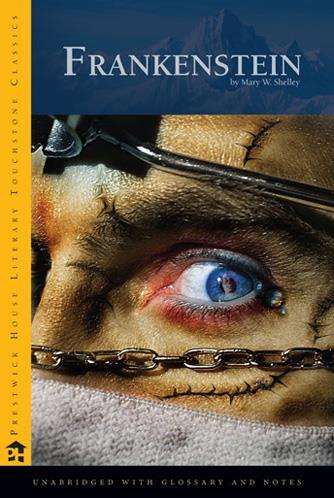 The antecedent of all mad scientist stories was published in 1818 in epistolary form, documenting Victor Frankenstein's unorthodox scientific experiment. After the death of his mother, Victor buries himself in his work at the University of Ingolstadt to help cope with his grief, soon developing a secret technique to impart life to non-living matter. Armed with his accelerated knowledge of chemistry, Victor dedicates months to feverishly fashioning a creature out of old body parts scavenged from charnel houses and graves. One night, he succeeds to bring the creature to life, but upon seeing the hideous creature, Victor abandons his creation. Alone and forsaken, the creature begins to systematically hunt down Victor’s loved ones, to extract revenge for the misery his creator has caused him. A thrilling page-turner that examines not only science and technology, but also the feared consequences of tampering with human life.
The antecedent of all mad scientist stories was published in 1818 in epistolary form, documenting Victor Frankenstein's unorthodox scientific experiment. After the death of his mother, Victor buries himself in his work at the University of Ingolstadt to help cope with his grief, soon developing a secret technique to impart life to non-living matter. Armed with his accelerated knowledge of chemistry, Victor dedicates months to feverishly fashioning a creature out of old body parts scavenged from charnel houses and graves. One night, he succeeds to bring the creature to life, but upon seeing the hideous creature, Victor abandons his creation. Alone and forsaken, the creature begins to systematically hunt down Victor’s loved ones, to extract revenge for the misery his creator has caused him. A thrilling page-turner that examines not only science and technology, but also the feared consequences of tampering with human life.
#2: The Complete Tales and Poems by Edgar Allan Poe (1845)
 This list wouldn’t be completed without the mind-melding horror stories by Poe. Poe gets credited for perfecting the American horror story genre, thanks to his eerie poems and nail-biting short stories. With every tale, you feel like you’re walking on a razor’s edge between grim amusement and madness. In “The Cask of Amontillado,” old Montresor gets his rival, Fortunato drunk before luring him to a niche in the wall of his wine cellar, ruthlessly sealing him in. In “The Tell-Tale Heart,” the narrator murders his elderly roommate and hides his dismembered body beneath the floorboards, until his heightened senses catch the steadily-increasing heartbeat coming from the floor. And finally, in “The Raven,” the narrator descents into madness and despair as a raven sits forever above his chamber door tormenting him with the word ‘Nevermore' repeatedly. Even in the 21st-century, Poe’s writing dwells on the dark corner of our literary consciousness, still making our spine-tingle with his unnerving tales.
This list wouldn’t be completed without the mind-melding horror stories by Poe. Poe gets credited for perfecting the American horror story genre, thanks to his eerie poems and nail-biting short stories. With every tale, you feel like you’re walking on a razor’s edge between grim amusement and madness. In “The Cask of Amontillado,” old Montresor gets his rival, Fortunato drunk before luring him to a niche in the wall of his wine cellar, ruthlessly sealing him in. In “The Tell-Tale Heart,” the narrator murders his elderly roommate and hides his dismembered body beneath the floorboards, until his heightened senses catch the steadily-increasing heartbeat coming from the floor. And finally, in “The Raven,” the narrator descents into madness and despair as a raven sits forever above his chamber door tormenting him with the word ‘Nevermore' repeatedly. Even in the 21st-century, Poe’s writing dwells on the dark corner of our literary consciousness, still making our spine-tingle with his unnerving tales.
#3: Carrie by Stephen King (1974)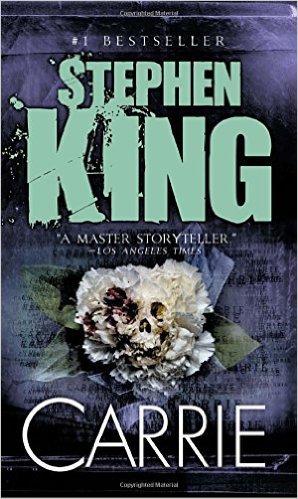 Carrie White finds herself trapped between two equally horrible environments. At home, Carrie is smothered by a mother who is a religious fanatic who has cut Carrie off from having a normal social life. The other half of Carrie’s life is even worse. At school, she is a social pariah. Her quiet demeanor has made her a perpetual target of teasing and crude practical jokes. That all changes when Carrie discovers that she possesses telekinetic powers. And then events leading up to her high school prom changes everything.
Carrie White finds herself trapped between two equally horrible environments. At home, Carrie is smothered by a mother who is a religious fanatic who has cut Carrie off from having a normal social life. The other half of Carrie’s life is even worse. At school, she is a social pariah. Her quiet demeanor has made her a perpetual target of teasing and crude practical jokes. That all changes when Carrie discovers that she possesses telekinetic powers. And then events leading up to her high school prom changes everything.
#4: Carmilla by Joseph Le Fanu (1872)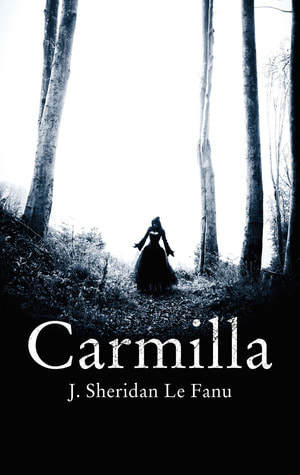 Before Dracula, there was Carmilla. Even though Stoker gets credit for inventing the modern vampire, his idea would never have been brought to light had he not expanded upon the ideas of prior authors. Carmilla provided a template for many of Dracula’s best remembered characters and motifs. Published in 1872, Le Fanu details the events that take place in the dense forest of Styria. Laura and her father live a quiet life in a remote castle. With no companions to keep Laura occupied, a mysterious house guest enters by the name of Carmilla. Slowly, Laura falls under Carmilla’s spell, unable to find the energy to resist her. But when the death toll of the peasants in the countryside begins to rise, Laura begins to wonder if she might be Carmilla’s next victim.
Before Dracula, there was Carmilla. Even though Stoker gets credit for inventing the modern vampire, his idea would never have been brought to light had he not expanded upon the ideas of prior authors. Carmilla provided a template for many of Dracula’s best remembered characters and motifs. Published in 1872, Le Fanu details the events that take place in the dense forest of Styria. Laura and her father live a quiet life in a remote castle. With no companions to keep Laura occupied, a mysterious house guest enters by the name of Carmilla. Slowly, Laura falls under Carmilla’s spell, unable to find the energy to resist her. But when the death toll of the peasants in the countryside begins to rise, Laura begins to wonder if she might be Carmilla’s next victim.
#5: The Strange Case of Dr. Jekyll and Mr. Hyde by Robert Louis Stevenson (1886) When Dr. Jekyll’s lawyer Mr. Utterson, learns that Jekyll has written his new friend Mr. Hyde into his will, he finds this newly added clause very unusual. Witnesses in London have spotted Mr. Hyde harassing people in the streets, accusing him of even murdering an old man. It’s only when an unexpected death draws Utterson’s attention that he finally learns the truth about Jekyll’s murderous split-personality. Here, Stevenson imagines a single body containing both the intellectual Dr. Jekyll and the dangerous Mr. Hyde, mirroring the attraction of civility and savagery.
When Dr. Jekyll’s lawyer Mr. Utterson, learns that Jekyll has written his new friend Mr. Hyde into his will, he finds this newly added clause very unusual. Witnesses in London have spotted Mr. Hyde harassing people in the streets, accusing him of even murdering an old man. It’s only when an unexpected death draws Utterson’s attention that he finally learns the truth about Jekyll’s murderous split-personality. Here, Stevenson imagines a single body containing both the intellectual Dr. Jekyll and the dangerous Mr. Hyde, mirroring the attraction of civility and savagery.
#6: Salem’s Lot by Stephen King (1975)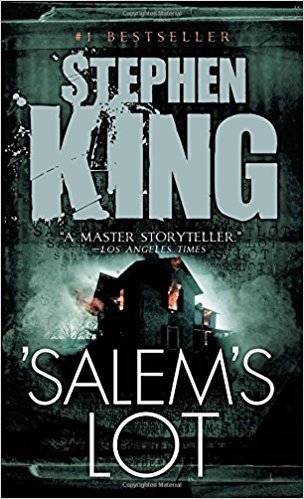 Ben Mears is unable to conquer his grief after his wife was killed in a motorcycle crash. After a twenty-five year absence, he finally returns to the town of Jerusalem’s Lot – known by most of its inhabitants as “Salem’s Lot.” As a child, Ben remembers fondly of the idyllic images of the town, but not until he’s startled by the sight of the Marsten House. The Marsten House is filled with evil and Ben feels almost as if the house has been waiting for his return.
Ben Mears is unable to conquer his grief after his wife was killed in a motorcycle crash. After a twenty-five year absence, he finally returns to the town of Jerusalem’s Lot – known by most of its inhabitants as “Salem’s Lot.” As a child, Ben remembers fondly of the idyllic images of the town, but not until he’s startled by the sight of the Marsten House. The Marsten House is filled with evil and Ben feels almost as if the house has been waiting for his return.
#7: The Picture of Dorian Gray by Oscar Wilde (1890)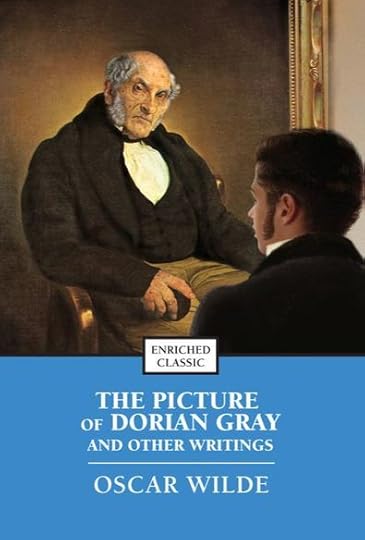 Wilde delivers a novel that is both a mishmash of fantasy and horror, following the life of the wealthy, vain and incredibly handsome Dorian Gray. The novel begins when the famous painter, Basil Hallward reveals his portrait of Dorian. Upon seeing his portrait, Dorian murmurs a prayer that he may always look as the painting does. However, Dorian soon discovers that whatever sins or evil acts he does, gets reflect in his portrait. Wilde creates an air of palpable surrealism, making his readers waiting in such mounting eeriness for Dorian’s next evil act.
Wilde delivers a novel that is both a mishmash of fantasy and horror, following the life of the wealthy, vain and incredibly handsome Dorian Gray. The novel begins when the famous painter, Basil Hallward reveals his portrait of Dorian. Upon seeing his portrait, Dorian murmurs a prayer that he may always look as the painting does. However, Dorian soon discovers that whatever sins or evil acts he does, gets reflect in his portrait. Wilde creates an air of palpable surrealism, making his readers waiting in such mounting eeriness for Dorian’s next evil act.
#8: The Great God Pan by Arthur Machen (1890)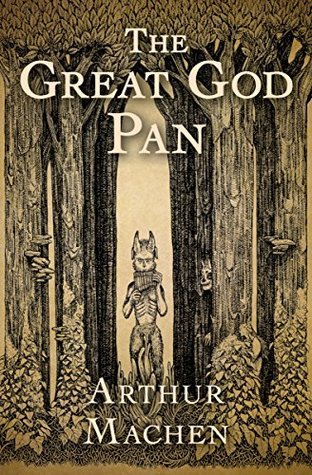 The story opens with an experiment conducted by Dr. Raymond, a specialist in “transcendental medicine.” He firmly believes that there are ways to bridge the gap between the world of man and the world of the ancient gods. After years of research he has reached the conclusion that a simple operation upon a group of nerve cells in the brain will enable the patient to come into direct contact with the god, Pan. Determined to put this theory into practice, the doctor calls in a witness and a seventeen-year-old girl, who is his guinea-pig. Like Dr. Frankenstein and Dr. Moreau, Dr. Raymond tampers with forces that are beyond his control, leading to devastating results.
The story opens with an experiment conducted by Dr. Raymond, a specialist in “transcendental medicine.” He firmly believes that there are ways to bridge the gap between the world of man and the world of the ancient gods. After years of research he has reached the conclusion that a simple operation upon a group of nerve cells in the brain will enable the patient to come into direct contact with the god, Pan. Determined to put this theory into practice, the doctor calls in a witness and a seventeen-year-old girl, who is his guinea-pig. Like Dr. Frankenstein and Dr. Moreau, Dr. Raymond tampers with forces that are beyond his control, leading to devastating results.
#9: The Shining by Stephen King (1977) A young boy’s special perception and a possessed hotel interact with deadly results. When five year-old Danny Torrence and his parents Jack and Wendy get hired to be the new caretakers for the Overlook Hotel for the winter, terror is on the brink. It’s Jack’s last chance to concentrate on his writing and get his career back on track. However, things take a turn for the worst when Jack becomes distracted by the history of the hotel which includes several suicides and a vicious murder. Jack becomes more and more obsessed with the hotel, until he becomes possessed.
A young boy’s special perception and a possessed hotel interact with deadly results. When five year-old Danny Torrence and his parents Jack and Wendy get hired to be the new caretakers for the Overlook Hotel for the winter, terror is on the brink. It’s Jack’s last chance to concentrate on his writing and get his career back on track. However, things take a turn for the worst when Jack becomes distracted by the history of the hotel which includes several suicides and a vicious murder. Jack becomes more and more obsessed with the hotel, until he becomes possessed.
#10: The Island of Dr. Moreau by H.G. Wells (1896)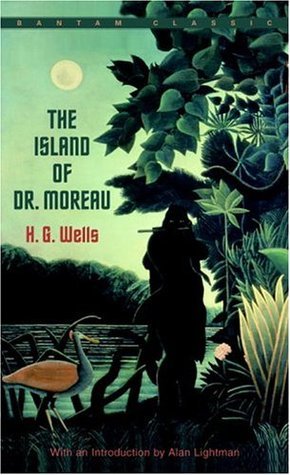 H.G. Wells’s science fiction classic asks the reader to consider the limits of natural science and the distinction between man and beast. When Prendick finds himself shipwrecked in the middle of the ocean, he gets rescued by a passing boat bound for an unnamed island. When they arrived on the island, Prendick meets the cold and precise, Doctor Moreau who conducts his research on the island. Prendick is exceedingly curious about Moreau’s research on the island and one day discovers a that Moreau is vivisecting animals to resemble humans. The humanoids live in the jungle and recite a strange list of rules prohibiting against bestial behavior like walking on all four legs. Moreau meanwhile becomes obsessed to have his experiments make a complete transformation from animal to human.
H.G. Wells’s science fiction classic asks the reader to consider the limits of natural science and the distinction between man and beast. When Prendick finds himself shipwrecked in the middle of the ocean, he gets rescued by a passing boat bound for an unnamed island. When they arrived on the island, Prendick meets the cold and precise, Doctor Moreau who conducts his research on the island. Prendick is exceedingly curious about Moreau’s research on the island and one day discovers a that Moreau is vivisecting animals to resemble humans. The humanoids live in the jungle and recite a strange list of rules prohibiting against bestial behavior like walking on all four legs. Moreau meanwhile becomes obsessed to have his experiments make a complete transformation from animal to human.
#11: Dracula by Bram Stoker (1897)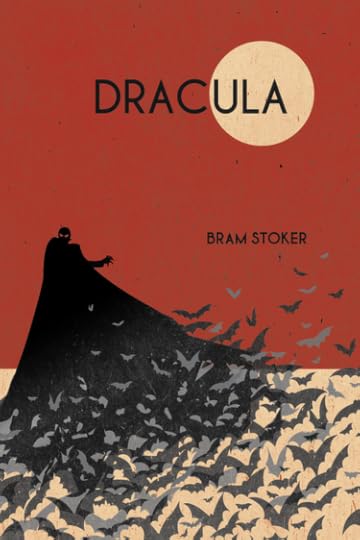 This 1897 classic horror story is the root of almost all vampire books. When young English lawyer, Jonathon Harker travels to Transylvania to help a rich nobleman purchase an estate in England, he quickly learns that his client is actually a vampire. The story shifts over to England, where Harker’s finacée, Mina Murray witnesses the deteriorating health of her friend, Lucy Westenra after discovering two tiny red marks on Lucy’s neck. Stoker’s writing is a sultry end of a century tale, steeped in suspense and jeopardy. More so, Stroker’s characterization of Dracula is deeply original, drawing his inspiration from early vampire literature. Sure, you’ve might’ve gotten your vampire kick after reading the Twilight or Vampire Academy series, but the original blood sucking fiend still has the potential to keep you up at night.
This 1897 classic horror story is the root of almost all vampire books. When young English lawyer, Jonathon Harker travels to Transylvania to help a rich nobleman purchase an estate in England, he quickly learns that his client is actually a vampire. The story shifts over to England, where Harker’s finacée, Mina Murray witnesses the deteriorating health of her friend, Lucy Westenra after discovering two tiny red marks on Lucy’s neck. Stoker’s writing is a sultry end of a century tale, steeped in suspense and jeopardy. More so, Stroker’s characterization of Dracula is deeply original, drawing his inspiration from early vampire literature. Sure, you’ve might’ve gotten your vampire kick after reading the Twilight or Vampire Academy series, but the original blood sucking fiend still has the potential to keep you up at night.
#12: Pet Sematary by Stephen King (1983) The story centers on Louis Creed, a family man and a doctor who moves his family into a beautiful new home. The day they move in, Louis meets their neighbor, Judson Crandall who quickly becomes a friend. Jud shows Louis around the neighborhood as well as the vast boundaries of their property. A path on the edge of the Creed property leads up to a pet cemetery (misspelled “sematary” on the sign) where the children of the town bury their deceased animals. But Louis is warned never to cross the boundary between the Pet Sematary and the woods beyond it. For evil is lurking there.
The story centers on Louis Creed, a family man and a doctor who moves his family into a beautiful new home. The day they move in, Louis meets their neighbor, Judson Crandall who quickly becomes a friend. Jud shows Louis around the neighborhood as well as the vast boundaries of their property. A path on the edge of the Creed property leads up to a pet cemetery (misspelled “sematary” on the sign) where the children of the town bury their deceased animals. But Louis is warned never to cross the boundary between the Pet Sematary and the woods beyond it. For evil is lurking there.
#13: The Turn of the Screw by Henry James (1898)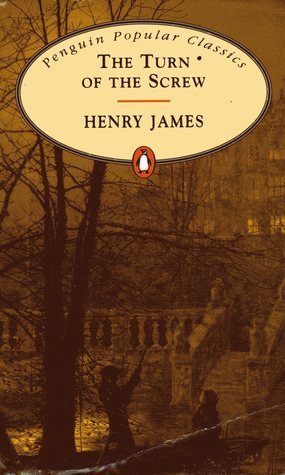 When a nameless Governess is hired to care for two young children, Miles and Flora on their uncle’s remote English estate, she is determined to adore and care for them. Initially charmed by her charges, the Governess becomes wary of the two children when she suspects that Miles and Flora are in communication with two ghosts – Peter Quint and Miss Jessel – who previously worked on the estate before their deaths. This classic ghost story questions the Governess’s reliability as a narrator. Are the ghosts actually real? Do they seek to possess the children? The terror of the tales resides in its utter ambiguity.
When a nameless Governess is hired to care for two young children, Miles and Flora on their uncle’s remote English estate, she is determined to adore and care for them. Initially charmed by her charges, the Governess becomes wary of the two children when she suspects that Miles and Flora are in communication with two ghosts – Peter Quint and Miss Jessel – who previously worked on the estate before their deaths. This classic ghost story questions the Governess’s reliability as a narrator. Are the ghosts actually real? Do they seek to possess the children? The terror of the tales resides in its utter ambiguity.
#14: The Classic Horror Stories by H.P. Lovecraft (1928)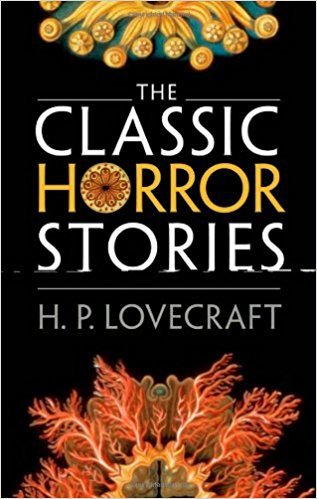 This collection of stories offers a balanced assessment both Gothic tradition and American fiction in the 1920s and 1930s. What makes H.P. Lovecraft’s stories so hauntingly creepy, are how his creatures are kept in the proverbial shadows, making their presence much more chilling. The majority of Lovecraft’s tales are effectively one man’ experiences of wonder, horror and madness. The characters see such bizarre sights which terrify them beyond reasoning. The descriptions are cleverly kept to a bare minimum so that the audience’s imagination builds up the terror to an appropriate level.
This collection of stories offers a balanced assessment both Gothic tradition and American fiction in the 1920s and 1930s. What makes H.P. Lovecraft’s stories so hauntingly creepy, are how his creatures are kept in the proverbial shadows, making their presence much more chilling. The majority of Lovecraft’s tales are effectively one man’ experiences of wonder, horror and madness. The characters see such bizarre sights which terrify them beyond reasoning. The descriptions are cleverly kept to a bare minimum so that the audience’s imagination builds up the terror to an appropriate level.
#15: Cujo by Stephen King (1981)
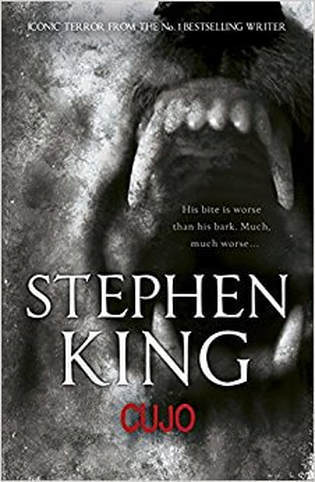 Donna Trenton finds herself trapped in her car with her son Tad by a rapid Saint Bernard who is intent on seeing them dead. As the interior of the car get increasingly hot, Donna and Tad might not have enough time to plan their escape.
Donna Trenton finds herself trapped in her car with her son Tad by a rapid Saint Bernard who is intent on seeing them dead. As the interior of the car get increasingly hot, Donna and Tad might not have enough time to plan their escape.
#16: The Haunting of Hill House by Shirley Jackson (1959)
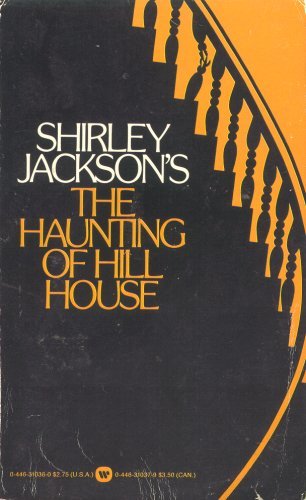 When Dr. Montague decides that it’s time science proved the existence of ghosts, he sets up his experiment at Hill House, a mansion known in the community to have a haunted history. There he invites the socially repressed Eleanor Vance, the emotional live-wire Theodora and the heir to Hill House, Luke to be his assistants as he performs his experiment. But during their first night in Hill House, Eleanor begins to feel that she and the house are one and hears someone banging on her bedroom door. Is it the house, or Eleanor’s deranged imagination?
When Dr. Montague decides that it’s time science proved the existence of ghosts, he sets up his experiment at Hill House, a mansion known in the community to have a haunted history. There he invites the socially repressed Eleanor Vance, the emotional live-wire Theodora and the heir to Hill House, Luke to be his assistants as he performs his experiment. But during their first night in Hill House, Eleanor begins to feel that she and the house are one and hears someone banging on her bedroom door. Is it the house, or Eleanor’s deranged imagination?
#17: Rosemary’s Baby by Ira Levin (1967)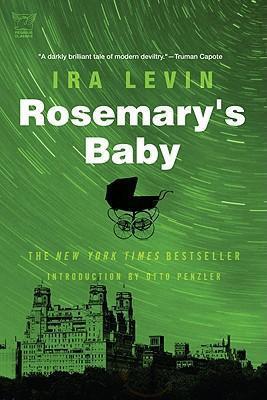 When Rosemary and her husband move into their New York City apartment, they are quickly befriended by their new eccentric elderly neighbors. Rosemary finds the neighbors absurd, except for her husband who suddenly begins paying the couple frequent visits. Soon, Rosemary becomes pregnant, just when things around the apartment start to get weird. Especially when she discovers that her neighbors are actually leaders of a Satanic coven.
When Rosemary and her husband move into their New York City apartment, they are quickly befriended by their new eccentric elderly neighbors. Rosemary finds the neighbors absurd, except for her husband who suddenly begins paying the couple frequent visits. Soon, Rosemary becomes pregnant, just when things around the apartment start to get weird. Especially when she discovers that her neighbors are actually leaders of a Satanic coven.
#18: It by Stephen King (1986)
 In the spring of 1985, It has returned! Every twenty-seven years since the dawn of time, It – an unearthly creatures who lives in the sewers beneath the town of Derry – comes back to murder small children. Only seven people have faced It and have lived to tell the tale. And what they remembered those twenty-seven years ago was battling an emerging evil in the form of a murderous, bloodthirsty clown known as Pennywise.
In the spring of 1985, It has returned! Every twenty-seven years since the dawn of time, It – an unearthly creatures who lives in the sewers beneath the town of Derry – comes back to murder small children. Only seven people have faced It and have lived to tell the tale. And what they remembered those twenty-seven years ago was battling an emerging evil in the form of a murderous, bloodthirsty clown known as Pennywise.
#19: Something Wicked This Way Comes by Ray Bradbury (1962) Most of the book is set in the dead of night, as Jim Nightshade and Will Halloway investigate the arrival of the mysterious carnival and the effect it has on the midwestern town. Lured by its bright lights, the two boys witness an ominous assemble of sinister activities and rides at the carnival, led by the mustache-twirling Mr. Dark. The mysterious Mr. Dark comes bearing promises for the town elders: restored youth, second chances and fulfilled dreams. These all, of course, come at a heavy price.
Most of the book is set in the dead of night, as Jim Nightshade and Will Halloway investigate the arrival of the mysterious carnival and the effect it has on the midwestern town. Lured by its bright lights, the two boys witness an ominous assemble of sinister activities and rides at the carnival, led by the mustache-twirling Mr. Dark. The mysterious Mr. Dark comes bearing promises for the town elders: restored youth, second chances and fulfilled dreams. These all, of course, come at a heavy price.
#20: Hell House by Richard Matheson (1971)
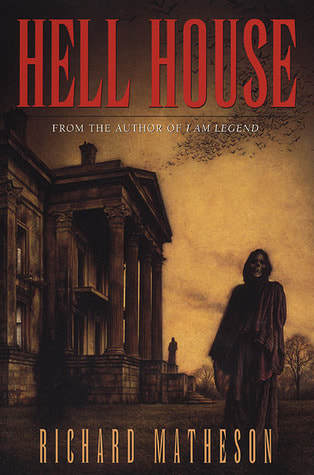 Some have called it a retelling of Shirley Jackson’s The Haunting of Hill House, but with a more gruesome twist. When old, cranky (but incredibly wealthy) Rolf Deutsch hires four people to determine if there’s life after death, he offers a large sum of money to whomever dares to spend one week up at Hell House. Dr. Barrett, a skeptic physicist/paranormal investigator and his wife agree to the proposal as well as a Christian medium who can contact the spirit world, and a child prodigy. But upon settling inside Hell House, the foursome fall prey to dark influences. The supernatural horror escalades causing all four characters to question their own sanity until the conclusion.
Some have called it a retelling of Shirley Jackson’s The Haunting of Hill House, but with a more gruesome twist. When old, cranky (but incredibly wealthy) Rolf Deutsch hires four people to determine if there’s life after death, he offers a large sum of money to whomever dares to spend one week up at Hell House. Dr. Barrett, a skeptic physicist/paranormal investigator and his wife agree to the proposal as well as a Christian medium who can contact the spirit world, and a child prodigy. But upon settling inside Hell House, the foursome fall prey to dark influences. The supernatural horror escalades causing all four characters to question their own sanity until the conclusion.
#21: Misery by Stephen King (1987)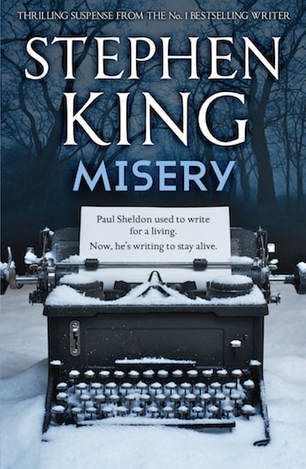 An author by the name of Paul Sheldon doesn’t remember much after his car accident. He wakes up in a bed that is not his own, nor at a hospital. Instead, an ex-nurse named Annie Wilkes is standing over him, telling Paul that she is his number one fan. Annie lives in a rural farmhouse in Sidewinder, Colorado, isolated from civilization. What’s worse, even though Annie rescues Paul, she holds the author hostage.
An author by the name of Paul Sheldon doesn’t remember much after his car accident. He wakes up in a bed that is not his own, nor at a hospital. Instead, an ex-nurse named Annie Wilkes is standing over him, telling Paul that she is his number one fan. Annie lives in a rural farmhouse in Sidewinder, Colorado, isolated from civilization. What’s worse, even though Annie rescues Paul, she holds the author hostage.
#22: The Amityville Horror by Jay Anson (1977)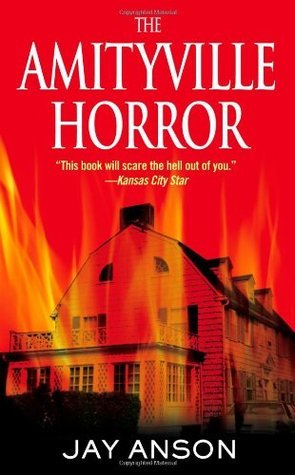 This controversial novel follows George and Kathy Lutz’s family who buy a six-bedroom home at a bargain price. However, there’s a catch: As it turns out, the house was the scene of a horrific murder. Soon, the family begins to list all of the strange things that they have encountered while living at the house. These unexplainable occurrences as well as the history of the house manifests and continues to build throughout the story. After only 28 days of living in that house, the Lutz family fled in sheer terror, refusing to ever go back to the house. Since then, there has been no reported hauntings or incidents, so really, it’s up to you to be the judge.
This controversial novel follows George and Kathy Lutz’s family who buy a six-bedroom home at a bargain price. However, there’s a catch: As it turns out, the house was the scene of a horrific murder. Soon, the family begins to list all of the strange things that they have encountered while living at the house. These unexplainable occurrences as well as the history of the house manifests and continues to build throughout the story. After only 28 days of living in that house, the Lutz family fled in sheer terror, refusing to ever go back to the house. Since then, there has been no reported hauntings or incidents, so really, it’s up to you to be the judge.
#23: The Exorcist by William Peter Blatty (1971)
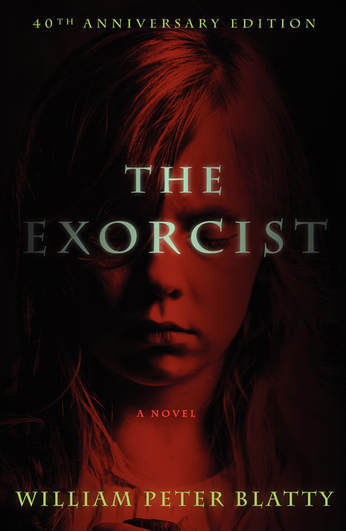 When recently divorced actress Chris MacNeil rents a home across the street from Georgetown University, she hears a strange rapping sound coming from somewhere in the house. Soon, other strange events occur, the most serious being her daughter Regan’s changed personality. Having found a Ouija board in the basement of the house, Regan has contacted a “playmate” called Captain Howdy who physically abuses her. Medical tests prove futile in explaining Regan’s emerging violent behavior, and the her mother becomes convinced that she is possessed.
When recently divorced actress Chris MacNeil rents a home across the street from Georgetown University, she hears a strange rapping sound coming from somewhere in the house. Soon, other strange events occur, the most serious being her daughter Regan’s changed personality. Having found a Ouija board in the basement of the house, Regan has contacted a “playmate” called Captain Howdy who physically abuses her. Medical tests prove futile in explaining Regan’s emerging violent behavior, and the her mother becomes convinced that she is possessed.
#24: The Collector by John Fowles (1963)
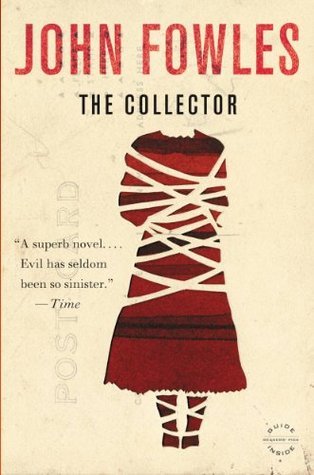 Frederick Clegg grows obsessed with Miranda Grey, a beautiful teenager whom he watches from afar. So much so, that he takes the necessary steps to kidnap her. He buys a secluded house in the country and readies a small basement as an inescapable cell; he also buys a van with which to follow and snatch Miranda. Eventually, after determining her habits and discovering where she lives, Frederick kidnaps her one night as she is walking home. The first half of the story is told from Clegg’s perspective, first as he prepares to abduct Miranda and the second half is told from Miranda’s point of view formatted as a journal she keeps during her captivity.
Frederick Clegg grows obsessed with Miranda Grey, a beautiful teenager whom he watches from afar. So much so, that he takes the necessary steps to kidnap her. He buys a secluded house in the country and readies a small basement as an inescapable cell; he also buys a van with which to follow and snatch Miranda. Eventually, after determining her habits and discovering where she lives, Frederick kidnaps her one night as she is walking home. The first half of the story is told from Clegg’s perspective, first as he prepares to abduct Miranda and the second half is told from Miranda’s point of view formatted as a journal she keeps during her captivity.
#25: The Silence of the Lambs by Thomas Harris (1988)
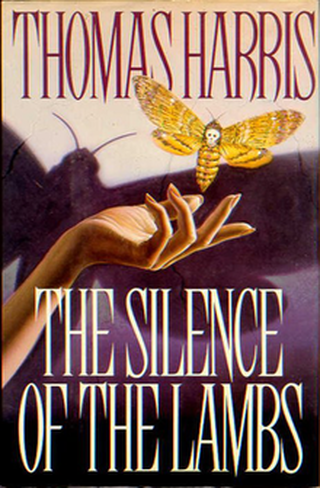 Clarice Starling is an FBI trainee who gets summoned one day to interview Hannibal Lecter – a psychiatrist who kills and eats people in his spare time. Clarice agrees to the meeting in order to see if he has any clues to help the FBI identify a new serial killer named Buffalo Bill, whose been skinning women and leaving their corpses behind. Surprisingly, Hannibal takes an interest in Clarice, finding her ambitions an interesting character trait but also tapping into her weaknesses to manipulate her.
Clarice Starling is an FBI trainee who gets summoned one day to interview Hannibal Lecter – a psychiatrist who kills and eats people in his spare time. Clarice agrees to the meeting in order to see if he has any clues to help the FBI identify a new serial killer named Buffalo Bill, whose been skinning women and leaving their corpses behind. Surprisingly, Hannibal takes an interest in Clarice, finding her ambitions an interesting character trait but also tapping into her weaknesses to manipulate her.
#26: Carrion Comfort by Dan Simmons (1989)
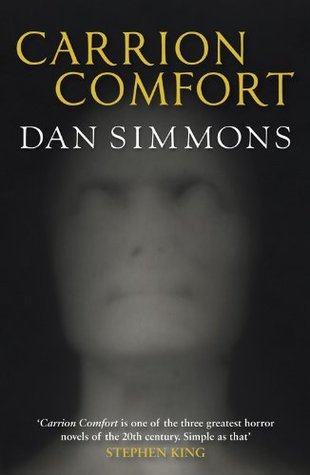 A cross between horror and science fiction, the book opens with three strange elderly beings meeting in a house to discuss a game they have been playing for decades. Each of them has the ability to control humans. Their game is to use humans to kill other humans. More so, they use the human mind to feed, and prolonging their own lives at the expense of others. But soon, the three strangers start to fight, fracturing their relationships with one another and eventually split up. This separation results in the introduction of a handful of other characters in various decades. All of them are connected to one another in some shape or form. Are they being possessed, used as pawns to navigate their drive for revenge against the others, or are all of their actions really under their control?
A cross between horror and science fiction, the book opens with three strange elderly beings meeting in a house to discuss a game they have been playing for decades. Each of them has the ability to control humans. Their game is to use humans to kill other humans. More so, they use the human mind to feed, and prolonging their own lives at the expense of others. But soon, the three strangers start to fight, fracturing their relationships with one another and eventually split up. This separation results in the introduction of a handful of other characters in various decades. All of them are connected to one another in some shape or form. Are they being possessed, used as pawns to navigate their drive for revenge against the others, or are all of their actions really under their control?
#27: The Woman in Black by Susan Hill (1983)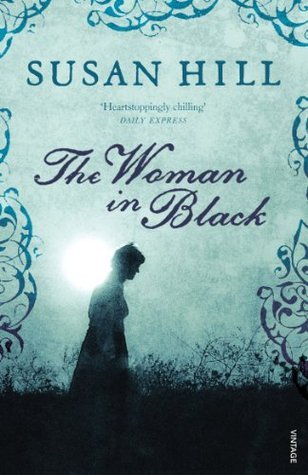 Arthur Kipps is a young lawyer, sent to Crythin Gifford to settle the affairs of the recently deceased Alice Drablow who lived at Eel Marsh House. But upon arriving to his client’s funeral, he sees a woman dressed in black. At Eel Marsh House, Arthur is haunted by noises and sights of the woman in black. He later learns that a child dies each time the woman in black is seen
Arthur Kipps is a young lawyer, sent to Crythin Gifford to settle the affairs of the recently deceased Alice Drablow who lived at Eel Marsh House. But upon arriving to his client’s funeral, he sees a woman dressed in black. At Eel Marsh House, Arthur is haunted by noises and sights of the woman in black. He later learns that a child dies each time the woman in black is seen
#28: American Psycho by Bret Easton Ellis (1991) This twisted satire of of a novel focuses on the hyper-wealthy Patrick Bateman, a Wall Street investment banker who spends his mornings at the gym and his nights clubbing with his friends. Everyone believes that Bateman is a nice guy, except that he’s actually a psychopathic killer who has confessed to his crimes repeatedly. Yet, no one wants to believe that Bateman could hurt someone, so everyone chooses to ignore Bateman’s confession. He tortures a homeless man. Breaks a dog’s legs and even gets his hands on a chainsaw. But throughout the novel, the readers start to question if Bateman may actually be unstable. Did the murders really happen, or is Bateman just an unreliable narrator?
This twisted satire of of a novel focuses on the hyper-wealthy Patrick Bateman, a Wall Street investment banker who spends his mornings at the gym and his nights clubbing with his friends. Everyone believes that Bateman is a nice guy, except that he’s actually a psychopathic killer who has confessed to his crimes repeatedly. Yet, no one wants to believe that Bateman could hurt someone, so everyone chooses to ignore Bateman’s confession. He tortures a homeless man. Breaks a dog’s legs and even gets his hands on a chainsaw. But throughout the novel, the readers start to question if Bateman may actually be unstable. Did the murders really happen, or is Bateman just an unreliable narrator?
#29: Needful Things by Stephen King (1991)
 Leland Gaunt opens shop in Castle Rock and he somehow knows what item each of his customers wants and knows that they will do almost anything to get it. So when Eleven-year-old Brian Rusk, Gaunt’s first customer, buys a Sandy Koufax baseball card, Gaunt asks the boy to play a trick on a local woman as a price. Each of Gaunt’s customers are asked to do something over and above the cash price, which eventually spirals out of control for the citizens of Castle Rock.
Leland Gaunt opens shop in Castle Rock and he somehow knows what item each of his customers wants and knows that they will do almost anything to get it. So when Eleven-year-old Brian Rusk, Gaunt’s first customer, buys a Sandy Koufax baseball card, Gaunt asks the boy to play a trick on a local woman as a price. Each of Gaunt’s customers are asked to do something over and above the cash price, which eventually spirals out of control for the citizens of Castle Rock.
#30: House of Leaves by Mark Z. Danielewski (2000)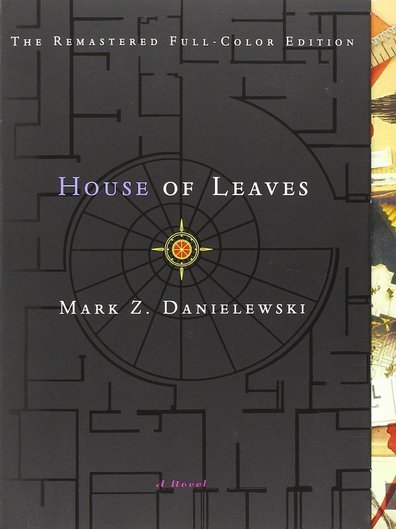 A certain house has a certain sinister personality of its own. It can create inner spaces that defy the laws of physics. Intrigued, Will Navidson brings in some specialists to try and figure out how the house manages to expand. But then he discovers in a closet, a freezing pit-dark corridor that leads to a maze of empty rooms and larger corridors and eventually a gigantic spiral staircase that seems to drop down to the center of the earth. None of this interior should exist, and when Will and the other men explore it, the walls to the house begin to shift mysteriously leading the men into a tomblike expanse that proves dangerous.
A certain house has a certain sinister personality of its own. It can create inner spaces that defy the laws of physics. Intrigued, Will Navidson brings in some specialists to try and figure out how the house manages to expand. But then he discovers in a closet, a freezing pit-dark corridor that leads to a maze of empty rooms and larger corridors and eventually a gigantic spiral staircase that seems to drop down to the center of the earth. None of this interior should exist, and when Will and the other men explore it, the walls to the house begin to shift mysteriously leading the men into a tomblike expanse that proves dangerous.
#31: Coraline by Neil Gaiman (2002)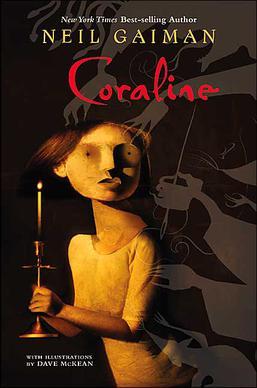 This classic insidious YA novel begins when young Coraline Jones and her parents move into an apartment in an old house. While exploring her new home, Coraline discovers a secret door, behind which lies an alternate world that closely mirrors her own, but in many ways better. This surreal world is ruled by the Other Mother, who concocts the superficial world where Coraline’s every wish is indulged. However, when the Other Mother tries to convince Coraline to stay, the parallel world suddenly seems less whimsical and much more treacherous.
This classic insidious YA novel begins when young Coraline Jones and her parents move into an apartment in an old house. While exploring her new home, Coraline discovers a secret door, behind which lies an alternate world that closely mirrors her own, but in many ways better. This surreal world is ruled by the Other Mother, who concocts the superficial world where Coraline’s every wish is indulged. However, when the Other Mother tries to convince Coraline to stay, the parallel world suddenly seems less whimsical and much more treacherous.
Good luck sleeping for the rest of the month.
You know what I’m talking about.
The crisp air and the long nights can only be leading up one thing: Halloween!
Which means it’s time to curl up with a book that’s guaranteed to give you the shivers.
Or at least finding yourself sleeping with the lights on.
 Every October, I somehow find a way to get myself into the Halloween spirit by sitting down and reading a horror novel.
Every October, I somehow find a way to get myself into the Halloween spirit by sitting down and reading a horror novel. Or several horror novels.
So after dedicating an entire month reading nothing other than mischief, frights and psychological turmoil, it turns out, the most chilling horror stories are the classics.
The horror genre has evolved over the centuries, many thanks to the different authors who contributed to the suspense and paranoia in their writing. Each author over the years has managed to craft their own version of horror with a unique style.
From vampires to mad scientists to even Stephen King novels, nothing gets you into a Halloween mood faster than an good old-fashion scary story.
#1: Frankenstein by Mary Shelley (1818)
 The antecedent of all mad scientist stories was published in 1818 in epistolary form, documenting Victor Frankenstein's unorthodox scientific experiment. After the death of his mother, Victor buries himself in his work at the University of Ingolstadt to help cope with his grief, soon developing a secret technique to impart life to non-living matter. Armed with his accelerated knowledge of chemistry, Victor dedicates months to feverishly fashioning a creature out of old body parts scavenged from charnel houses and graves. One night, he succeeds to bring the creature to life, but upon seeing the hideous creature, Victor abandons his creation. Alone and forsaken, the creature begins to systematically hunt down Victor’s loved ones, to extract revenge for the misery his creator has caused him. A thrilling page-turner that examines not only science and technology, but also the feared consequences of tampering with human life.
The antecedent of all mad scientist stories was published in 1818 in epistolary form, documenting Victor Frankenstein's unorthodox scientific experiment. After the death of his mother, Victor buries himself in his work at the University of Ingolstadt to help cope with his grief, soon developing a secret technique to impart life to non-living matter. Armed with his accelerated knowledge of chemistry, Victor dedicates months to feverishly fashioning a creature out of old body parts scavenged from charnel houses and graves. One night, he succeeds to bring the creature to life, but upon seeing the hideous creature, Victor abandons his creation. Alone and forsaken, the creature begins to systematically hunt down Victor’s loved ones, to extract revenge for the misery his creator has caused him. A thrilling page-turner that examines not only science and technology, but also the feared consequences of tampering with human life. #2: The Complete Tales and Poems by Edgar Allan Poe (1845)
 This list wouldn’t be completed without the mind-melding horror stories by Poe. Poe gets credited for perfecting the American horror story genre, thanks to his eerie poems and nail-biting short stories. With every tale, you feel like you’re walking on a razor’s edge between grim amusement and madness. In “The Cask of Amontillado,” old Montresor gets his rival, Fortunato drunk before luring him to a niche in the wall of his wine cellar, ruthlessly sealing him in. In “The Tell-Tale Heart,” the narrator murders his elderly roommate and hides his dismembered body beneath the floorboards, until his heightened senses catch the steadily-increasing heartbeat coming from the floor. And finally, in “The Raven,” the narrator descents into madness and despair as a raven sits forever above his chamber door tormenting him with the word ‘Nevermore' repeatedly. Even in the 21st-century, Poe’s writing dwells on the dark corner of our literary consciousness, still making our spine-tingle with his unnerving tales.
This list wouldn’t be completed without the mind-melding horror stories by Poe. Poe gets credited for perfecting the American horror story genre, thanks to his eerie poems and nail-biting short stories. With every tale, you feel like you’re walking on a razor’s edge between grim amusement and madness. In “The Cask of Amontillado,” old Montresor gets his rival, Fortunato drunk before luring him to a niche in the wall of his wine cellar, ruthlessly sealing him in. In “The Tell-Tale Heart,” the narrator murders his elderly roommate and hides his dismembered body beneath the floorboards, until his heightened senses catch the steadily-increasing heartbeat coming from the floor. And finally, in “The Raven,” the narrator descents into madness and despair as a raven sits forever above his chamber door tormenting him with the word ‘Nevermore' repeatedly. Even in the 21st-century, Poe’s writing dwells on the dark corner of our literary consciousness, still making our spine-tingle with his unnerving tales.#3: Carrie by Stephen King (1974)
 Carrie White finds herself trapped between two equally horrible environments. At home, Carrie is smothered by a mother who is a religious fanatic who has cut Carrie off from having a normal social life. The other half of Carrie’s life is even worse. At school, she is a social pariah. Her quiet demeanor has made her a perpetual target of teasing and crude practical jokes. That all changes when Carrie discovers that she possesses telekinetic powers. And then events leading up to her high school prom changes everything.
Carrie White finds herself trapped between two equally horrible environments. At home, Carrie is smothered by a mother who is a religious fanatic who has cut Carrie off from having a normal social life. The other half of Carrie’s life is even worse. At school, she is a social pariah. Her quiet demeanor has made her a perpetual target of teasing and crude practical jokes. That all changes when Carrie discovers that she possesses telekinetic powers. And then events leading up to her high school prom changes everything. #4: Carmilla by Joseph Le Fanu (1872)
 Before Dracula, there was Carmilla. Even though Stoker gets credit for inventing the modern vampire, his idea would never have been brought to light had he not expanded upon the ideas of prior authors. Carmilla provided a template for many of Dracula’s best remembered characters and motifs. Published in 1872, Le Fanu details the events that take place in the dense forest of Styria. Laura and her father live a quiet life in a remote castle. With no companions to keep Laura occupied, a mysterious house guest enters by the name of Carmilla. Slowly, Laura falls under Carmilla’s spell, unable to find the energy to resist her. But when the death toll of the peasants in the countryside begins to rise, Laura begins to wonder if she might be Carmilla’s next victim.
Before Dracula, there was Carmilla. Even though Stoker gets credit for inventing the modern vampire, his idea would never have been brought to light had he not expanded upon the ideas of prior authors. Carmilla provided a template for many of Dracula’s best remembered characters and motifs. Published in 1872, Le Fanu details the events that take place in the dense forest of Styria. Laura and her father live a quiet life in a remote castle. With no companions to keep Laura occupied, a mysterious house guest enters by the name of Carmilla. Slowly, Laura falls under Carmilla’s spell, unable to find the energy to resist her. But when the death toll of the peasants in the countryside begins to rise, Laura begins to wonder if she might be Carmilla’s next victim.#5: The Strange Case of Dr. Jekyll and Mr. Hyde by Robert Louis Stevenson (1886)
 When Dr. Jekyll’s lawyer Mr. Utterson, learns that Jekyll has written his new friend Mr. Hyde into his will, he finds this newly added clause very unusual. Witnesses in London have spotted Mr. Hyde harassing people in the streets, accusing him of even murdering an old man. It’s only when an unexpected death draws Utterson’s attention that he finally learns the truth about Jekyll’s murderous split-personality. Here, Stevenson imagines a single body containing both the intellectual Dr. Jekyll and the dangerous Mr. Hyde, mirroring the attraction of civility and savagery.
When Dr. Jekyll’s lawyer Mr. Utterson, learns that Jekyll has written his new friend Mr. Hyde into his will, he finds this newly added clause very unusual. Witnesses in London have spotted Mr. Hyde harassing people in the streets, accusing him of even murdering an old man. It’s only when an unexpected death draws Utterson’s attention that he finally learns the truth about Jekyll’s murderous split-personality. Here, Stevenson imagines a single body containing both the intellectual Dr. Jekyll and the dangerous Mr. Hyde, mirroring the attraction of civility and savagery. #6: Salem’s Lot by Stephen King (1975)
 Ben Mears is unable to conquer his grief after his wife was killed in a motorcycle crash. After a twenty-five year absence, he finally returns to the town of Jerusalem’s Lot – known by most of its inhabitants as “Salem’s Lot.” As a child, Ben remembers fondly of the idyllic images of the town, but not until he’s startled by the sight of the Marsten House. The Marsten House is filled with evil and Ben feels almost as if the house has been waiting for his return.
Ben Mears is unable to conquer his grief after his wife was killed in a motorcycle crash. After a twenty-five year absence, he finally returns to the town of Jerusalem’s Lot – known by most of its inhabitants as “Salem’s Lot.” As a child, Ben remembers fondly of the idyllic images of the town, but not until he’s startled by the sight of the Marsten House. The Marsten House is filled with evil and Ben feels almost as if the house has been waiting for his return. #7: The Picture of Dorian Gray by Oscar Wilde (1890)
 Wilde delivers a novel that is both a mishmash of fantasy and horror, following the life of the wealthy, vain and incredibly handsome Dorian Gray. The novel begins when the famous painter, Basil Hallward reveals his portrait of Dorian. Upon seeing his portrait, Dorian murmurs a prayer that he may always look as the painting does. However, Dorian soon discovers that whatever sins or evil acts he does, gets reflect in his portrait. Wilde creates an air of palpable surrealism, making his readers waiting in such mounting eeriness for Dorian’s next evil act.
Wilde delivers a novel that is both a mishmash of fantasy and horror, following the life of the wealthy, vain and incredibly handsome Dorian Gray. The novel begins when the famous painter, Basil Hallward reveals his portrait of Dorian. Upon seeing his portrait, Dorian murmurs a prayer that he may always look as the painting does. However, Dorian soon discovers that whatever sins or evil acts he does, gets reflect in his portrait. Wilde creates an air of palpable surrealism, making his readers waiting in such mounting eeriness for Dorian’s next evil act.#8: The Great God Pan by Arthur Machen (1890)
 The story opens with an experiment conducted by Dr. Raymond, a specialist in “transcendental medicine.” He firmly believes that there are ways to bridge the gap between the world of man and the world of the ancient gods. After years of research he has reached the conclusion that a simple operation upon a group of nerve cells in the brain will enable the patient to come into direct contact with the god, Pan. Determined to put this theory into practice, the doctor calls in a witness and a seventeen-year-old girl, who is his guinea-pig. Like Dr. Frankenstein and Dr. Moreau, Dr. Raymond tampers with forces that are beyond his control, leading to devastating results.
The story opens with an experiment conducted by Dr. Raymond, a specialist in “transcendental medicine.” He firmly believes that there are ways to bridge the gap between the world of man and the world of the ancient gods. After years of research he has reached the conclusion that a simple operation upon a group of nerve cells in the brain will enable the patient to come into direct contact with the god, Pan. Determined to put this theory into practice, the doctor calls in a witness and a seventeen-year-old girl, who is his guinea-pig. Like Dr. Frankenstein and Dr. Moreau, Dr. Raymond tampers with forces that are beyond his control, leading to devastating results.#9: The Shining by Stephen King (1977)
 A young boy’s special perception and a possessed hotel interact with deadly results. When five year-old Danny Torrence and his parents Jack and Wendy get hired to be the new caretakers for the Overlook Hotel for the winter, terror is on the brink. It’s Jack’s last chance to concentrate on his writing and get his career back on track. However, things take a turn for the worst when Jack becomes distracted by the history of the hotel which includes several suicides and a vicious murder. Jack becomes more and more obsessed with the hotel, until he becomes possessed.
A young boy’s special perception and a possessed hotel interact with deadly results. When five year-old Danny Torrence and his parents Jack and Wendy get hired to be the new caretakers for the Overlook Hotel for the winter, terror is on the brink. It’s Jack’s last chance to concentrate on his writing and get his career back on track. However, things take a turn for the worst when Jack becomes distracted by the history of the hotel which includes several suicides and a vicious murder. Jack becomes more and more obsessed with the hotel, until he becomes possessed.#10: The Island of Dr. Moreau by H.G. Wells (1896)
 H.G. Wells’s science fiction classic asks the reader to consider the limits of natural science and the distinction between man and beast. When Prendick finds himself shipwrecked in the middle of the ocean, he gets rescued by a passing boat bound for an unnamed island. When they arrived on the island, Prendick meets the cold and precise, Doctor Moreau who conducts his research on the island. Prendick is exceedingly curious about Moreau’s research on the island and one day discovers a that Moreau is vivisecting animals to resemble humans. The humanoids live in the jungle and recite a strange list of rules prohibiting against bestial behavior like walking on all four legs. Moreau meanwhile becomes obsessed to have his experiments make a complete transformation from animal to human.
H.G. Wells’s science fiction classic asks the reader to consider the limits of natural science and the distinction between man and beast. When Prendick finds himself shipwrecked in the middle of the ocean, he gets rescued by a passing boat bound for an unnamed island. When they arrived on the island, Prendick meets the cold and precise, Doctor Moreau who conducts his research on the island. Prendick is exceedingly curious about Moreau’s research on the island and one day discovers a that Moreau is vivisecting animals to resemble humans. The humanoids live in the jungle and recite a strange list of rules prohibiting against bestial behavior like walking on all four legs. Moreau meanwhile becomes obsessed to have his experiments make a complete transformation from animal to human.#11: Dracula by Bram Stoker (1897)
 This 1897 classic horror story is the root of almost all vampire books. When young English lawyer, Jonathon Harker travels to Transylvania to help a rich nobleman purchase an estate in England, he quickly learns that his client is actually a vampire. The story shifts over to England, where Harker’s finacée, Mina Murray witnesses the deteriorating health of her friend, Lucy Westenra after discovering two tiny red marks on Lucy’s neck. Stoker’s writing is a sultry end of a century tale, steeped in suspense and jeopardy. More so, Stroker’s characterization of Dracula is deeply original, drawing his inspiration from early vampire literature. Sure, you’ve might’ve gotten your vampire kick after reading the Twilight or Vampire Academy series, but the original blood sucking fiend still has the potential to keep you up at night.
This 1897 classic horror story is the root of almost all vampire books. When young English lawyer, Jonathon Harker travels to Transylvania to help a rich nobleman purchase an estate in England, he quickly learns that his client is actually a vampire. The story shifts over to England, where Harker’s finacée, Mina Murray witnesses the deteriorating health of her friend, Lucy Westenra after discovering two tiny red marks on Lucy’s neck. Stoker’s writing is a sultry end of a century tale, steeped in suspense and jeopardy. More so, Stroker’s characterization of Dracula is deeply original, drawing his inspiration from early vampire literature. Sure, you’ve might’ve gotten your vampire kick after reading the Twilight or Vampire Academy series, but the original blood sucking fiend still has the potential to keep you up at night. #12: Pet Sematary by Stephen King (1983)
 The story centers on Louis Creed, a family man and a doctor who moves his family into a beautiful new home. The day they move in, Louis meets their neighbor, Judson Crandall who quickly becomes a friend. Jud shows Louis around the neighborhood as well as the vast boundaries of their property. A path on the edge of the Creed property leads up to a pet cemetery (misspelled “sematary” on the sign) where the children of the town bury their deceased animals. But Louis is warned never to cross the boundary between the Pet Sematary and the woods beyond it. For evil is lurking there.
The story centers on Louis Creed, a family man and a doctor who moves his family into a beautiful new home. The day they move in, Louis meets their neighbor, Judson Crandall who quickly becomes a friend. Jud shows Louis around the neighborhood as well as the vast boundaries of their property. A path on the edge of the Creed property leads up to a pet cemetery (misspelled “sematary” on the sign) where the children of the town bury their deceased animals. But Louis is warned never to cross the boundary between the Pet Sematary and the woods beyond it. For evil is lurking there. #13: The Turn of the Screw by Henry James (1898)
 When a nameless Governess is hired to care for two young children, Miles and Flora on their uncle’s remote English estate, she is determined to adore and care for them. Initially charmed by her charges, the Governess becomes wary of the two children when she suspects that Miles and Flora are in communication with two ghosts – Peter Quint and Miss Jessel – who previously worked on the estate before their deaths. This classic ghost story questions the Governess’s reliability as a narrator. Are the ghosts actually real? Do they seek to possess the children? The terror of the tales resides in its utter ambiguity.
When a nameless Governess is hired to care for two young children, Miles and Flora on their uncle’s remote English estate, she is determined to adore and care for them. Initially charmed by her charges, the Governess becomes wary of the two children when she suspects that Miles and Flora are in communication with two ghosts – Peter Quint and Miss Jessel – who previously worked on the estate before their deaths. This classic ghost story questions the Governess’s reliability as a narrator. Are the ghosts actually real? Do they seek to possess the children? The terror of the tales resides in its utter ambiguity.#14: The Classic Horror Stories by H.P. Lovecraft (1928)
 This collection of stories offers a balanced assessment both Gothic tradition and American fiction in the 1920s and 1930s. What makes H.P. Lovecraft’s stories so hauntingly creepy, are how his creatures are kept in the proverbial shadows, making their presence much more chilling. The majority of Lovecraft’s tales are effectively one man’ experiences of wonder, horror and madness. The characters see such bizarre sights which terrify them beyond reasoning. The descriptions are cleverly kept to a bare minimum so that the audience’s imagination builds up the terror to an appropriate level.
This collection of stories offers a balanced assessment both Gothic tradition and American fiction in the 1920s and 1930s. What makes H.P. Lovecraft’s stories so hauntingly creepy, are how his creatures are kept in the proverbial shadows, making their presence much more chilling. The majority of Lovecraft’s tales are effectively one man’ experiences of wonder, horror and madness. The characters see such bizarre sights which terrify them beyond reasoning. The descriptions are cleverly kept to a bare minimum so that the audience’s imagination builds up the terror to an appropriate level. #15: Cujo by Stephen King (1981)
 Donna Trenton finds herself trapped in her car with her son Tad by a rapid Saint Bernard who is intent on seeing them dead. As the interior of the car get increasingly hot, Donna and Tad might not have enough time to plan their escape.
Donna Trenton finds herself trapped in her car with her son Tad by a rapid Saint Bernard who is intent on seeing them dead. As the interior of the car get increasingly hot, Donna and Tad might not have enough time to plan their escape.#16: The Haunting of Hill House by Shirley Jackson (1959)
 When Dr. Montague decides that it’s time science proved the existence of ghosts, he sets up his experiment at Hill House, a mansion known in the community to have a haunted history. There he invites the socially repressed Eleanor Vance, the emotional live-wire Theodora and the heir to Hill House, Luke to be his assistants as he performs his experiment. But during their first night in Hill House, Eleanor begins to feel that she and the house are one and hears someone banging on her bedroom door. Is it the house, or Eleanor’s deranged imagination?
When Dr. Montague decides that it’s time science proved the existence of ghosts, he sets up his experiment at Hill House, a mansion known in the community to have a haunted history. There he invites the socially repressed Eleanor Vance, the emotional live-wire Theodora and the heir to Hill House, Luke to be his assistants as he performs his experiment. But during their first night in Hill House, Eleanor begins to feel that she and the house are one and hears someone banging on her bedroom door. Is it the house, or Eleanor’s deranged imagination? #17: Rosemary’s Baby by Ira Levin (1967)
 When Rosemary and her husband move into their New York City apartment, they are quickly befriended by their new eccentric elderly neighbors. Rosemary finds the neighbors absurd, except for her husband who suddenly begins paying the couple frequent visits. Soon, Rosemary becomes pregnant, just when things around the apartment start to get weird. Especially when she discovers that her neighbors are actually leaders of a Satanic coven.
When Rosemary and her husband move into their New York City apartment, they are quickly befriended by their new eccentric elderly neighbors. Rosemary finds the neighbors absurd, except for her husband who suddenly begins paying the couple frequent visits. Soon, Rosemary becomes pregnant, just when things around the apartment start to get weird. Especially when she discovers that her neighbors are actually leaders of a Satanic coven.#18: It by Stephen King (1986)
 In the spring of 1985, It has returned! Every twenty-seven years since the dawn of time, It – an unearthly creatures who lives in the sewers beneath the town of Derry – comes back to murder small children. Only seven people have faced It and have lived to tell the tale. And what they remembered those twenty-seven years ago was battling an emerging evil in the form of a murderous, bloodthirsty clown known as Pennywise.
In the spring of 1985, It has returned! Every twenty-seven years since the dawn of time, It – an unearthly creatures who lives in the sewers beneath the town of Derry – comes back to murder small children. Only seven people have faced It and have lived to tell the tale. And what they remembered those twenty-seven years ago was battling an emerging evil in the form of a murderous, bloodthirsty clown known as Pennywise.#19: Something Wicked This Way Comes by Ray Bradbury (1962)
 Most of the book is set in the dead of night, as Jim Nightshade and Will Halloway investigate the arrival of the mysterious carnival and the effect it has on the midwestern town. Lured by its bright lights, the two boys witness an ominous assemble of sinister activities and rides at the carnival, led by the mustache-twirling Mr. Dark. The mysterious Mr. Dark comes bearing promises for the town elders: restored youth, second chances and fulfilled dreams. These all, of course, come at a heavy price.
Most of the book is set in the dead of night, as Jim Nightshade and Will Halloway investigate the arrival of the mysterious carnival and the effect it has on the midwestern town. Lured by its bright lights, the two boys witness an ominous assemble of sinister activities and rides at the carnival, led by the mustache-twirling Mr. Dark. The mysterious Mr. Dark comes bearing promises for the town elders: restored youth, second chances and fulfilled dreams. These all, of course, come at a heavy price.#20: Hell House by Richard Matheson (1971)
 Some have called it a retelling of Shirley Jackson’s The Haunting of Hill House, but with a more gruesome twist. When old, cranky (but incredibly wealthy) Rolf Deutsch hires four people to determine if there’s life after death, he offers a large sum of money to whomever dares to spend one week up at Hell House. Dr. Barrett, a skeptic physicist/paranormal investigator and his wife agree to the proposal as well as a Christian medium who can contact the spirit world, and a child prodigy. But upon settling inside Hell House, the foursome fall prey to dark influences. The supernatural horror escalades causing all four characters to question their own sanity until the conclusion.
Some have called it a retelling of Shirley Jackson’s The Haunting of Hill House, but with a more gruesome twist. When old, cranky (but incredibly wealthy) Rolf Deutsch hires four people to determine if there’s life after death, he offers a large sum of money to whomever dares to spend one week up at Hell House. Dr. Barrett, a skeptic physicist/paranormal investigator and his wife agree to the proposal as well as a Christian medium who can contact the spirit world, and a child prodigy. But upon settling inside Hell House, the foursome fall prey to dark influences. The supernatural horror escalades causing all four characters to question their own sanity until the conclusion.#21: Misery by Stephen King (1987)
 An author by the name of Paul Sheldon doesn’t remember much after his car accident. He wakes up in a bed that is not his own, nor at a hospital. Instead, an ex-nurse named Annie Wilkes is standing over him, telling Paul that she is his number one fan. Annie lives in a rural farmhouse in Sidewinder, Colorado, isolated from civilization. What’s worse, even though Annie rescues Paul, she holds the author hostage.
An author by the name of Paul Sheldon doesn’t remember much after his car accident. He wakes up in a bed that is not his own, nor at a hospital. Instead, an ex-nurse named Annie Wilkes is standing over him, telling Paul that she is his number one fan. Annie lives in a rural farmhouse in Sidewinder, Colorado, isolated from civilization. What’s worse, even though Annie rescues Paul, she holds the author hostage.#22: The Amityville Horror by Jay Anson (1977)
 This controversial novel follows George and Kathy Lutz’s family who buy a six-bedroom home at a bargain price. However, there’s a catch: As it turns out, the house was the scene of a horrific murder. Soon, the family begins to list all of the strange things that they have encountered while living at the house. These unexplainable occurrences as well as the history of the house manifests and continues to build throughout the story. After only 28 days of living in that house, the Lutz family fled in sheer terror, refusing to ever go back to the house. Since then, there has been no reported hauntings or incidents, so really, it’s up to you to be the judge.
This controversial novel follows George and Kathy Lutz’s family who buy a six-bedroom home at a bargain price. However, there’s a catch: As it turns out, the house was the scene of a horrific murder. Soon, the family begins to list all of the strange things that they have encountered while living at the house. These unexplainable occurrences as well as the history of the house manifests and continues to build throughout the story. After only 28 days of living in that house, the Lutz family fled in sheer terror, refusing to ever go back to the house. Since then, there has been no reported hauntings or incidents, so really, it’s up to you to be the judge.#23: The Exorcist by William Peter Blatty (1971)
 When recently divorced actress Chris MacNeil rents a home across the street from Georgetown University, she hears a strange rapping sound coming from somewhere in the house. Soon, other strange events occur, the most serious being her daughter Regan’s changed personality. Having found a Ouija board in the basement of the house, Regan has contacted a “playmate” called Captain Howdy who physically abuses her. Medical tests prove futile in explaining Regan’s emerging violent behavior, and the her mother becomes convinced that she is possessed.
When recently divorced actress Chris MacNeil rents a home across the street from Georgetown University, she hears a strange rapping sound coming from somewhere in the house. Soon, other strange events occur, the most serious being her daughter Regan’s changed personality. Having found a Ouija board in the basement of the house, Regan has contacted a “playmate” called Captain Howdy who physically abuses her. Medical tests prove futile in explaining Regan’s emerging violent behavior, and the her mother becomes convinced that she is possessed.#24: The Collector by John Fowles (1963)
 Frederick Clegg grows obsessed with Miranda Grey, a beautiful teenager whom he watches from afar. So much so, that he takes the necessary steps to kidnap her. He buys a secluded house in the country and readies a small basement as an inescapable cell; he also buys a van with which to follow and snatch Miranda. Eventually, after determining her habits and discovering where she lives, Frederick kidnaps her one night as she is walking home. The first half of the story is told from Clegg’s perspective, first as he prepares to abduct Miranda and the second half is told from Miranda’s point of view formatted as a journal she keeps during her captivity.
Frederick Clegg grows obsessed with Miranda Grey, a beautiful teenager whom he watches from afar. So much so, that he takes the necessary steps to kidnap her. He buys a secluded house in the country and readies a small basement as an inescapable cell; he also buys a van with which to follow and snatch Miranda. Eventually, after determining her habits and discovering where she lives, Frederick kidnaps her one night as she is walking home. The first half of the story is told from Clegg’s perspective, first as he prepares to abduct Miranda and the second half is told from Miranda’s point of view formatted as a journal she keeps during her captivity. #25: The Silence of the Lambs by Thomas Harris (1988)
 Clarice Starling is an FBI trainee who gets summoned one day to interview Hannibal Lecter – a psychiatrist who kills and eats people in his spare time. Clarice agrees to the meeting in order to see if he has any clues to help the FBI identify a new serial killer named Buffalo Bill, whose been skinning women and leaving their corpses behind. Surprisingly, Hannibal takes an interest in Clarice, finding her ambitions an interesting character trait but also tapping into her weaknesses to manipulate her.
Clarice Starling is an FBI trainee who gets summoned one day to interview Hannibal Lecter – a psychiatrist who kills and eats people in his spare time. Clarice agrees to the meeting in order to see if he has any clues to help the FBI identify a new serial killer named Buffalo Bill, whose been skinning women and leaving their corpses behind. Surprisingly, Hannibal takes an interest in Clarice, finding her ambitions an interesting character trait but also tapping into her weaknesses to manipulate her.#26: Carrion Comfort by Dan Simmons (1989)
 A cross between horror and science fiction, the book opens with three strange elderly beings meeting in a house to discuss a game they have been playing for decades. Each of them has the ability to control humans. Their game is to use humans to kill other humans. More so, they use the human mind to feed, and prolonging their own lives at the expense of others. But soon, the three strangers start to fight, fracturing their relationships with one another and eventually split up. This separation results in the introduction of a handful of other characters in various decades. All of them are connected to one another in some shape or form. Are they being possessed, used as pawns to navigate their drive for revenge against the others, or are all of their actions really under their control?
A cross between horror and science fiction, the book opens with three strange elderly beings meeting in a house to discuss a game they have been playing for decades. Each of them has the ability to control humans. Their game is to use humans to kill other humans. More so, they use the human mind to feed, and prolonging their own lives at the expense of others. But soon, the three strangers start to fight, fracturing their relationships with one another and eventually split up. This separation results in the introduction of a handful of other characters in various decades. All of them are connected to one another in some shape or form. Are they being possessed, used as pawns to navigate their drive for revenge against the others, or are all of their actions really under their control?#27: The Woman in Black by Susan Hill (1983)
 Arthur Kipps is a young lawyer, sent to Crythin Gifford to settle the affairs of the recently deceased Alice Drablow who lived at Eel Marsh House. But upon arriving to his client’s funeral, he sees a woman dressed in black. At Eel Marsh House, Arthur is haunted by noises and sights of the woman in black. He later learns that a child dies each time the woman in black is seen
Arthur Kipps is a young lawyer, sent to Crythin Gifford to settle the affairs of the recently deceased Alice Drablow who lived at Eel Marsh House. But upon arriving to his client’s funeral, he sees a woman dressed in black. At Eel Marsh House, Arthur is haunted by noises and sights of the woman in black. He later learns that a child dies each time the woman in black is seen#28: American Psycho by Bret Easton Ellis (1991)
 This twisted satire of of a novel focuses on the hyper-wealthy Patrick Bateman, a Wall Street investment banker who spends his mornings at the gym and his nights clubbing with his friends. Everyone believes that Bateman is a nice guy, except that he’s actually a psychopathic killer who has confessed to his crimes repeatedly. Yet, no one wants to believe that Bateman could hurt someone, so everyone chooses to ignore Bateman’s confession. He tortures a homeless man. Breaks a dog’s legs and even gets his hands on a chainsaw. But throughout the novel, the readers start to question if Bateman may actually be unstable. Did the murders really happen, or is Bateman just an unreliable narrator?
This twisted satire of of a novel focuses on the hyper-wealthy Patrick Bateman, a Wall Street investment banker who spends his mornings at the gym and his nights clubbing with his friends. Everyone believes that Bateman is a nice guy, except that he’s actually a psychopathic killer who has confessed to his crimes repeatedly. Yet, no one wants to believe that Bateman could hurt someone, so everyone chooses to ignore Bateman’s confession. He tortures a homeless man. Breaks a dog’s legs and even gets his hands on a chainsaw. But throughout the novel, the readers start to question if Bateman may actually be unstable. Did the murders really happen, or is Bateman just an unreliable narrator?#29: Needful Things by Stephen King (1991)
 Leland Gaunt opens shop in Castle Rock and he somehow knows what item each of his customers wants and knows that they will do almost anything to get it. So when Eleven-year-old Brian Rusk, Gaunt’s first customer, buys a Sandy Koufax baseball card, Gaunt asks the boy to play a trick on a local woman as a price. Each of Gaunt’s customers are asked to do something over and above the cash price, which eventually spirals out of control for the citizens of Castle Rock.
Leland Gaunt opens shop in Castle Rock and he somehow knows what item each of his customers wants and knows that they will do almost anything to get it. So when Eleven-year-old Brian Rusk, Gaunt’s first customer, buys a Sandy Koufax baseball card, Gaunt asks the boy to play a trick on a local woman as a price. Each of Gaunt’s customers are asked to do something over and above the cash price, which eventually spirals out of control for the citizens of Castle Rock.#30: House of Leaves by Mark Z. Danielewski (2000)
 A certain house has a certain sinister personality of its own. It can create inner spaces that defy the laws of physics. Intrigued, Will Navidson brings in some specialists to try and figure out how the house manages to expand. But then he discovers in a closet, a freezing pit-dark corridor that leads to a maze of empty rooms and larger corridors and eventually a gigantic spiral staircase that seems to drop down to the center of the earth. None of this interior should exist, and when Will and the other men explore it, the walls to the house begin to shift mysteriously leading the men into a tomblike expanse that proves dangerous.
A certain house has a certain sinister personality of its own. It can create inner spaces that defy the laws of physics. Intrigued, Will Navidson brings in some specialists to try and figure out how the house manages to expand. But then he discovers in a closet, a freezing pit-dark corridor that leads to a maze of empty rooms and larger corridors and eventually a gigantic spiral staircase that seems to drop down to the center of the earth. None of this interior should exist, and when Will and the other men explore it, the walls to the house begin to shift mysteriously leading the men into a tomblike expanse that proves dangerous.#31: Coraline by Neil Gaiman (2002)
 This classic insidious YA novel begins when young Coraline Jones and her parents move into an apartment in an old house. While exploring her new home, Coraline discovers a secret door, behind which lies an alternate world that closely mirrors her own, but in many ways better. This surreal world is ruled by the Other Mother, who concocts the superficial world where Coraline’s every wish is indulged. However, when the Other Mother tries to convince Coraline to stay, the parallel world suddenly seems less whimsical and much more treacherous.
This classic insidious YA novel begins when young Coraline Jones and her parents move into an apartment in an old house. While exploring her new home, Coraline discovers a secret door, behind which lies an alternate world that closely mirrors her own, but in many ways better. This surreal world is ruled by the Other Mother, who concocts the superficial world where Coraline’s every wish is indulged. However, when the Other Mother tries to convince Coraline to stay, the parallel world suddenly seems less whimsical and much more treacherous. Good luck sleeping for the rest of the month.

Published on September 19, 2017 13:32
August 25, 2017
12 Epic TV Shows to Watch As You Wait For The Final Season of "Game of Thrones"
Looks like we'll have to wait a whole year until the series finale of Game of Thrones!
And if there's one thing that I know about GoT fans (like myself), it's that waiting absolutely sucks.
ESPECIALLY after that huge finale!!!
(Have no fear, there are no spoilers in this blog. You're perfectly safe!)
Lucky for us, we live in a unique day and age of television in which we have the privilege of watching reruns of shows like Friends on Netflix, resurrect old shows like Twin Peaks and Arrested Development, and binge watch every episode of Gossip Girl, all with a click of a button.
And while there might not be another TV show out there that shares quite the same adrenaline pumping excitement that each episode of GoT subjects its viewers to, there are still plenty of great television shows out there to keep you distracted as you await Winter's return.
So if you need a new show to satisfy your Game of Thrones craving, maybe invest in these 12 shows – one for every month before GoT comes back next year – to get your fix.
I guarantee you won't be sorry. #12: The White Queen
#12: The White Queen
 Year: 2013 | Seasons: 1 | Episodes: 10 | Genre: Historical Fiction | Program: STARZ
Year: 2013 | Seasons: 1 | Episodes: 10 | Genre: Historical Fiction | Program: STARZ
Synopsis:
Set against the backdrop of the War of the Roses, The White Queen tells the story of the women involved in the battle for the English throne. It’s 1464, and England has been at war for nine years over who is the rightful King of England. There are two sides of the family who are vying for the crown: the House of York and the House of Lancaster. The story focuses on three women and their quest for power as they manipulate behind the scenes on winning the English throne for themselves. Elizabeth Woodville is the central character who marries into to the House of York. Margaret Beaufort is a widowed mother who gives birth to the last Lancaster heir. And Anne Neville is a daughter who has been used as a chess piece to wage war against both the Yorks and the Lancasters. Who will end up winning?
Why You Should Invest:
Even though The White Queen lacks dragons – *ahem* sorry guys – it makes up for real-world inspiration for many of GoT’s battles, mad monarchs and palace intrigue. Just like GoT, The White Queen displays the dynastic fight for the throne as well as sharing similar personality traits with certain historical figures. There’s a Cersei-esque character in the show, commanding and fiercely devoted to putting her sociopathic son on the throne. Although these aren’t necessarily precise matchups to the characters of GoT, The White Queen also has its own version of a mad king, as well as an exiled heir to the throne. The character correlations is enough to not only help you understand England’s earliest history, but also aid you in seeing some of where George R. R. Martin’s ideas stemmed from.
#11: The White Princess Year: 2017 | Seasons: 1 | Episodes: 8 | Genre: Historical Fiction | Program: STARZ
Year: 2017 | Seasons: 1 | Episodes: 8 | Genre: Historical Fiction | Program: STARZ
Synopsis:
The show starts right after the Battle of Bosworth, where Elizabeth of York (Elizabeth Woodville’s daughter) is forced to marry the new King of England, Henry VII. The purpose of their marriage is to finally end the long-running War of the Roses between the House of York and Lancaster. As queen, Elizabeth of York can assure the safety of her mother and sisters. However, there are many dangers still lurking about that threaten Elizabeth and Henry’s union. Henry ends up imprisoning anyone who claims to be the rightful heir to the throne, while his mother-in-law secretly rallies York supporters to dispose of Henry once and for all.
Why You Should Invest:
Besides the fact that Lady Catelyn Stark plays Henry’s ruthless and devious mother on the show (Michelle Fairley), George R.R. Martin also based his series on many of the politics on the aftermath of The War of the Roses. Filled with schemes, suspicions and the changing family dynamics, The White Princess stands out as more of a feminist version of GoT. As the sequel to The White Queen, The White Princess continues the historical drama between the Yorks and the Lancasters until there is only one true king to rule the realm.
#10: The Tudors Years: 2007 – 2010 | Seasons: 4 | Episodes: 38 | Genre: Historical Fiction | Program: Showtime
Years: 2007 – 2010 | Seasons: 4 | Episodes: 38 | Genre: Historical Fiction | Program: Showtime
Synopsis:
During the renaissance era in England, Henry VIII is growing desperate for a male heir. He is stuck in a loveless marriage with his current wife, Catherine of Aragon and fears that due to her age, she cannot bare him anymore children. But when Henry meets the beautiful and seductive, Anne Boleyn he becomes obsessed with searching for a way out of his marriage, so he can make Anne his wife. Against this background gyrate the private lives and political intrigues of several members of the royal court and chancery, the Tudors tells the story of one of the most notorious monarchs in all of British history.
Why You Should Invest:
Even though The Tudors isn’t the third installment to The White Queen / White Princess, it nonetheless carries on the gritty drama about the heir to the Tudor throne. The show only lasted four seasons, yet the central story of the Tudors (besides the six wives Henry marries) is the politics and the scandals that hover near the throne. You’ll also recognize Natalie Dormer – whom before she played the ever charming Margaery Tyrell on GoT – got her start on The Tudors by taking up the role of Henry’s second wife, Anne Boleyn.
#9: Downton Abbey Years: 2011 – 2015 | Seasons: 6 | Episodes: 52 | Genre: Historical Fiction | Program: PBS
Years: 2011 – 2015 | Seasons: 6 | Episodes: 52 | Genre: Historical Fiction | Program: PBS
Synopsis:
Set in the fictional Yorkshire country estate of Downton Abbey, lives the aristocratic Crawley family and their domestic servants in the post-Edwardian era. Robert and Cora Crawley have three daughters but no sons. When their heir presumptive drowns while onboard the Titanic, a distant cousin by the name of Matthew Crawley, suddenly finds himself next in line to inherit the grand estate. But will the Crawley’s eldest daughter, Lady Mary get in his way?
Why You Should Invest:
Helming the story of Downton Abbey is no other than Academy Award winner, Julian Fellowes, who spins his storytelling magic by writing incredible characters who stay with you long after the credits start rolling. If that’s not enough, the cast is anchored by former GoT actors like Rose Leslie and Iain Glen, alongside with Harry Potter alum, Dame Maggie Smith. What makes Downton Abbey such a riveting show is that despite the glamor that the aristocratic Crawley family has to offer, viewers become invested in the servant stories as well. With strict codes of conduct and a rigid order of precedence, the servants and the butlers navigate a world of snobbery and backstabbing that rivals that of the nobility.
#8: Boardwalk Empire Years: 2009 – 2014 | Seasons: 5 | Episodes: 56 | Genre: Historical Fiction, Crime | Program: HBO
Years: 2009 – 2014 | Seasons: 5 | Episodes: 56 | Genre: Historical Fiction, Crime | Program: HBO
Synopsis:
Taking place amidst the Prohibition era, the story is centered around Nucky Thompson, a politician who also happens to be a mobster, playing both sides to gain in Atlantic City. Due to his lavish lifestyle – thanks to his illegal bootlegging business – the federal government starts looking into him, making his life a bit harder than it already is. Nucky acts with real historical characters in the show, including gangsters, government agents and the common folk who look up to him. However, how long can Nucky live this life before the government catches him in the act?
Why You Should Invest:
There’s an authentic feeling whenever you sit down and watch this show, as if everything was actually shot in the 1920’s. Boardwalk Empire sets a new standard for storytelling, in which everything is far beyond perfect. With a talented and experienced cast, amazing cinematography and twists and turns within every storyline, you wished you grew up in Atlantic City during the 1920’s.
#7: Buffy the Vampire Slayer Years: 1997 – 2003 | Seasons: 7 | Episodes: 144 | Genre: Horror, Supernatural Fiction, Fantasy, Action, Teen Drama | Program: The CW
Years: 1997 – 2003 | Seasons: 7 | Episodes: 144 | Genre: Horror, Supernatural Fiction, Fantasy, Action, Teen Drama | Program: The CW
Synopsis:
This supernatural television drama follows Buffy Summers, the latest in a line of young women known as the Vampire Slayers. Buffy is destined to battle against vampires, demons and other forces of darkness, all while maintaining a normal teenage life. With the help of her friends to save the world from all hell breaking loose, Buffy and her gang slay their own demons, survive one apocalypse after another and all while confronting heartbreak and drama.
Why You Should Invest:
Buffy ultimately became one of the biggest cult shows ever after it first aired back in 1997. It balanced fighting evil with high school drama, without becoming overly cheesy. At the time, Buffy was one of the few shows out there that had centered on a strong female character thanks to Sarah Michelle Gellar’s portrayal of the kick-ass slayer. The main feature of the show was the successful interweaving of genres. While some may describe Buffy as a horror, some classified the show under comedy. There hadn’t been many shows that were bold enough to mash two genres together, making Buffy a show that was ahead of its time.
#6: The Sopranos Years: 1999 – 2007 | Seasons: 6 | Episodes: 86 | Genre: Drama, Crime | Program: HBO
Years: 1999 – 2007 | Seasons: 6 | Episodes: 86 | Genre: Drama, Crime | Program: HBO
Synopsis:
The entire series revolves around a New Jersey Italian-American mobster named Tony Soprano and the difficulties he faces as he tries to balance his home life and his criminal organization. Yet, as he deals with his personal and professional issues, he suffers from extreme panic attacks, forcing him to seek professional psychiatric counseling.
Why You Should Invest:
The character, Tony Soprano smashed all the rules about how much a character could get away with on the small screen. More so, if it wasn’t for The Sopranos’ ambitious storytelling, we wouldn’t have riveting shows like GoT, The Wire and Breaking Bad. You’re welcome. Through six masterful seasons, viewers had been mesmerized by watching this ruthless gangster struggle to keep his work life and personal life separate from each other. He regularly battles with himself, his family and the people around him, yet we still root for him. Regardless of all the horrible things he has done.
#5: The Wire Years: 2002 – 2008 | Seasons: 5 | Episodes: 60 | Genre: Drama, Crime | Program: HBO
Years: 2002 – 2008 | Seasons: 5 | Episodes: 60 | Genre: Drama, Crime | Program: HBO
Synopsis:
The entire show takes place in Baltimore, Maryland in which each season introduces a different crime story. From the illegal drug trade to the city government, The Wire primary focus is on the relationship between law enforcement and the struggling working class. Yet, even though each season is different from the last, the show retains characters and advances storylines from previous seasons.
Why You Should Invest:
The Wire was a prime example of how a series can start small before expanding to cover broader issues, but without losing its core and its clarity of framing the perfect story arc. Even though the show aired in the beginning of the 21st century, it still resonates far beyond its setting. What makes this show all the more captivating is that there are no true good guys or bad guys on the show. Almost everyone has ulterior motives, and the true villain in the entire show is the system itself that every character finds themselves trapped by.
#4: Damages Years: 2007 – 2010 | Seasons: 5 | Episodes: 59 | Genre: Legal Drama, Crime, Thriller | Program: FX
Years: 2007 – 2010 | Seasons: 5 | Episodes: 59 | Genre: Legal Drama, Crime, Thriller | Program: FX
Synopsis:
This legal thriller revolves around the savage lawyer, Patty Hewes and her ambitious protégée, Ellen Parsons as they navigate their way through high-stake litigations. However, the two women become entangled in each other’s professional and private lives, straining their relationship and together facing unpredictable challenges.
Why You Should Invest:
The show jumps around with its storytelling, telling you part of the ending right away while the show starts to slowly put the pieces back together as the season progresses. Damages creates more of a mystery feel for the characters and the audience, rather than a regular law procedural. The show also aired right when Lost was successfully pulling off their own storytelling technique by hinting at each character’s backgrounds via flashbacks. Damages does the same thing – minus the smoke monster – but carries out their story by hitting the viewers with surprises and betrayals.
#3: Orphan Black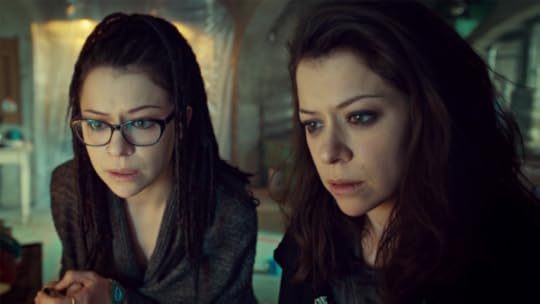 Years: 2013 – 2017 | Seasons: 5 | Episodes: 50 | Genre: Science Fiction, Drama, Triller | Program: BBC
Years: 2013 – 2017 | Seasons: 5 | Episodes: 50 | Genre: Science Fiction, Drama, Triller | Program: BBC
Synopsis:
When con artist, Sarah Manning witnesses the suicide of a woman who appears to be her doppelgänger, Sarah assumes the woman’s identity after her death. However, she isn’t the only doppelgänger that Sarah meets. Soon, Sarah discovers that she is a clone with many “sister” clones spread throughout the globe that are all part of an illegal human cloning experiment. With the help of her foster brother, Felix, Sarah and her other clone “sisters,” strive to survive the capture of the Neolutionists (the progressive scientific organization that created the clones) and the Proletheans (a religious extremist group who believe that clones are abominations and should be destroyed). But when Sarah learns that the assassin the Proletheans hired to kill her and her “sisters” looks just like her, she must do everything in her power to defend her newfound family.
Why You Should Invest:
The driving strength behind of Orphan Black rests squarely on the shoulders of the main actress, Tatiana Maslany. Playing not one, not two, nor even three characters on the show. She portrays six clones, which means she gets the most amount of screen time – Sarah, Helena, Alison, Cosima, Rachel and Beth – in addition to numerous clones with smaller roles. Maslany is so good at providing all six clones with their own traits and personalities, that when you’re watching, it can be easy to forget that it’s the same actress playing all of these different (but identical) characters.
#2: Breaking Bad Years: 2008 – 2013 | Seasons: 5 | Episodes: 62 | Genre: Crime, Drama, Thriller| Program: AMC
Years: 2008 – 2013 | Seasons: 5 | Episodes: 62 | Genre: Crime, Drama, Thriller| Program: AMC
Synopsis:
Walter White is a struggling high school chemistry teacher diagnosed with inoperable lung cancer. In order to secure his family’s financial future he teams up with his former student, Jesse Pinkman to produce, sell and distribute crystallized meth. However, during Walter and Jesse’s first days of selling the drugs, they encounter a series of problems with local drug dealers. Nevertheless, Walter is driven to continue producing meth despite these dangerous setbacks. Even behind his own brother-in-law, who is a DEA agent.
Why You Should Invest:
When Breaking Bad first aired, it threw off so many of the shackles of conventional television. The character of Walter White alone is a compelling protagonist, but also a deeply flawed yet charismatic genius. The tragedy and brilliance of Walter White (played by Bryan Cranston) is that he is a character who we think we know from the start, until he suddenly becomes this violent criminal with no way of returning back to the life he once lived. He hated his life as a high school teacher until he finds purpose and gets hooked on his new secret life as a killer drug lord. The more Walter invests into his criminal life, the deeper he digs into the grim side of the American dream.
#1: Battlestar Galatica Years: 2004 – 2008 | Seasons: 4 | Episodes: 75 | Genre: Science Fiction| Program: Syfy
Years: 2004 – 2008 | Seasons: 4 | Episodes: 75 | Genre: Science Fiction| Program: Syfy
Synopsis:
When a civilization of humans is almost wiped out by a cybernetic race of androids known as the Cylons, there are only 50,000 humans left alive aboard the eponymous military ship, the Battlestar Galactica. The survivors on the ship take up the task of leading the small fugitive fleet into space, trying to outrun the Cylons while also searching for a mythical planet called Earth to recolonize. Oh, but there’s a catch: The Cylons can’t die and they look just like humans, some of whom them are hiding among the fleet!
Why You Should Invest:
Hailed as one of the best Sci-Fi shows ever to air, Battlestar Galactica (known as BSG to the super-die hard fans), is one of the few shows that ushered in new standards in television. Similar to GoT, the qualities of the writing and acting broke new grounds, that offered a prestigious, addictive, and complex show to viewers. Pumped with cool action scenes of gun fights, battle ships and fighter planes, the handheld camera techniques capture the show’s sense of urgency and realism. Great character arcs for major and minor characters, rise or fall; and for a show that had a limited budget for CGI, they pulled off every episode successfully. But the real question keeps nagging you from the very start of the series: Who’s a Cylon, and who can be trusted?
Happy binging!
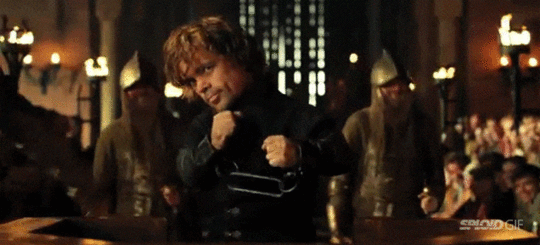
And if there's one thing that I know about GoT fans (like myself), it's that waiting absolutely sucks.
ESPECIALLY after that huge finale!!!
(Have no fear, there are no spoilers in this blog. You're perfectly safe!)
Lucky for us, we live in a unique day and age of television in which we have the privilege of watching reruns of shows like Friends on Netflix, resurrect old shows like Twin Peaks and Arrested Development, and binge watch every episode of Gossip Girl, all with a click of a button.
And while there might not be another TV show out there that shares quite the same adrenaline pumping excitement that each episode of GoT subjects its viewers to, there are still plenty of great television shows out there to keep you distracted as you await Winter's return.
So if you need a new show to satisfy your Game of Thrones craving, maybe invest in these 12 shows – one for every month before GoT comes back next year – to get your fix.
I guarantee you won't be sorry.
 #12: The White Queen
#12: The White Queen
 Year: 2013 | Seasons: 1 | Episodes: 10 | Genre: Historical Fiction | Program: STARZ
Year: 2013 | Seasons: 1 | Episodes: 10 | Genre: Historical Fiction | Program: STARZ Synopsis:
Set against the backdrop of the War of the Roses, The White Queen tells the story of the women involved in the battle for the English throne. It’s 1464, and England has been at war for nine years over who is the rightful King of England. There are two sides of the family who are vying for the crown: the House of York and the House of Lancaster. The story focuses on three women and their quest for power as they manipulate behind the scenes on winning the English throne for themselves. Elizabeth Woodville is the central character who marries into to the House of York. Margaret Beaufort is a widowed mother who gives birth to the last Lancaster heir. And Anne Neville is a daughter who has been used as a chess piece to wage war against both the Yorks and the Lancasters. Who will end up winning?
Why You Should Invest:
Even though The White Queen lacks dragons – *ahem* sorry guys – it makes up for real-world inspiration for many of GoT’s battles, mad monarchs and palace intrigue. Just like GoT, The White Queen displays the dynastic fight for the throne as well as sharing similar personality traits with certain historical figures. There’s a Cersei-esque character in the show, commanding and fiercely devoted to putting her sociopathic son on the throne. Although these aren’t necessarily precise matchups to the characters of GoT, The White Queen also has its own version of a mad king, as well as an exiled heir to the throne. The character correlations is enough to not only help you understand England’s earliest history, but also aid you in seeing some of where George R. R. Martin’s ideas stemmed from.
#11: The White Princess
 Year: 2017 | Seasons: 1 | Episodes: 8 | Genre: Historical Fiction | Program: STARZ
Year: 2017 | Seasons: 1 | Episodes: 8 | Genre: Historical Fiction | Program: STARZSynopsis:
The show starts right after the Battle of Bosworth, where Elizabeth of York (Elizabeth Woodville’s daughter) is forced to marry the new King of England, Henry VII. The purpose of their marriage is to finally end the long-running War of the Roses between the House of York and Lancaster. As queen, Elizabeth of York can assure the safety of her mother and sisters. However, there are many dangers still lurking about that threaten Elizabeth and Henry’s union. Henry ends up imprisoning anyone who claims to be the rightful heir to the throne, while his mother-in-law secretly rallies York supporters to dispose of Henry once and for all.
Why You Should Invest:
Besides the fact that Lady Catelyn Stark plays Henry’s ruthless and devious mother on the show (Michelle Fairley), George R.R. Martin also based his series on many of the politics on the aftermath of The War of the Roses. Filled with schemes, suspicions and the changing family dynamics, The White Princess stands out as more of a feminist version of GoT. As the sequel to The White Queen, The White Princess continues the historical drama between the Yorks and the Lancasters until there is only one true king to rule the realm.
#10: The Tudors
 Years: 2007 – 2010 | Seasons: 4 | Episodes: 38 | Genre: Historical Fiction | Program: Showtime
Years: 2007 – 2010 | Seasons: 4 | Episodes: 38 | Genre: Historical Fiction | Program: Showtime Synopsis:
During the renaissance era in England, Henry VIII is growing desperate for a male heir. He is stuck in a loveless marriage with his current wife, Catherine of Aragon and fears that due to her age, she cannot bare him anymore children. But when Henry meets the beautiful and seductive, Anne Boleyn he becomes obsessed with searching for a way out of his marriage, so he can make Anne his wife. Against this background gyrate the private lives and political intrigues of several members of the royal court and chancery, the Tudors tells the story of one of the most notorious monarchs in all of British history.
Why You Should Invest:
Even though The Tudors isn’t the third installment to The White Queen / White Princess, it nonetheless carries on the gritty drama about the heir to the Tudor throne. The show only lasted four seasons, yet the central story of the Tudors (besides the six wives Henry marries) is the politics and the scandals that hover near the throne. You’ll also recognize Natalie Dormer – whom before she played the ever charming Margaery Tyrell on GoT – got her start on The Tudors by taking up the role of Henry’s second wife, Anne Boleyn.
#9: Downton Abbey
 Years: 2011 – 2015 | Seasons: 6 | Episodes: 52 | Genre: Historical Fiction | Program: PBS
Years: 2011 – 2015 | Seasons: 6 | Episodes: 52 | Genre: Historical Fiction | Program: PBS Synopsis:
Set in the fictional Yorkshire country estate of Downton Abbey, lives the aristocratic Crawley family and their domestic servants in the post-Edwardian era. Robert and Cora Crawley have three daughters but no sons. When their heir presumptive drowns while onboard the Titanic, a distant cousin by the name of Matthew Crawley, suddenly finds himself next in line to inherit the grand estate. But will the Crawley’s eldest daughter, Lady Mary get in his way?
Why You Should Invest:
Helming the story of Downton Abbey is no other than Academy Award winner, Julian Fellowes, who spins his storytelling magic by writing incredible characters who stay with you long after the credits start rolling. If that’s not enough, the cast is anchored by former GoT actors like Rose Leslie and Iain Glen, alongside with Harry Potter alum, Dame Maggie Smith. What makes Downton Abbey such a riveting show is that despite the glamor that the aristocratic Crawley family has to offer, viewers become invested in the servant stories as well. With strict codes of conduct and a rigid order of precedence, the servants and the butlers navigate a world of snobbery and backstabbing that rivals that of the nobility.
#8: Boardwalk Empire
 Years: 2009 – 2014 | Seasons: 5 | Episodes: 56 | Genre: Historical Fiction, Crime | Program: HBO
Years: 2009 – 2014 | Seasons: 5 | Episodes: 56 | Genre: Historical Fiction, Crime | Program: HBOSynopsis:
Taking place amidst the Prohibition era, the story is centered around Nucky Thompson, a politician who also happens to be a mobster, playing both sides to gain in Atlantic City. Due to his lavish lifestyle – thanks to his illegal bootlegging business – the federal government starts looking into him, making his life a bit harder than it already is. Nucky acts with real historical characters in the show, including gangsters, government agents and the common folk who look up to him. However, how long can Nucky live this life before the government catches him in the act?
Why You Should Invest:
There’s an authentic feeling whenever you sit down and watch this show, as if everything was actually shot in the 1920’s. Boardwalk Empire sets a new standard for storytelling, in which everything is far beyond perfect. With a talented and experienced cast, amazing cinematography and twists and turns within every storyline, you wished you grew up in Atlantic City during the 1920’s.
#7: Buffy the Vampire Slayer
 Years: 1997 – 2003 | Seasons: 7 | Episodes: 144 | Genre: Horror, Supernatural Fiction, Fantasy, Action, Teen Drama | Program: The CW
Years: 1997 – 2003 | Seasons: 7 | Episodes: 144 | Genre: Horror, Supernatural Fiction, Fantasy, Action, Teen Drama | Program: The CW
Synopsis:
This supernatural television drama follows Buffy Summers, the latest in a line of young women known as the Vampire Slayers. Buffy is destined to battle against vampires, demons and other forces of darkness, all while maintaining a normal teenage life. With the help of her friends to save the world from all hell breaking loose, Buffy and her gang slay their own demons, survive one apocalypse after another and all while confronting heartbreak and drama.
Why You Should Invest:
Buffy ultimately became one of the biggest cult shows ever after it first aired back in 1997. It balanced fighting evil with high school drama, without becoming overly cheesy. At the time, Buffy was one of the few shows out there that had centered on a strong female character thanks to Sarah Michelle Gellar’s portrayal of the kick-ass slayer. The main feature of the show was the successful interweaving of genres. While some may describe Buffy as a horror, some classified the show under comedy. There hadn’t been many shows that were bold enough to mash two genres together, making Buffy a show that was ahead of its time.
#6: The Sopranos
 Years: 1999 – 2007 | Seasons: 6 | Episodes: 86 | Genre: Drama, Crime | Program: HBO
Years: 1999 – 2007 | Seasons: 6 | Episodes: 86 | Genre: Drama, Crime | Program: HBOSynopsis:
The entire series revolves around a New Jersey Italian-American mobster named Tony Soprano and the difficulties he faces as he tries to balance his home life and his criminal organization. Yet, as he deals with his personal and professional issues, he suffers from extreme panic attacks, forcing him to seek professional psychiatric counseling.
Why You Should Invest:
The character, Tony Soprano smashed all the rules about how much a character could get away with on the small screen. More so, if it wasn’t for The Sopranos’ ambitious storytelling, we wouldn’t have riveting shows like GoT, The Wire and Breaking Bad. You’re welcome. Through six masterful seasons, viewers had been mesmerized by watching this ruthless gangster struggle to keep his work life and personal life separate from each other. He regularly battles with himself, his family and the people around him, yet we still root for him. Regardless of all the horrible things he has done.
#5: The Wire
 Years: 2002 – 2008 | Seasons: 5 | Episodes: 60 | Genre: Drama, Crime | Program: HBO
Years: 2002 – 2008 | Seasons: 5 | Episodes: 60 | Genre: Drama, Crime | Program: HBO
Synopsis:
The entire show takes place in Baltimore, Maryland in which each season introduces a different crime story. From the illegal drug trade to the city government, The Wire primary focus is on the relationship between law enforcement and the struggling working class. Yet, even though each season is different from the last, the show retains characters and advances storylines from previous seasons.
Why You Should Invest:
The Wire was a prime example of how a series can start small before expanding to cover broader issues, but without losing its core and its clarity of framing the perfect story arc. Even though the show aired in the beginning of the 21st century, it still resonates far beyond its setting. What makes this show all the more captivating is that there are no true good guys or bad guys on the show. Almost everyone has ulterior motives, and the true villain in the entire show is the system itself that every character finds themselves trapped by.
#4: Damages
 Years: 2007 – 2010 | Seasons: 5 | Episodes: 59 | Genre: Legal Drama, Crime, Thriller | Program: FX
Years: 2007 – 2010 | Seasons: 5 | Episodes: 59 | Genre: Legal Drama, Crime, Thriller | Program: FXSynopsis:
This legal thriller revolves around the savage lawyer, Patty Hewes and her ambitious protégée, Ellen Parsons as they navigate their way through high-stake litigations. However, the two women become entangled in each other’s professional and private lives, straining their relationship and together facing unpredictable challenges.
Why You Should Invest:
The show jumps around with its storytelling, telling you part of the ending right away while the show starts to slowly put the pieces back together as the season progresses. Damages creates more of a mystery feel for the characters and the audience, rather than a regular law procedural. The show also aired right when Lost was successfully pulling off their own storytelling technique by hinting at each character’s backgrounds via flashbacks. Damages does the same thing – minus the smoke monster – but carries out their story by hitting the viewers with surprises and betrayals.
#3: Orphan Black
 Years: 2013 – 2017 | Seasons: 5 | Episodes: 50 | Genre: Science Fiction, Drama, Triller | Program: BBC
Years: 2013 – 2017 | Seasons: 5 | Episodes: 50 | Genre: Science Fiction, Drama, Triller | Program: BBCSynopsis:
When con artist, Sarah Manning witnesses the suicide of a woman who appears to be her doppelgänger, Sarah assumes the woman’s identity after her death. However, she isn’t the only doppelgänger that Sarah meets. Soon, Sarah discovers that she is a clone with many “sister” clones spread throughout the globe that are all part of an illegal human cloning experiment. With the help of her foster brother, Felix, Sarah and her other clone “sisters,” strive to survive the capture of the Neolutionists (the progressive scientific organization that created the clones) and the Proletheans (a religious extremist group who believe that clones are abominations and should be destroyed). But when Sarah learns that the assassin the Proletheans hired to kill her and her “sisters” looks just like her, she must do everything in her power to defend her newfound family.
Why You Should Invest:
The driving strength behind of Orphan Black rests squarely on the shoulders of the main actress, Tatiana Maslany. Playing not one, not two, nor even three characters on the show. She portrays six clones, which means she gets the most amount of screen time – Sarah, Helena, Alison, Cosima, Rachel and Beth – in addition to numerous clones with smaller roles. Maslany is so good at providing all six clones with their own traits and personalities, that when you’re watching, it can be easy to forget that it’s the same actress playing all of these different (but identical) characters.
#2: Breaking Bad
 Years: 2008 – 2013 | Seasons: 5 | Episodes: 62 | Genre: Crime, Drama, Thriller| Program: AMC
Years: 2008 – 2013 | Seasons: 5 | Episodes: 62 | Genre: Crime, Drama, Thriller| Program: AMCSynopsis:
Walter White is a struggling high school chemistry teacher diagnosed with inoperable lung cancer. In order to secure his family’s financial future he teams up with his former student, Jesse Pinkman to produce, sell and distribute crystallized meth. However, during Walter and Jesse’s first days of selling the drugs, they encounter a series of problems with local drug dealers. Nevertheless, Walter is driven to continue producing meth despite these dangerous setbacks. Even behind his own brother-in-law, who is a DEA agent.
Why You Should Invest:
When Breaking Bad first aired, it threw off so many of the shackles of conventional television. The character of Walter White alone is a compelling protagonist, but also a deeply flawed yet charismatic genius. The tragedy and brilliance of Walter White (played by Bryan Cranston) is that he is a character who we think we know from the start, until he suddenly becomes this violent criminal with no way of returning back to the life he once lived. He hated his life as a high school teacher until he finds purpose and gets hooked on his new secret life as a killer drug lord. The more Walter invests into his criminal life, the deeper he digs into the grim side of the American dream.
#1: Battlestar Galatica
 Years: 2004 – 2008 | Seasons: 4 | Episodes: 75 | Genre: Science Fiction| Program: Syfy
Years: 2004 – 2008 | Seasons: 4 | Episodes: 75 | Genre: Science Fiction| Program: SyfySynopsis:
When a civilization of humans is almost wiped out by a cybernetic race of androids known as the Cylons, there are only 50,000 humans left alive aboard the eponymous military ship, the Battlestar Galactica. The survivors on the ship take up the task of leading the small fugitive fleet into space, trying to outrun the Cylons while also searching for a mythical planet called Earth to recolonize. Oh, but there’s a catch: The Cylons can’t die and they look just like humans, some of whom them are hiding among the fleet!
Why You Should Invest:
Hailed as one of the best Sci-Fi shows ever to air, Battlestar Galactica (known as BSG to the super-die hard fans), is one of the few shows that ushered in new standards in television. Similar to GoT, the qualities of the writing and acting broke new grounds, that offered a prestigious, addictive, and complex show to viewers. Pumped with cool action scenes of gun fights, battle ships and fighter planes, the handheld camera techniques capture the show’s sense of urgency and realism. Great character arcs for major and minor characters, rise or fall; and for a show that had a limited budget for CGI, they pulled off every episode successfully. But the real question keeps nagging you from the very start of the series: Who’s a Cylon, and who can be trusted?
Happy binging!

Published on August 25, 2017 06:19
July 27, 2017
10 Classic Novels To Get You Into That Summer Mood
Whether you're planning on taking a beach break this summer or just want to unwind with a good read – as you blast the air conditioning in your room – why not revisit some of the most classical novels to kick-up that good old nostalgia?
With the few months that we have left of summer, there are so many good reads for the lazy days ahead.
Books that involve the wondrous season of summer, novels that sneak up on you with unnerving twists and turns, or just stories that take you back to your childhood days.
Here are 10 classic books that will definitely stir up those summer emotions. #10: The Valley of the Dolls by Jacqueline Susann
#10: The Valley of the Dolls by Jacqueline Susann
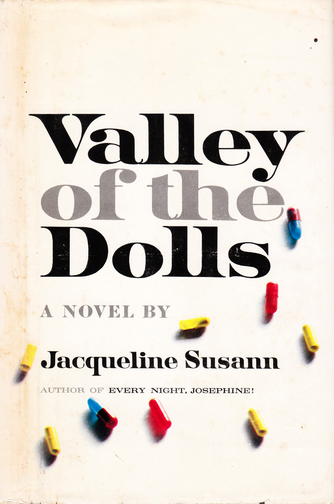 If you ever wondered where authors like Jackie Collins and Danielle Steel got their inspiration from, it was all thanks to Susann’s instant bestseller, The Valley of the Dolls. Susann’s novel is a classic in the sense that it is the original “trashy" novel. Published in 1966, The Valley of the Dolls tells the story about the friendship between three women, the perils and rewards of fame, and drugs. A lot of drugs. The novel spans over twenty years, from 1945 to 1965. Set in New York City, Anne Welles, Neely O’Hara, and Jennifer North become fast friends and roommates. The pages are jam-packed with sex, lies, scandals and of course, DOLLS. “Dolls” are the delightfully euphemistic name give to the pills that help all three of the women deal with the horrific messes that each of their lives ultimately become. While the novel is woefully short on style and character development, it nonetheless delivers an intriguing plot.
If you ever wondered where authors like Jackie Collins and Danielle Steel got their inspiration from, it was all thanks to Susann’s instant bestseller, The Valley of the Dolls. Susann’s novel is a classic in the sense that it is the original “trashy" novel. Published in 1966, The Valley of the Dolls tells the story about the friendship between three women, the perils and rewards of fame, and drugs. A lot of drugs. The novel spans over twenty years, from 1945 to 1965. Set in New York City, Anne Welles, Neely O’Hara, and Jennifer North become fast friends and roommates. The pages are jam-packed with sex, lies, scandals and of course, DOLLS. “Dolls” are the delightfully euphemistic name give to the pills that help all three of the women deal with the horrific messes that each of their lives ultimately become. While the novel is woefully short on style and character development, it nonetheless delivers an intriguing plot.
#9: Lolita by Vladimir Nabokov Yes. It’s that deliciously dirty novel that you’ve had your eye on all year long. But if you haven’t gotten around to reading it – let alone never even heard someone explain the plot to you – you’re in for an unconventional story. After spending many years on the Riviera, Humbert Humbert comes to the United States and takes up room and board in a house belonging to a widow in a sleepy, suburban New England town. He becomes instantly infatuated with the widow’s twelve-year-old daughter Dolores (AKA Lolita) and falls in love with her. Oh, and this guy Humbert, is a 37-year-old man. While the story of Lolita is just as distasteful as its narrator, the language in the novel triumphs over the shocking content and gives it shades of beauty that perhaps it does not deserve. Work your way past the sex and the disturbing descriptions, and you yourself might fall victim to Humbert’s enchanting form of literary allusions and linguistic patterns.
Yes. It’s that deliciously dirty novel that you’ve had your eye on all year long. But if you haven’t gotten around to reading it – let alone never even heard someone explain the plot to you – you’re in for an unconventional story. After spending many years on the Riviera, Humbert Humbert comes to the United States and takes up room and board in a house belonging to a widow in a sleepy, suburban New England town. He becomes instantly infatuated with the widow’s twelve-year-old daughter Dolores (AKA Lolita) and falls in love with her. Oh, and this guy Humbert, is a 37-year-old man. While the story of Lolita is just as distasteful as its narrator, the language in the novel triumphs over the shocking content and gives it shades of beauty that perhaps it does not deserve. Work your way past the sex and the disturbing descriptions, and you yourself might fall victim to Humbert’s enchanting form of literary allusions and linguistic patterns.
#8: The Virgin Suicides by Jeffrey Eugenides Teenage torment gets redefined in Eugenides’s classic, The Virgin Suicides. Five sisters are held like prisoners in their house by their domineering, repressive mother. As the sisters begin to the waste away in hopelessness and isolation, they eventually kill themselves. Their suicide sparks a group of teenage boys who end up spending the rest of their lives trying to figure out what happened to the girls. Part coming-of-age story and party tragedy, Eugenides expands his story to detail the decline of the American dream and the facade of the family nucleus in a 1970’s suburban community.
Teenage torment gets redefined in Eugenides’s classic, The Virgin Suicides. Five sisters are held like prisoners in their house by their domineering, repressive mother. As the sisters begin to the waste away in hopelessness and isolation, they eventually kill themselves. Their suicide sparks a group of teenage boys who end up spending the rest of their lives trying to figure out what happened to the girls. Part coming-of-age story and party tragedy, Eugenides expands his story to detail the decline of the American dream and the facade of the family nucleus in a 1970’s suburban community.
#7: In Cold Blood by Truman Capote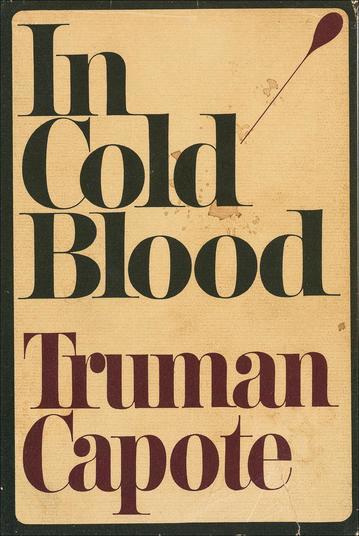 Capote’s spine-tingling tale tells the true story of the murder of the Clutter family in Holcomb, Kansas in 1959. While the book is written as if it were a novel – complete with re-created dialogue – the genius behind the storytelling in In Cold Blood resides with the author himself. Capote went out of his way to understand this brutal crime. He spent the next six years interviewing everyone involved in the investigation, even committing many hours to sitting down with the killers and developing a personal relationship with them. This beautifully-written true page-turner is chalk-full of vivid characterization and gorgeous prose. More so, the novel also forces the reader to wonder who to trust. While Capote doesn’t give you the answer in his book, he does get inside the minds of the two murderers and and tries to figure out what primarily drove them to kill.
Capote’s spine-tingling tale tells the true story of the murder of the Clutter family in Holcomb, Kansas in 1959. While the book is written as if it were a novel – complete with re-created dialogue – the genius behind the storytelling in In Cold Blood resides with the author himself. Capote went out of his way to understand this brutal crime. He spent the next six years interviewing everyone involved in the investigation, even committing many hours to sitting down with the killers and developing a personal relationship with them. This beautifully-written true page-turner is chalk-full of vivid characterization and gorgeous prose. More so, the novel also forces the reader to wonder who to trust. While Capote doesn’t give you the answer in his book, he does get inside the minds of the two murderers and and tries to figure out what primarily drove them to kill.
#6: Lord of the Flies by William Golding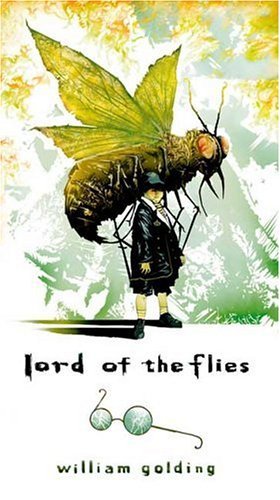 Taking a break from the jolly sunshine and childhood innocence, Lord of the Flies will make you feel anything but cheerful while you’re out tanning by the beach. After surviving a plane crash in the Pacific Ocean, a group of schoolboys find themselves on a desert island and struggle to survive. However, with the absence of adults under the baking sun, the boys descend into madness. As the heat, lack of authority and temptation devour them, the boy’s childish games turn into a disturbing, psychological story. While their boyhood progresses from well-behaved orderly children to bloodthirsty hunters, Golding portrays the boy’s loss of innocence from within, as each of the boys accepts the savagery that had always existed within them.
Taking a break from the jolly sunshine and childhood innocence, Lord of the Flies will make you feel anything but cheerful while you’re out tanning by the beach. After surviving a plane crash in the Pacific Ocean, a group of schoolboys find themselves on a desert island and struggle to survive. However, with the absence of adults under the baking sun, the boys descend into madness. As the heat, lack of authority and temptation devour them, the boy’s childish games turn into a disturbing, psychological story. While their boyhood progresses from well-behaved orderly children to bloodthirsty hunters, Golding portrays the boy’s loss of innocence from within, as each of the boys accepts the savagery that had always existed within them.
#5: The Adventures of Tom Sawyer and The Adventures of Huckleberry Finn by Mark Twain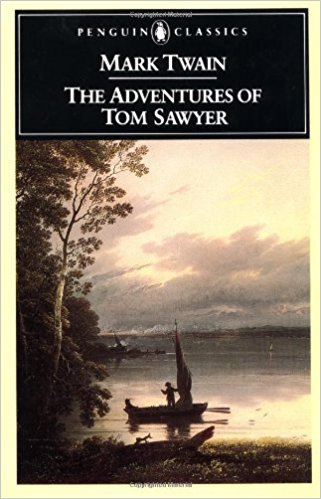
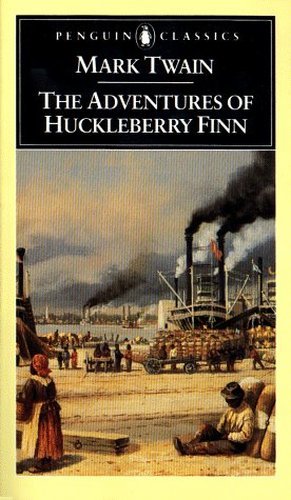 Both of Mark Twain’s classic novels include carefree summers full of mischief, adventures and friendships. Thanks to the endlessly funny hijinks of the characters, Tom and Huck, Twain makes sure that his stories are packed with excitement. In The Adventures of Tom Sawyer, Tom is the pinnacle of naughty boys, driving his Aunt Polly insane with punishments for Tom up the wazoo. But there is also a caring side to Tom. He becomes a hopeless romantic when he falls in love with the Judge’s daughter, Becky Thatcher. As Tom continues with his carefree life he suddenly becomes a witness to a murder, shifting his story into an entirely darker realm. The Adventures of Huckleberry Finn is a kind of sequel to the Tom Sawyer saga. While the majority of the story tells Huck’s backstory about his wino of a father, “Pap,” the real story is Huck’s adventure with Jim, a slave on the lam who strikes up a friendship with Huck. Tom and Huck’s stories are invested with so much nostalgia and so much feelings of youth and it transcends boundaries of youth and adulthood. If you could get past the dated language and the Twain-geared phonetic dialogue, you can appreciate how both novels detail the descriptions of the lazy summer days in the Deep South.
Both of Mark Twain’s classic novels include carefree summers full of mischief, adventures and friendships. Thanks to the endlessly funny hijinks of the characters, Tom and Huck, Twain makes sure that his stories are packed with excitement. In The Adventures of Tom Sawyer, Tom is the pinnacle of naughty boys, driving his Aunt Polly insane with punishments for Tom up the wazoo. But there is also a caring side to Tom. He becomes a hopeless romantic when he falls in love with the Judge’s daughter, Becky Thatcher. As Tom continues with his carefree life he suddenly becomes a witness to a murder, shifting his story into an entirely darker realm. The Adventures of Huckleberry Finn is a kind of sequel to the Tom Sawyer saga. While the majority of the story tells Huck’s backstory about his wino of a father, “Pap,” the real story is Huck’s adventure with Jim, a slave on the lam who strikes up a friendship with Huck. Tom and Huck’s stories are invested with so much nostalgia and so much feelings of youth and it transcends boundaries of youth and adulthood. If you could get past the dated language and the Twain-geared phonetic dialogue, you can appreciate how both novels detail the descriptions of the lazy summer days in the Deep South.
#4: The Talented Mr. Ripley by Patricia Highsmith
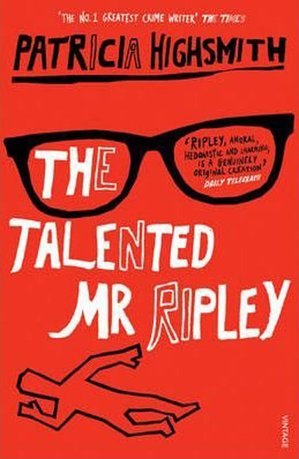 Nothing really captures the fleeting feeling of summer than that of the pages of Patricia Highsmith’s psychological thriller. Meet Tom Ripley, an unhappy orphan who was raised by his icy tumultuous aunt. Now at the age of 23, and living in New York City, Tom is just trying to get through life via casual extortion. That is until he’s approached by the wealthy Herbert Greenleaf, father of an acquaintance, Dickie. Greenleaf is looking for someone who might persuade his son to return home from the bohemian life he’s been leading in the Italian village of Mongibello, and Tom seizes the opportunity. But what he finds when locates Dickie is something he hadn’t expected: a glimpse of the privileged existence he’s always dreamed of. Highsmith’s descriptions of Italy feel like an endless summer. That is until, Tom finds himself envious of Dickie’s life and schemes to steal it for himself.
Nothing really captures the fleeting feeling of summer than that of the pages of Patricia Highsmith’s psychological thriller. Meet Tom Ripley, an unhappy orphan who was raised by his icy tumultuous aunt. Now at the age of 23, and living in New York City, Tom is just trying to get through life via casual extortion. That is until he’s approached by the wealthy Herbert Greenleaf, father of an acquaintance, Dickie. Greenleaf is looking for someone who might persuade his son to return home from the bohemian life he’s been leading in the Italian village of Mongibello, and Tom seizes the opportunity. But what he finds when locates Dickie is something he hadn’t expected: a glimpse of the privileged existence he’s always dreamed of. Highsmith’s descriptions of Italy feel like an endless summer. That is until, Tom finds himself envious of Dickie’s life and schemes to steal it for himself.
#3: Treasure Island by Robert Louis Stevenson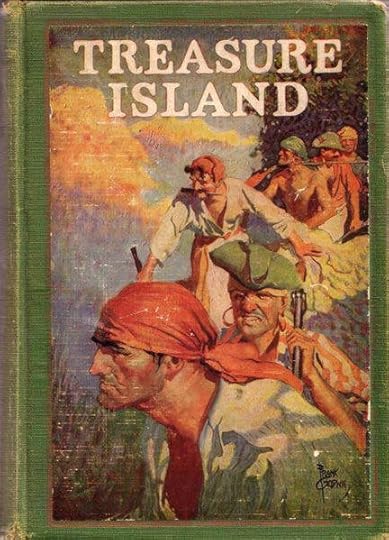 There is no better book that has perfected the beach book formula than Robert Louis Stevenson’s Treasure Island. Serving up a tale gripping enough to be sampled from a hammock or a lounge chair, Treasure Island (if you’d never seen Muppet Treasure Island) tells the story of young Jim Hawkins who finds a map to an island where the pirate Flint has buried a vast treasure. Jim, along with the help of the local physician and the district squire set voyage to the island, only to discover that the majority of the crew on the ship are pirates who have planned a mutiny. Stevenson’s whimsical tale also weaves in a complex coming-of-age story with evil, yet also likable characters. His book reminds us that villains are just people who chose a different route to get what they want.
There is no better book that has perfected the beach book formula than Robert Louis Stevenson’s Treasure Island. Serving up a tale gripping enough to be sampled from a hammock or a lounge chair, Treasure Island (if you’d never seen Muppet Treasure Island) tells the story of young Jim Hawkins who finds a map to an island where the pirate Flint has buried a vast treasure. Jim, along with the help of the local physician and the district squire set voyage to the island, only to discover that the majority of the crew on the ship are pirates who have planned a mutiny. Stevenson’s whimsical tale also weaves in a complex coming-of-age story with evil, yet also likable characters. His book reminds us that villains are just people who chose a different route to get what they want.
#2: To Kill a Mockingbird by Harper Lee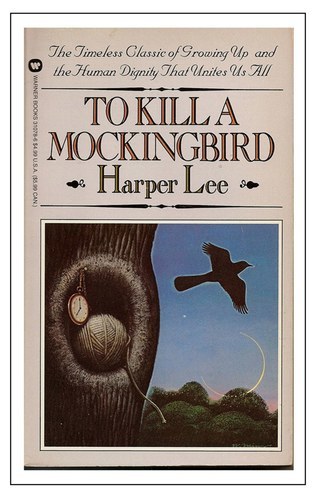 If you’re looking for another tale under the hot southern sun, look no further than Harper Lee’s tour de force of a novel, To Kill a Mockingbird. While this book should’ve been on some – if not all – of your high school summer reading lists, TKAM never ceases to grow boring nor obsolete. With an exciting but thought-provoking plot and a cast of memorable characters, there’s a reason why this novel has earned its spot in the hearts of readers. At the beginning of the novel, Scout is an innocent, good-hearted five-year-old child who has no experience with the evils of the world. But when her father, Atticus Finch (a respected lawyer in their hometown of Maycomb, Alabama) defends a black man named Tom Robinson against fabricated rape charges, Scout’s perspective on life develops from that of an innocent child into that of a near grown-up.
If you’re looking for another tale under the hot southern sun, look no further than Harper Lee’s tour de force of a novel, To Kill a Mockingbird. While this book should’ve been on some – if not all – of your high school summer reading lists, TKAM never ceases to grow boring nor obsolete. With an exciting but thought-provoking plot and a cast of memorable characters, there’s a reason why this novel has earned its spot in the hearts of readers. At the beginning of the novel, Scout is an innocent, good-hearted five-year-old child who has no experience with the evils of the world. But when her father, Atticus Finch (a respected lawyer in their hometown of Maycomb, Alabama) defends a black man named Tom Robinson against fabricated rape charges, Scout’s perspective on life develops from that of an innocent child into that of a near grown-up.
#1: The Great Gatsby by F. Scott Fitzgerald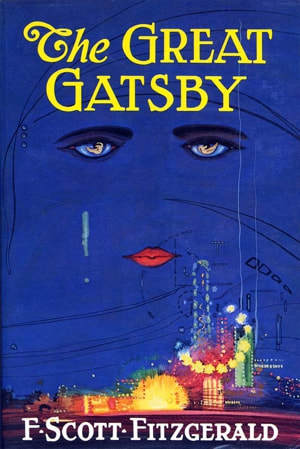 Is there any other book that captures summer in New York more accurately than The Great Gatsby? Not to mention that all of the events in the book take place during a sweltering summer in the 1920’s. Add that with prohibition, doomed love and wild, unimaginable parties, you've got yourself a summer read you won’t soon forget. When midwest native Nick Carraway arrives to New York City to spend the summer with his cousin, Daisy and her philandering husband, Tom Buchanan, he finds his neighbor to be none other than millionaire, Jay Gatsby. Thus, Nick becomes drawn into the captivating world of wealthy and attending glitzy parties. But the longer he stays with Gatsby, the more he becomes a witness to the upper-class’s illusions of deceit.
Is there any other book that captures summer in New York more accurately than The Great Gatsby? Not to mention that all of the events in the book take place during a sweltering summer in the 1920’s. Add that with prohibition, doomed love and wild, unimaginable parties, you've got yourself a summer read you won’t soon forget. When midwest native Nick Carraway arrives to New York City to spend the summer with his cousin, Daisy and her philandering husband, Tom Buchanan, he finds his neighbor to be none other than millionaire, Jay Gatsby. Thus, Nick becomes drawn into the captivating world of wealthy and attending glitzy parties. But the longer he stays with Gatsby, the more he becomes a witness to the upper-class’s illusions of deceit.
Keep it cool (and classy) this summer!
With the few months that we have left of summer, there are so many good reads for the lazy days ahead.
Books that involve the wondrous season of summer, novels that sneak up on you with unnerving twists and turns, or just stories that take you back to your childhood days.
Here are 10 classic books that will definitely stir up those summer emotions.
 #10: The Valley of the Dolls by Jacqueline Susann
#10: The Valley of the Dolls by Jacqueline Susann
 If you ever wondered where authors like Jackie Collins and Danielle Steel got their inspiration from, it was all thanks to Susann’s instant bestseller, The Valley of the Dolls. Susann’s novel is a classic in the sense that it is the original “trashy" novel. Published in 1966, The Valley of the Dolls tells the story about the friendship between three women, the perils and rewards of fame, and drugs. A lot of drugs. The novel spans over twenty years, from 1945 to 1965. Set in New York City, Anne Welles, Neely O’Hara, and Jennifer North become fast friends and roommates. The pages are jam-packed with sex, lies, scandals and of course, DOLLS. “Dolls” are the delightfully euphemistic name give to the pills that help all three of the women deal with the horrific messes that each of their lives ultimately become. While the novel is woefully short on style and character development, it nonetheless delivers an intriguing plot.
If you ever wondered where authors like Jackie Collins and Danielle Steel got their inspiration from, it was all thanks to Susann’s instant bestseller, The Valley of the Dolls. Susann’s novel is a classic in the sense that it is the original “trashy" novel. Published in 1966, The Valley of the Dolls tells the story about the friendship between three women, the perils and rewards of fame, and drugs. A lot of drugs. The novel spans over twenty years, from 1945 to 1965. Set in New York City, Anne Welles, Neely O’Hara, and Jennifer North become fast friends and roommates. The pages are jam-packed with sex, lies, scandals and of course, DOLLS. “Dolls” are the delightfully euphemistic name give to the pills that help all three of the women deal with the horrific messes that each of their lives ultimately become. While the novel is woefully short on style and character development, it nonetheless delivers an intriguing plot. #9: Lolita by Vladimir Nabokov
 Yes. It’s that deliciously dirty novel that you’ve had your eye on all year long. But if you haven’t gotten around to reading it – let alone never even heard someone explain the plot to you – you’re in for an unconventional story. After spending many years on the Riviera, Humbert Humbert comes to the United States and takes up room and board in a house belonging to a widow in a sleepy, suburban New England town. He becomes instantly infatuated with the widow’s twelve-year-old daughter Dolores (AKA Lolita) and falls in love with her. Oh, and this guy Humbert, is a 37-year-old man. While the story of Lolita is just as distasteful as its narrator, the language in the novel triumphs over the shocking content and gives it shades of beauty that perhaps it does not deserve. Work your way past the sex and the disturbing descriptions, and you yourself might fall victim to Humbert’s enchanting form of literary allusions and linguistic patterns.
Yes. It’s that deliciously dirty novel that you’ve had your eye on all year long. But if you haven’t gotten around to reading it – let alone never even heard someone explain the plot to you – you’re in for an unconventional story. After spending many years on the Riviera, Humbert Humbert comes to the United States and takes up room and board in a house belonging to a widow in a sleepy, suburban New England town. He becomes instantly infatuated with the widow’s twelve-year-old daughter Dolores (AKA Lolita) and falls in love with her. Oh, and this guy Humbert, is a 37-year-old man. While the story of Lolita is just as distasteful as its narrator, the language in the novel triumphs over the shocking content and gives it shades of beauty that perhaps it does not deserve. Work your way past the sex and the disturbing descriptions, and you yourself might fall victim to Humbert’s enchanting form of literary allusions and linguistic patterns.#8: The Virgin Suicides by Jeffrey Eugenides
 Teenage torment gets redefined in Eugenides’s classic, The Virgin Suicides. Five sisters are held like prisoners in their house by their domineering, repressive mother. As the sisters begin to the waste away in hopelessness and isolation, they eventually kill themselves. Their suicide sparks a group of teenage boys who end up spending the rest of their lives trying to figure out what happened to the girls. Part coming-of-age story and party tragedy, Eugenides expands his story to detail the decline of the American dream and the facade of the family nucleus in a 1970’s suburban community.
Teenage torment gets redefined in Eugenides’s classic, The Virgin Suicides. Five sisters are held like prisoners in their house by their domineering, repressive mother. As the sisters begin to the waste away in hopelessness and isolation, they eventually kill themselves. Their suicide sparks a group of teenage boys who end up spending the rest of their lives trying to figure out what happened to the girls. Part coming-of-age story and party tragedy, Eugenides expands his story to detail the decline of the American dream and the facade of the family nucleus in a 1970’s suburban community. #7: In Cold Blood by Truman Capote
 Capote’s spine-tingling tale tells the true story of the murder of the Clutter family in Holcomb, Kansas in 1959. While the book is written as if it were a novel – complete with re-created dialogue – the genius behind the storytelling in In Cold Blood resides with the author himself. Capote went out of his way to understand this brutal crime. He spent the next six years interviewing everyone involved in the investigation, even committing many hours to sitting down with the killers and developing a personal relationship with them. This beautifully-written true page-turner is chalk-full of vivid characterization and gorgeous prose. More so, the novel also forces the reader to wonder who to trust. While Capote doesn’t give you the answer in his book, he does get inside the minds of the two murderers and and tries to figure out what primarily drove them to kill.
Capote’s spine-tingling tale tells the true story of the murder of the Clutter family in Holcomb, Kansas in 1959. While the book is written as if it were a novel – complete with re-created dialogue – the genius behind the storytelling in In Cold Blood resides with the author himself. Capote went out of his way to understand this brutal crime. He spent the next six years interviewing everyone involved in the investigation, even committing many hours to sitting down with the killers and developing a personal relationship with them. This beautifully-written true page-turner is chalk-full of vivid characterization and gorgeous prose. More so, the novel also forces the reader to wonder who to trust. While Capote doesn’t give you the answer in his book, he does get inside the minds of the two murderers and and tries to figure out what primarily drove them to kill.#6: Lord of the Flies by William Golding
 Taking a break from the jolly sunshine and childhood innocence, Lord of the Flies will make you feel anything but cheerful while you’re out tanning by the beach. After surviving a plane crash in the Pacific Ocean, a group of schoolboys find themselves on a desert island and struggle to survive. However, with the absence of adults under the baking sun, the boys descend into madness. As the heat, lack of authority and temptation devour them, the boy’s childish games turn into a disturbing, psychological story. While their boyhood progresses from well-behaved orderly children to bloodthirsty hunters, Golding portrays the boy’s loss of innocence from within, as each of the boys accepts the savagery that had always existed within them.
Taking a break from the jolly sunshine and childhood innocence, Lord of the Flies will make you feel anything but cheerful while you’re out tanning by the beach. After surviving a plane crash in the Pacific Ocean, a group of schoolboys find themselves on a desert island and struggle to survive. However, with the absence of adults under the baking sun, the boys descend into madness. As the heat, lack of authority and temptation devour them, the boy’s childish games turn into a disturbing, psychological story. While their boyhood progresses from well-behaved orderly children to bloodthirsty hunters, Golding portrays the boy’s loss of innocence from within, as each of the boys accepts the savagery that had always existed within them.#5: The Adventures of Tom Sawyer and The Adventures of Huckleberry Finn by Mark Twain

 Both of Mark Twain’s classic novels include carefree summers full of mischief, adventures and friendships. Thanks to the endlessly funny hijinks of the characters, Tom and Huck, Twain makes sure that his stories are packed with excitement. In The Adventures of Tom Sawyer, Tom is the pinnacle of naughty boys, driving his Aunt Polly insane with punishments for Tom up the wazoo. But there is also a caring side to Tom. He becomes a hopeless romantic when he falls in love with the Judge’s daughter, Becky Thatcher. As Tom continues with his carefree life he suddenly becomes a witness to a murder, shifting his story into an entirely darker realm. The Adventures of Huckleberry Finn is a kind of sequel to the Tom Sawyer saga. While the majority of the story tells Huck’s backstory about his wino of a father, “Pap,” the real story is Huck’s adventure with Jim, a slave on the lam who strikes up a friendship with Huck. Tom and Huck’s stories are invested with so much nostalgia and so much feelings of youth and it transcends boundaries of youth and adulthood. If you could get past the dated language and the Twain-geared phonetic dialogue, you can appreciate how both novels detail the descriptions of the lazy summer days in the Deep South.
Both of Mark Twain’s classic novels include carefree summers full of mischief, adventures and friendships. Thanks to the endlessly funny hijinks of the characters, Tom and Huck, Twain makes sure that his stories are packed with excitement. In The Adventures of Tom Sawyer, Tom is the pinnacle of naughty boys, driving his Aunt Polly insane with punishments for Tom up the wazoo. But there is also a caring side to Tom. He becomes a hopeless romantic when he falls in love with the Judge’s daughter, Becky Thatcher. As Tom continues with his carefree life he suddenly becomes a witness to a murder, shifting his story into an entirely darker realm. The Adventures of Huckleberry Finn is a kind of sequel to the Tom Sawyer saga. While the majority of the story tells Huck’s backstory about his wino of a father, “Pap,” the real story is Huck’s adventure with Jim, a slave on the lam who strikes up a friendship with Huck. Tom and Huck’s stories are invested with so much nostalgia and so much feelings of youth and it transcends boundaries of youth and adulthood. If you could get past the dated language and the Twain-geared phonetic dialogue, you can appreciate how both novels detail the descriptions of the lazy summer days in the Deep South.#4: The Talented Mr. Ripley by Patricia Highsmith
 Nothing really captures the fleeting feeling of summer than that of the pages of Patricia Highsmith’s psychological thriller. Meet Tom Ripley, an unhappy orphan who was raised by his icy tumultuous aunt. Now at the age of 23, and living in New York City, Tom is just trying to get through life via casual extortion. That is until he’s approached by the wealthy Herbert Greenleaf, father of an acquaintance, Dickie. Greenleaf is looking for someone who might persuade his son to return home from the bohemian life he’s been leading in the Italian village of Mongibello, and Tom seizes the opportunity. But what he finds when locates Dickie is something he hadn’t expected: a glimpse of the privileged existence he’s always dreamed of. Highsmith’s descriptions of Italy feel like an endless summer. That is until, Tom finds himself envious of Dickie’s life and schemes to steal it for himself.
Nothing really captures the fleeting feeling of summer than that of the pages of Patricia Highsmith’s psychological thriller. Meet Tom Ripley, an unhappy orphan who was raised by his icy tumultuous aunt. Now at the age of 23, and living in New York City, Tom is just trying to get through life via casual extortion. That is until he’s approached by the wealthy Herbert Greenleaf, father of an acquaintance, Dickie. Greenleaf is looking for someone who might persuade his son to return home from the bohemian life he’s been leading in the Italian village of Mongibello, and Tom seizes the opportunity. But what he finds when locates Dickie is something he hadn’t expected: a glimpse of the privileged existence he’s always dreamed of. Highsmith’s descriptions of Italy feel like an endless summer. That is until, Tom finds himself envious of Dickie’s life and schemes to steal it for himself. #3: Treasure Island by Robert Louis Stevenson
 There is no better book that has perfected the beach book formula than Robert Louis Stevenson’s Treasure Island. Serving up a tale gripping enough to be sampled from a hammock or a lounge chair, Treasure Island (if you’d never seen Muppet Treasure Island) tells the story of young Jim Hawkins who finds a map to an island where the pirate Flint has buried a vast treasure. Jim, along with the help of the local physician and the district squire set voyage to the island, only to discover that the majority of the crew on the ship are pirates who have planned a mutiny. Stevenson’s whimsical tale also weaves in a complex coming-of-age story with evil, yet also likable characters. His book reminds us that villains are just people who chose a different route to get what they want.
There is no better book that has perfected the beach book formula than Robert Louis Stevenson’s Treasure Island. Serving up a tale gripping enough to be sampled from a hammock or a lounge chair, Treasure Island (if you’d never seen Muppet Treasure Island) tells the story of young Jim Hawkins who finds a map to an island where the pirate Flint has buried a vast treasure. Jim, along with the help of the local physician and the district squire set voyage to the island, only to discover that the majority of the crew on the ship are pirates who have planned a mutiny. Stevenson’s whimsical tale also weaves in a complex coming-of-age story with evil, yet also likable characters. His book reminds us that villains are just people who chose a different route to get what they want. #2: To Kill a Mockingbird by Harper Lee
 If you’re looking for another tale under the hot southern sun, look no further than Harper Lee’s tour de force of a novel, To Kill a Mockingbird. While this book should’ve been on some – if not all – of your high school summer reading lists, TKAM never ceases to grow boring nor obsolete. With an exciting but thought-provoking plot and a cast of memorable characters, there’s a reason why this novel has earned its spot in the hearts of readers. At the beginning of the novel, Scout is an innocent, good-hearted five-year-old child who has no experience with the evils of the world. But when her father, Atticus Finch (a respected lawyer in their hometown of Maycomb, Alabama) defends a black man named Tom Robinson against fabricated rape charges, Scout’s perspective on life develops from that of an innocent child into that of a near grown-up.
If you’re looking for another tale under the hot southern sun, look no further than Harper Lee’s tour de force of a novel, To Kill a Mockingbird. While this book should’ve been on some – if not all – of your high school summer reading lists, TKAM never ceases to grow boring nor obsolete. With an exciting but thought-provoking plot and a cast of memorable characters, there’s a reason why this novel has earned its spot in the hearts of readers. At the beginning of the novel, Scout is an innocent, good-hearted five-year-old child who has no experience with the evils of the world. But when her father, Atticus Finch (a respected lawyer in their hometown of Maycomb, Alabama) defends a black man named Tom Robinson against fabricated rape charges, Scout’s perspective on life develops from that of an innocent child into that of a near grown-up.#1: The Great Gatsby by F. Scott Fitzgerald
 Is there any other book that captures summer in New York more accurately than The Great Gatsby? Not to mention that all of the events in the book take place during a sweltering summer in the 1920’s. Add that with prohibition, doomed love and wild, unimaginable parties, you've got yourself a summer read you won’t soon forget. When midwest native Nick Carraway arrives to New York City to spend the summer with his cousin, Daisy and her philandering husband, Tom Buchanan, he finds his neighbor to be none other than millionaire, Jay Gatsby. Thus, Nick becomes drawn into the captivating world of wealthy and attending glitzy parties. But the longer he stays with Gatsby, the more he becomes a witness to the upper-class’s illusions of deceit.
Is there any other book that captures summer in New York more accurately than The Great Gatsby? Not to mention that all of the events in the book take place during a sweltering summer in the 1920’s. Add that with prohibition, doomed love and wild, unimaginable parties, you've got yourself a summer read you won’t soon forget. When midwest native Nick Carraway arrives to New York City to spend the summer with his cousin, Daisy and her philandering husband, Tom Buchanan, he finds his neighbor to be none other than millionaire, Jay Gatsby. Thus, Nick becomes drawn into the captivating world of wealthy and attending glitzy parties. But the longer he stays with Gatsby, the more he becomes a witness to the upper-class’s illusions of deceit. Keep it cool (and classy) this summer!

Published on July 27, 2017 10:35
June 28, 2017
Brunching in Boston
One of my most favorite memories at Mount Holyoke, was the brunches.
Served every Sunday, the playful combination of "breakfast" and "lunch" was without a doubt the most important meal of the entire week. There wasn't a single person who did not want to brunch with their friends and family members and socialize over French Toast with a side of cantaloupe.
Since leaving Mount Holyoke, a whole new brunching world has opened up for me in the Boston area. While my inner-college self still believes that the crepes at Abbey-Buck's dining hall were the best things ever to grace the campus for brunch, both Boston and Cambridge are homes to some of the best quality brunch spots in the city.
So if you're looking to carry on the tradition of Sunday Brunch, here are some tasty options to rally your friends to go to one of these many venues. #10: The Playwright
#10: The Playwright
658 E Broadway
Boston, MA 02127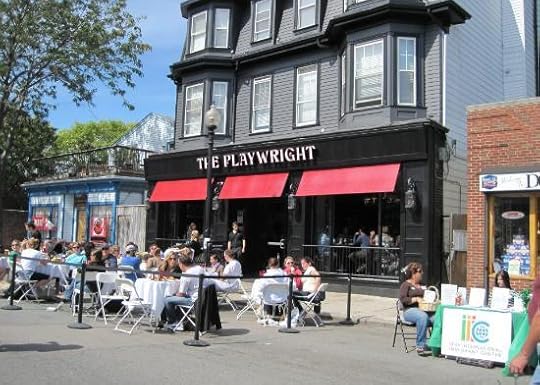 If you’re looking for a simple brunch spot that’s not overly expensive but still buzzing with activity, The Playwright is your joint. Hailed as Southie’s favorite neighborhood bar, The Playwright holds a friendly sports inspired atmosphere, making it the perfect place to root for your favorite teams while enjoying your brunch at the bar. It’s hearty brunch menu includes Croque-Madame, the Mexican omelet and the Steak and Eggs. Plus, you can even complete your brunch with either a $5 mimosa or The Playwright’s signature champagne punch.
If you’re looking for a simple brunch spot that’s not overly expensive but still buzzing with activity, The Playwright is your joint. Hailed as Southie’s favorite neighborhood bar, The Playwright holds a friendly sports inspired atmosphere, making it the perfect place to root for your favorite teams while enjoying your brunch at the bar. It’s hearty brunch menu includes Croque-Madame, the Mexican omelet and the Steak and Eggs. Plus, you can even complete your brunch with either a $5 mimosa or The Playwright’s signature champagne punch.
#9: East Coast Grill
271 Cambridge St.
Cambridge, MA 02139 A year ago, East Coast Grill had closed its doors after a three-decade run in Inman Square. But thanks to Mark Romano and Marci Joy, the husband-and-wife team behind Somerville’s Highland Kitchen, the restaurant has been revived once again in the Cambridge neighborhood. Despite its laid back ambiance, East Coast Grill is anything but nonchalant. East Coast Grill is the home to some serious spicy dishes, such as the Banana Rellena – an innovative plate featuring smoked pork stuffed inside a roasted banana, topped with house-made Scotch bonnet peppers. The sweetness of the banana helps tame the hot sauce, but is fierce enough to down your entire mango margarita. The other go-to favorites are the Buttermilk Fried Chicken Sandwich, made with pickled relish, shredded iceberg lettuce, chipotle ranch and jack cheese. Or the Burnt Ends of Beef Brisket with smoked onions. If you’re looking for a little fiery flavor to dance along your tastebuds, East Coast Grill can happily set you up.
A year ago, East Coast Grill had closed its doors after a three-decade run in Inman Square. But thanks to Mark Romano and Marci Joy, the husband-and-wife team behind Somerville’s Highland Kitchen, the restaurant has been revived once again in the Cambridge neighborhood. Despite its laid back ambiance, East Coast Grill is anything but nonchalant. East Coast Grill is the home to some serious spicy dishes, such as the Banana Rellena – an innovative plate featuring smoked pork stuffed inside a roasted banana, topped with house-made Scotch bonnet peppers. The sweetness of the banana helps tame the hot sauce, but is fierce enough to down your entire mango margarita. The other go-to favorites are the Buttermilk Fried Chicken Sandwich, made with pickled relish, shredded iceberg lettuce, chipotle ranch and jack cheese. Or the Burnt Ends of Beef Brisket with smoked onions. If you’re looking for a little fiery flavor to dance along your tastebuds, East Coast Grill can happily set you up.
#8: Trident Booksellers & Cafe
338 Newbury St.
Boston, MA 02115 Curl up with a good book and something delicious at Trident Booksellers & Cafe. The top floor of the two-story independent bookstore on Newbury Street is a casual space of comfort, filled with plenty of books to read and enjoy. It’s charming cafe offers a menu that includes high admiration for the Challah Bread French Toast, dipped in cinnamon egg batter. The Malted Belgian Waffle topped with your choice of strawberries or bananas. And the Banana & Caramel Stuffed Pancakes with cream cheese vanilla pudding. While unfortunately there’s no brunch cocktails served at this bookstore, the books alone are enough to give you an adventurous brunch buzz.
Curl up with a good book and something delicious at Trident Booksellers & Cafe. The top floor of the two-story independent bookstore on Newbury Street is a casual space of comfort, filled with plenty of books to read and enjoy. It’s charming cafe offers a menu that includes high admiration for the Challah Bread French Toast, dipped in cinnamon egg batter. The Malted Belgian Waffle topped with your choice of strawberries or bananas. And the Banana & Caramel Stuffed Pancakes with cream cheese vanilla pudding. While unfortunately there’s no brunch cocktails served at this bookstore, the books alone are enough to give you an adventurous brunch buzz.
#7: Double Chin
86 Harrison Ave.
Boston, MA 02111
 Double Chin offers Asian twists on American classics. This bright, cute, brand new restaurant in Chinatown is nothing like the neighborhood has seen before, in terms of both atmosphere and cuisine. The name of the restaurant itself also has a double meaning. Not only is the restaurant owned by sisters, Gloria and Emily Chin, but after a couple of meals at this place, you might in fact be sporting a couple chin yourself. Especially after looking at their brunch menu. The most sought after item on the menu: the Cube Toast. To put it simply, the Cube Toast is a giant block of Brioche French Toast that has been hollowed out and stuffed with ice cream, candy, fruit, and a whole variety of sweet treats. Okay, so maybe you’ll be actually ordering dessert rather than eggs and cantaloupe on the side, but irregardless, the Cube Toast is just about as fun as eating it as you think. There are plenty of other fun and delicious brunch choices to be made at Double Chin, with out-of-the-box ideas like the Matcha Made in Heaven – 3 green tea pancakes topped with mochi, cereal and a green tea ice cream cone. And finally, if you’re looking to share a boozy brunch with someone, order the watermelon bomber. It is served in a holed out watermelon with watermelon lychee soju, giving you a satisfying and buzzed refreshment.
Double Chin offers Asian twists on American classics. This bright, cute, brand new restaurant in Chinatown is nothing like the neighborhood has seen before, in terms of both atmosphere and cuisine. The name of the restaurant itself also has a double meaning. Not only is the restaurant owned by sisters, Gloria and Emily Chin, but after a couple of meals at this place, you might in fact be sporting a couple chin yourself. Especially after looking at their brunch menu. The most sought after item on the menu: the Cube Toast. To put it simply, the Cube Toast is a giant block of Brioche French Toast that has been hollowed out and stuffed with ice cream, candy, fruit, and a whole variety of sweet treats. Okay, so maybe you’ll be actually ordering dessert rather than eggs and cantaloupe on the side, but irregardless, the Cube Toast is just about as fun as eating it as you think. There are plenty of other fun and delicious brunch choices to be made at Double Chin, with out-of-the-box ideas like the Matcha Made in Heaven – 3 green tea pancakes topped with mochi, cereal and a green tea ice cream cone. And finally, if you’re looking to share a boozy brunch with someone, order the watermelon bomber. It is served in a holed out watermelon with watermelon lychee soju, giving you a satisfying and buzzed refreshment.
#6: Lincoln Tavern & Restaurant
425 W Broadway
South Boston, MA 02127 Thanks to its acclaimed Brunch Test Kitchen, Lincoln in Southie stands out as the newest “IT” brunch spot in Boston. Lincoln offers a rotating brunch menu every Friday from 10am – 3pm. Each week the restaurant prepares a new and creative menu for guests that eventually makes its way to Lincoln’s regular brunch menu on Saturdays and Sundays. The most celebrated dish on the brunch menu: Lincoln’s own Fruity Pebble Pancakes with cereal milk anglaise. Or try the the huevos rancheros pizza with chorizo, black beans, spicy ranchero sauce, queso fresco and tomatoes. Whatever you decide to pick at Lincoln for brunch will not be a disappointment.
Thanks to its acclaimed Brunch Test Kitchen, Lincoln in Southie stands out as the newest “IT” brunch spot in Boston. Lincoln offers a rotating brunch menu every Friday from 10am – 3pm. Each week the restaurant prepares a new and creative menu for guests that eventually makes its way to Lincoln’s regular brunch menu on Saturdays and Sundays. The most celebrated dish on the brunch menu: Lincoln’s own Fruity Pebble Pancakes with cereal milk anglaise. Or try the the huevos rancheros pizza with chorizo, black beans, spicy ranchero sauce, queso fresco and tomatoes. Whatever you decide to pick at Lincoln for brunch will not be a disappointment.
#5: The Friendly Toast
Cambridge Location:
1 Kendall Square
Cambridge, MA 02139
Boston Location:
35 Stanhope St.
Boston, MA 02116 As its name suggests, this restaurant is well known around Massachusetts and New Hampshire for its massive toasts, all-day breakfast atmosphere and a funky vibe. Located in Cambridge and in Back Bay, anything covered in the restaurant’s renowned maple syrup is guaranteed to be delectable. The thick slices of cinnamon raisin or cayenne-cheddar bread, are only the stuff of dreams. The King Cakes are two mini pancakes with bananas and chocolate chips inside with peanut-butter in between, encircled by a side of bacon are a favorite. The Waffles of the Caribbean are also a favorite, a Belgian waffle topped with caramelized bananas, pineapples and mixed nuts. If that didn’t make your mouth water, then nothing else will.
As its name suggests, this restaurant is well known around Massachusetts and New Hampshire for its massive toasts, all-day breakfast atmosphere and a funky vibe. Located in Cambridge and in Back Bay, anything covered in the restaurant’s renowned maple syrup is guaranteed to be delectable. The thick slices of cinnamon raisin or cayenne-cheddar bread, are only the stuff of dreams. The King Cakes are two mini pancakes with bananas and chocolate chips inside with peanut-butter in between, encircled by a side of bacon are a favorite. The Waffles of the Caribbean are also a favorite, a Belgian waffle topped with caramelized bananas, pineapples and mixed nuts. If that didn’t make your mouth water, then nothing else will.
#4: Russell House Tavern
14 John F. Kennedy St.
Cambridge, MA 02138 In the heart of the red brick pathways and the crimson buildings of Harvard Square, Russell House Tavern serves as a popular brunch spot to all of the locals in Cambridge. Carrying out seasonally-inspired classic New England dishes, the restaurant pays homage to the building’s original occupant – Thomas Russell, a businessman in the mid-1800s. The early negatives of Harvard Square adorn the walls with vintage photographs at the turn of the century. Their brunch menu is nothing out of the ordinary (sorry no Cubed Toast here), but that doesn’t mean that it’s 110% delectable. It’s the brunch cocktails that are the talk of the town. While we are familiar with sugary breakfast cereals, Russell’s goes up and beyond by offering cereal-infused cocktails. The creative cocktails include an Apple Jacks Rose, Golden Graham Manhattan and Coco Puff Smash. These drinks are not listed on Russell’s main menu, so you’ll have to ask them to make one of these drinks for you in person. Imagine sipping one of these Saturday morning favorites paired with stuffed brioche Nutella French Toast.
In the heart of the red brick pathways and the crimson buildings of Harvard Square, Russell House Tavern serves as a popular brunch spot to all of the locals in Cambridge. Carrying out seasonally-inspired classic New England dishes, the restaurant pays homage to the building’s original occupant – Thomas Russell, a businessman in the mid-1800s. The early negatives of Harvard Square adorn the walls with vintage photographs at the turn of the century. Their brunch menu is nothing out of the ordinary (sorry no Cubed Toast here), but that doesn’t mean that it’s 110% delectable. It’s the brunch cocktails that are the talk of the town. While we are familiar with sugary breakfast cereals, Russell’s goes up and beyond by offering cereal-infused cocktails. The creative cocktails include an Apple Jacks Rose, Golden Graham Manhattan and Coco Puff Smash. These drinks are not listed on Russell’s main menu, so you’ll have to ask them to make one of these drinks for you in person. Imagine sipping one of these Saturday morning favorites paired with stuffed brioche Nutella French Toast.
#3: The Painted Burro
219 Elm St.
Somerville, MA 02144 Not only does The Painted Burro offer a seasonal menu that highlights the diverse cuisines of Latin America, but it also has an extensive list of over 100 craft tequilas. Located in Davis Square, this lively restaurant presents an exciting take on tacos, enchiladas and addictive margaritas. It’s brunch menu highlights a variety of caramelized plantains, pork charro beans, salsas and cotija cheese to accompany the restraint’s most sought after brunch specials. The advice: Once seated, immediately order the Thick-Cut French Toast or the Gulf Shrimp “Diablo Rojo” Taco Plate. The volume at this restaurant can reach upper decibels – probably because people talk non-stop about how good the food tastes – so come prepared to raise your voice to be heard.
Not only does The Painted Burro offer a seasonal menu that highlights the diverse cuisines of Latin America, but it also has an extensive list of over 100 craft tequilas. Located in Davis Square, this lively restaurant presents an exciting take on tacos, enchiladas and addictive margaritas. It’s brunch menu highlights a variety of caramelized plantains, pork charro beans, salsas and cotija cheese to accompany the restraint’s most sought after brunch specials. The advice: Once seated, immediately order the Thick-Cut French Toast or the Gulf Shrimp “Diablo Rojo” Taco Plate. The volume at this restaurant can reach upper decibels – probably because people talk non-stop about how good the food tastes – so come prepared to raise your voice to be heard.
#2: Daedalus
45.5 Mt Auburn St.
Cambridge, MA 02138
 Tucked within a former greenhouse, Daedalus is Cambridge’s best kept secret. A favorite spot for Harvard students to grab breakfast before class, Daedalus is perfect to attend in the summer when they open their roof deck with a sweeping view of Harvard Square below. The restaurant’s menu changes to reflect the season, but the customers who constantly attend Daedalus brunch scene rave about the stuffed French Toast with bananas and mascarpone cheese, and the crab cake sandwich with avocado and chipotle mayonnaise on a bulky roll served with french fries. It’s secluded and quiet for anyone who wishes to enjoy their meal in peace.
Tucked within a former greenhouse, Daedalus is Cambridge’s best kept secret. A favorite spot for Harvard students to grab breakfast before class, Daedalus is perfect to attend in the summer when they open their roof deck with a sweeping view of Harvard Square below. The restaurant’s menu changes to reflect the season, but the customers who constantly attend Daedalus brunch scene rave about the stuffed French Toast with bananas and mascarpone cheese, and the crab cake sandwich with avocado and chipotle mayonnaise on a bulky roll served with french fries. It’s secluded and quiet for anyone who wishes to enjoy their meal in peace.
#1: Sonsie Restaurant
327 Newbury St.
Boston, MA 02115
 Sonsie’s beautiful French doors, transform the restaurant’s ground floor dining room into an open sidewalk cafe, making it the perfect summertime spot to grab brunch. Located on Newbury Street, it carries with it a lively and fun atmosphere. Sonsie is known as the “Go-To” brunch spot amongst the Back Bay locals. Praised for its eclectic international cuisine, full of fresh flavors and swanky food combinations, the brunch menu is stock piled with delicacies and signature cocktails. Favorites include the Baked Quiche with country ham, cheese, spinach and home fries. The Big Apple Pancake with cinnamon creme fraiche and maple syrup. And the Chunky Prime Rib Hash with peppers, onions, poached eggs and hollandaise. You won’t be disappointed bathing in the sunlight at this hot brunch scene.
Sonsie’s beautiful French doors, transform the restaurant’s ground floor dining room into an open sidewalk cafe, making it the perfect summertime spot to grab brunch. Located on Newbury Street, it carries with it a lively and fun atmosphere. Sonsie is known as the “Go-To” brunch spot amongst the Back Bay locals. Praised for its eclectic international cuisine, full of fresh flavors and swanky food combinations, the brunch menu is stock piled with delicacies and signature cocktails. Favorites include the Baked Quiche with country ham, cheese, spinach and home fries. The Big Apple Pancake with cinnamon creme fraiche and maple syrup. And the Chunky Prime Rib Hash with peppers, onions, poached eggs and hollandaise. You won’t be disappointed bathing in the sunlight at this hot brunch scene.
So don't delay! Gather your friends and book you're next Sunday Brunch!
Served every Sunday, the playful combination of "breakfast" and "lunch" was without a doubt the most important meal of the entire week. There wasn't a single person who did not want to brunch with their friends and family members and socialize over French Toast with a side of cantaloupe.
Since leaving Mount Holyoke, a whole new brunching world has opened up for me in the Boston area. While my inner-college self still believes that the crepes at Abbey-Buck's dining hall were the best things ever to grace the campus for brunch, both Boston and Cambridge are homes to some of the best quality brunch spots in the city.
So if you're looking to carry on the tradition of Sunday Brunch, here are some tasty options to rally your friends to go to one of these many venues.
 #10: The Playwright
#10: The Playwright
658 E Broadway
Boston, MA 02127
 If you’re looking for a simple brunch spot that’s not overly expensive but still buzzing with activity, The Playwright is your joint. Hailed as Southie’s favorite neighborhood bar, The Playwright holds a friendly sports inspired atmosphere, making it the perfect place to root for your favorite teams while enjoying your brunch at the bar. It’s hearty brunch menu includes Croque-Madame, the Mexican omelet and the Steak and Eggs. Plus, you can even complete your brunch with either a $5 mimosa or The Playwright’s signature champagne punch.
If you’re looking for a simple brunch spot that’s not overly expensive but still buzzing with activity, The Playwright is your joint. Hailed as Southie’s favorite neighborhood bar, The Playwright holds a friendly sports inspired atmosphere, making it the perfect place to root for your favorite teams while enjoying your brunch at the bar. It’s hearty brunch menu includes Croque-Madame, the Mexican omelet and the Steak and Eggs. Plus, you can even complete your brunch with either a $5 mimosa or The Playwright’s signature champagne punch. #9: East Coast Grill
271 Cambridge St.
Cambridge, MA 02139
 A year ago, East Coast Grill had closed its doors after a three-decade run in Inman Square. But thanks to Mark Romano and Marci Joy, the husband-and-wife team behind Somerville’s Highland Kitchen, the restaurant has been revived once again in the Cambridge neighborhood. Despite its laid back ambiance, East Coast Grill is anything but nonchalant. East Coast Grill is the home to some serious spicy dishes, such as the Banana Rellena – an innovative plate featuring smoked pork stuffed inside a roasted banana, topped with house-made Scotch bonnet peppers. The sweetness of the banana helps tame the hot sauce, but is fierce enough to down your entire mango margarita. The other go-to favorites are the Buttermilk Fried Chicken Sandwich, made with pickled relish, shredded iceberg lettuce, chipotle ranch and jack cheese. Or the Burnt Ends of Beef Brisket with smoked onions. If you’re looking for a little fiery flavor to dance along your tastebuds, East Coast Grill can happily set you up.
A year ago, East Coast Grill had closed its doors after a three-decade run in Inman Square. But thanks to Mark Romano and Marci Joy, the husband-and-wife team behind Somerville’s Highland Kitchen, the restaurant has been revived once again in the Cambridge neighborhood. Despite its laid back ambiance, East Coast Grill is anything but nonchalant. East Coast Grill is the home to some serious spicy dishes, such as the Banana Rellena – an innovative plate featuring smoked pork stuffed inside a roasted banana, topped with house-made Scotch bonnet peppers. The sweetness of the banana helps tame the hot sauce, but is fierce enough to down your entire mango margarita. The other go-to favorites are the Buttermilk Fried Chicken Sandwich, made with pickled relish, shredded iceberg lettuce, chipotle ranch and jack cheese. Or the Burnt Ends of Beef Brisket with smoked onions. If you’re looking for a little fiery flavor to dance along your tastebuds, East Coast Grill can happily set you up. #8: Trident Booksellers & Cafe
338 Newbury St.
Boston, MA 02115
 Curl up with a good book and something delicious at Trident Booksellers & Cafe. The top floor of the two-story independent bookstore on Newbury Street is a casual space of comfort, filled with plenty of books to read and enjoy. It’s charming cafe offers a menu that includes high admiration for the Challah Bread French Toast, dipped in cinnamon egg batter. The Malted Belgian Waffle topped with your choice of strawberries or bananas. And the Banana & Caramel Stuffed Pancakes with cream cheese vanilla pudding. While unfortunately there’s no brunch cocktails served at this bookstore, the books alone are enough to give you an adventurous brunch buzz.
Curl up with a good book and something delicious at Trident Booksellers & Cafe. The top floor of the two-story independent bookstore on Newbury Street is a casual space of comfort, filled with plenty of books to read and enjoy. It’s charming cafe offers a menu that includes high admiration for the Challah Bread French Toast, dipped in cinnamon egg batter. The Malted Belgian Waffle topped with your choice of strawberries or bananas. And the Banana & Caramel Stuffed Pancakes with cream cheese vanilla pudding. While unfortunately there’s no brunch cocktails served at this bookstore, the books alone are enough to give you an adventurous brunch buzz. #7: Double Chin
86 Harrison Ave.
Boston, MA 02111
 Double Chin offers Asian twists on American classics. This bright, cute, brand new restaurant in Chinatown is nothing like the neighborhood has seen before, in terms of both atmosphere and cuisine. The name of the restaurant itself also has a double meaning. Not only is the restaurant owned by sisters, Gloria and Emily Chin, but after a couple of meals at this place, you might in fact be sporting a couple chin yourself. Especially after looking at their brunch menu. The most sought after item on the menu: the Cube Toast. To put it simply, the Cube Toast is a giant block of Brioche French Toast that has been hollowed out and stuffed with ice cream, candy, fruit, and a whole variety of sweet treats. Okay, so maybe you’ll be actually ordering dessert rather than eggs and cantaloupe on the side, but irregardless, the Cube Toast is just about as fun as eating it as you think. There are plenty of other fun and delicious brunch choices to be made at Double Chin, with out-of-the-box ideas like the Matcha Made in Heaven – 3 green tea pancakes topped with mochi, cereal and a green tea ice cream cone. And finally, if you’re looking to share a boozy brunch with someone, order the watermelon bomber. It is served in a holed out watermelon with watermelon lychee soju, giving you a satisfying and buzzed refreshment.
Double Chin offers Asian twists on American classics. This bright, cute, brand new restaurant in Chinatown is nothing like the neighborhood has seen before, in terms of both atmosphere and cuisine. The name of the restaurant itself also has a double meaning. Not only is the restaurant owned by sisters, Gloria and Emily Chin, but after a couple of meals at this place, you might in fact be sporting a couple chin yourself. Especially after looking at their brunch menu. The most sought after item on the menu: the Cube Toast. To put it simply, the Cube Toast is a giant block of Brioche French Toast that has been hollowed out and stuffed with ice cream, candy, fruit, and a whole variety of sweet treats. Okay, so maybe you’ll be actually ordering dessert rather than eggs and cantaloupe on the side, but irregardless, the Cube Toast is just about as fun as eating it as you think. There are plenty of other fun and delicious brunch choices to be made at Double Chin, with out-of-the-box ideas like the Matcha Made in Heaven – 3 green tea pancakes topped with mochi, cereal and a green tea ice cream cone. And finally, if you’re looking to share a boozy brunch with someone, order the watermelon bomber. It is served in a holed out watermelon with watermelon lychee soju, giving you a satisfying and buzzed refreshment. #6: Lincoln Tavern & Restaurant
425 W Broadway
South Boston, MA 02127
 Thanks to its acclaimed Brunch Test Kitchen, Lincoln in Southie stands out as the newest “IT” brunch spot in Boston. Lincoln offers a rotating brunch menu every Friday from 10am – 3pm. Each week the restaurant prepares a new and creative menu for guests that eventually makes its way to Lincoln’s regular brunch menu on Saturdays and Sundays. The most celebrated dish on the brunch menu: Lincoln’s own Fruity Pebble Pancakes with cereal milk anglaise. Or try the the huevos rancheros pizza with chorizo, black beans, spicy ranchero sauce, queso fresco and tomatoes. Whatever you decide to pick at Lincoln for brunch will not be a disappointment.
Thanks to its acclaimed Brunch Test Kitchen, Lincoln in Southie stands out as the newest “IT” brunch spot in Boston. Lincoln offers a rotating brunch menu every Friday from 10am – 3pm. Each week the restaurant prepares a new and creative menu for guests that eventually makes its way to Lincoln’s regular brunch menu on Saturdays and Sundays. The most celebrated dish on the brunch menu: Lincoln’s own Fruity Pebble Pancakes with cereal milk anglaise. Or try the the huevos rancheros pizza with chorizo, black beans, spicy ranchero sauce, queso fresco and tomatoes. Whatever you decide to pick at Lincoln for brunch will not be a disappointment.#5: The Friendly Toast
Cambridge Location:
1 Kendall Square
Cambridge, MA 02139
Boston Location:
35 Stanhope St.
Boston, MA 02116
 As its name suggests, this restaurant is well known around Massachusetts and New Hampshire for its massive toasts, all-day breakfast atmosphere and a funky vibe. Located in Cambridge and in Back Bay, anything covered in the restaurant’s renowned maple syrup is guaranteed to be delectable. The thick slices of cinnamon raisin or cayenne-cheddar bread, are only the stuff of dreams. The King Cakes are two mini pancakes with bananas and chocolate chips inside with peanut-butter in between, encircled by a side of bacon are a favorite. The Waffles of the Caribbean are also a favorite, a Belgian waffle topped with caramelized bananas, pineapples and mixed nuts. If that didn’t make your mouth water, then nothing else will.
As its name suggests, this restaurant is well known around Massachusetts and New Hampshire for its massive toasts, all-day breakfast atmosphere and a funky vibe. Located in Cambridge and in Back Bay, anything covered in the restaurant’s renowned maple syrup is guaranteed to be delectable. The thick slices of cinnamon raisin or cayenne-cheddar bread, are only the stuff of dreams. The King Cakes are two mini pancakes with bananas and chocolate chips inside with peanut-butter in between, encircled by a side of bacon are a favorite. The Waffles of the Caribbean are also a favorite, a Belgian waffle topped with caramelized bananas, pineapples and mixed nuts. If that didn’t make your mouth water, then nothing else will. #4: Russell House Tavern
14 John F. Kennedy St.
Cambridge, MA 02138
 In the heart of the red brick pathways and the crimson buildings of Harvard Square, Russell House Tavern serves as a popular brunch spot to all of the locals in Cambridge. Carrying out seasonally-inspired classic New England dishes, the restaurant pays homage to the building’s original occupant – Thomas Russell, a businessman in the mid-1800s. The early negatives of Harvard Square adorn the walls with vintage photographs at the turn of the century. Their brunch menu is nothing out of the ordinary (sorry no Cubed Toast here), but that doesn’t mean that it’s 110% delectable. It’s the brunch cocktails that are the talk of the town. While we are familiar with sugary breakfast cereals, Russell’s goes up and beyond by offering cereal-infused cocktails. The creative cocktails include an Apple Jacks Rose, Golden Graham Manhattan and Coco Puff Smash. These drinks are not listed on Russell’s main menu, so you’ll have to ask them to make one of these drinks for you in person. Imagine sipping one of these Saturday morning favorites paired with stuffed brioche Nutella French Toast.
In the heart of the red brick pathways and the crimson buildings of Harvard Square, Russell House Tavern serves as a popular brunch spot to all of the locals in Cambridge. Carrying out seasonally-inspired classic New England dishes, the restaurant pays homage to the building’s original occupant – Thomas Russell, a businessman in the mid-1800s. The early negatives of Harvard Square adorn the walls with vintage photographs at the turn of the century. Their brunch menu is nothing out of the ordinary (sorry no Cubed Toast here), but that doesn’t mean that it’s 110% delectable. It’s the brunch cocktails that are the talk of the town. While we are familiar with sugary breakfast cereals, Russell’s goes up and beyond by offering cereal-infused cocktails. The creative cocktails include an Apple Jacks Rose, Golden Graham Manhattan and Coco Puff Smash. These drinks are not listed on Russell’s main menu, so you’ll have to ask them to make one of these drinks for you in person. Imagine sipping one of these Saturday morning favorites paired with stuffed brioche Nutella French Toast. #3: The Painted Burro
219 Elm St.
Somerville, MA 02144
 Not only does The Painted Burro offer a seasonal menu that highlights the diverse cuisines of Latin America, but it also has an extensive list of over 100 craft tequilas. Located in Davis Square, this lively restaurant presents an exciting take on tacos, enchiladas and addictive margaritas. It’s brunch menu highlights a variety of caramelized plantains, pork charro beans, salsas and cotija cheese to accompany the restraint’s most sought after brunch specials. The advice: Once seated, immediately order the Thick-Cut French Toast or the Gulf Shrimp “Diablo Rojo” Taco Plate. The volume at this restaurant can reach upper decibels – probably because people talk non-stop about how good the food tastes – so come prepared to raise your voice to be heard.
Not only does The Painted Burro offer a seasonal menu that highlights the diverse cuisines of Latin America, but it also has an extensive list of over 100 craft tequilas. Located in Davis Square, this lively restaurant presents an exciting take on tacos, enchiladas and addictive margaritas. It’s brunch menu highlights a variety of caramelized plantains, pork charro beans, salsas and cotija cheese to accompany the restraint’s most sought after brunch specials. The advice: Once seated, immediately order the Thick-Cut French Toast or the Gulf Shrimp “Diablo Rojo” Taco Plate. The volume at this restaurant can reach upper decibels – probably because people talk non-stop about how good the food tastes – so come prepared to raise your voice to be heard. #2: Daedalus
45.5 Mt Auburn St.
Cambridge, MA 02138
 Tucked within a former greenhouse, Daedalus is Cambridge’s best kept secret. A favorite spot for Harvard students to grab breakfast before class, Daedalus is perfect to attend in the summer when they open their roof deck with a sweeping view of Harvard Square below. The restaurant’s menu changes to reflect the season, but the customers who constantly attend Daedalus brunch scene rave about the stuffed French Toast with bananas and mascarpone cheese, and the crab cake sandwich with avocado and chipotle mayonnaise on a bulky roll served with french fries. It’s secluded and quiet for anyone who wishes to enjoy their meal in peace.
Tucked within a former greenhouse, Daedalus is Cambridge’s best kept secret. A favorite spot for Harvard students to grab breakfast before class, Daedalus is perfect to attend in the summer when they open their roof deck with a sweeping view of Harvard Square below. The restaurant’s menu changes to reflect the season, but the customers who constantly attend Daedalus brunch scene rave about the stuffed French Toast with bananas and mascarpone cheese, and the crab cake sandwich with avocado and chipotle mayonnaise on a bulky roll served with french fries. It’s secluded and quiet for anyone who wishes to enjoy their meal in peace. #1: Sonsie Restaurant
327 Newbury St.
Boston, MA 02115
 Sonsie’s beautiful French doors, transform the restaurant’s ground floor dining room into an open sidewalk cafe, making it the perfect summertime spot to grab brunch. Located on Newbury Street, it carries with it a lively and fun atmosphere. Sonsie is known as the “Go-To” brunch spot amongst the Back Bay locals. Praised for its eclectic international cuisine, full of fresh flavors and swanky food combinations, the brunch menu is stock piled with delicacies and signature cocktails. Favorites include the Baked Quiche with country ham, cheese, spinach and home fries. The Big Apple Pancake with cinnamon creme fraiche and maple syrup. And the Chunky Prime Rib Hash with peppers, onions, poached eggs and hollandaise. You won’t be disappointed bathing in the sunlight at this hot brunch scene.
Sonsie’s beautiful French doors, transform the restaurant’s ground floor dining room into an open sidewalk cafe, making it the perfect summertime spot to grab brunch. Located on Newbury Street, it carries with it a lively and fun atmosphere. Sonsie is known as the “Go-To” brunch spot amongst the Back Bay locals. Praised for its eclectic international cuisine, full of fresh flavors and swanky food combinations, the brunch menu is stock piled with delicacies and signature cocktails. Favorites include the Baked Quiche with country ham, cheese, spinach and home fries. The Big Apple Pancake with cinnamon creme fraiche and maple syrup. And the Chunky Prime Rib Hash with peppers, onions, poached eggs and hollandaise. You won’t be disappointed bathing in the sunlight at this hot brunch scene. So don't delay! Gather your friends and book you're next Sunday Brunch!

Published on June 28, 2017 05:19
May 22, 2017
Seven Books For Seven Sister Graduates
This past weekend, a couple of friends and I went back to South Hadley, Massachusetts to watch the 2017 graduation ceremony at Mount Holyoke College.
Needless to say, it was absolutely flawless and everyone looked awesome in their caps and gowns.
 It was a strange feeling being back on campus. One year ago, I too had graduated and walked away with my diploma, through the Mount Holyoke gates and into adulthood. My cap, spray painted with gold, spelled out one of the famous lines from the musical, Hamilton – “There’s a million things I haven’t done, but just you wait” – was currently back home on top of my desk in California. My gown, was stowed away at the bottom of one of my empty suitcases in my current apartment. And my hood . . . well, is somewhere. Most likely in my sock drawer.
It was a strange feeling being back on campus. One year ago, I too had graduated and walked away with my diploma, through the Mount Holyoke gates and into adulthood. My cap, spray painted with gold, spelled out one of the famous lines from the musical, Hamilton – “There’s a million things I haven’t done, but just you wait” – was currently back home on top of my desk in California. My gown, was stowed away at the bottom of one of my empty suitcases in my current apartment. And my hood . . . well, is somewhere. Most likely in my sock drawer.  I remembered all of the excitement that brewed up the day before graduation.
I remembered all of the excitement that brewed up the day before graduation.
Marching in our white dresses in the Laurel Parade singing “Bread and Roses."
Staying up past midnight watching Dirty Dancing in the amphitheater; the entire senior class erupting in cheers when Jake Houseman proudly announced that “Baby’s starting Mount Holyoke in the fall.”
But the most important event that happened the night before graduation, was the baccalaureate ceremony in Abbey Church. There, the undergraduates attended, donning on their caps and gowns as the faculty made speeches, advising the to-be graduates to take a moment and feel proud of all of their accomplishments.
It was the penultimate send-off ceremony, before the actual send-off ceremony. My friend Lauren and I sat next to each other in Hooker Auditorium, where the entire Baccalaureate ceremony was being lived streamed. As we watched the class of 2017 file into Abbey Chapel, the faculty stood up and read aloud their speeches.
My friend Lauren and I sat next to each other in Hooker Auditorium, where the entire Baccalaureate ceremony was being lived streamed. As we watched the class of 2017 file into Abbey Chapel, the faculty stood up and read aloud their speeches.
But I couldn’t help but wonder if all of the other sister schools were doing what we were doing right now.
Granted, two out of the seven sister schools are different compared to the characteristics of the remaining five sister schools (Mount Holyoke, Smith, Wellesley, Bryn Mawr and Barnard). Vassar decided to go coed in 1969, and Radcliffe merged with Harvard and is now a research institute and no longer an undergraduate institution.
Nevertheless, all seven of these schools produced some of the most intellectual and creative individuals in the country. Authors who’ve graduated from these schools looked back fondly on the memories of attending these women’s college and the bonds that were established. Mainly emphasizing how different the adult world is compared to the safe bubble that everyone lived in during their four years of college.
So if you’re a former seven sister student looking for a book that brings the sentimental memories of your school on every page, I’ve got you covered.
In addition, for those who’ve graduated from Vassar or who are finishing up degrees at the Radcliffe Institute, these books apply to you as well.
These stories are meant to help you ease into your life as full-fledged adults, while also providing you some advice on how to live a well-meaning life after college.
For the Smith Graduates: Commencement by J. Courtney Sullivan
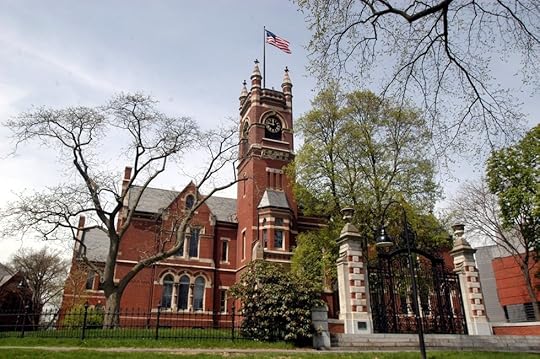
 For anyone looking for a good book that revisits the nostalgia of Smith College, J. Courtney Sullivan’s Commencement is a page-turner, showcasing four hall-mates who become a group of unlikely friends during and after graduating from college. Sally (whose mother just died), Bree (who is already engaged), April (a strong-willed feminist) and Celia (a young woman with dreams of becoming a writer). As they all together experience the ecstatic highs and painful lows of early adulthood, Celia grows to distrust men after a night gone terribly wrong, Bree falls in love with someone she knows she could never bring home to her traditional Southern family, Sally connects with her English professor and April realizes that she has a group of friends she can confide in. Sullivan produces a definitive range of topics about the implications of big dreams clashing against harsh reality as the readers follow each of the characters during their four years of and out of college. She touches upon single-sex policy on feminism, transgender issues, lesbian behavior, dating and the aspirations of graduates. Just like adulthood, these four woman have all of the opportunities in the world, but they have no clear idea about what to choose.
For anyone looking for a good book that revisits the nostalgia of Smith College, J. Courtney Sullivan’s Commencement is a page-turner, showcasing four hall-mates who become a group of unlikely friends during and after graduating from college. Sally (whose mother just died), Bree (who is already engaged), April (a strong-willed feminist) and Celia (a young woman with dreams of becoming a writer). As they all together experience the ecstatic highs and painful lows of early adulthood, Celia grows to distrust men after a night gone terribly wrong, Bree falls in love with someone she knows she could never bring home to her traditional Southern family, Sally connects with her English professor and April realizes that she has a group of friends she can confide in. Sullivan produces a definitive range of topics about the implications of big dreams clashing against harsh reality as the readers follow each of the characters during their four years of and out of college. She touches upon single-sex policy on feminism, transgender issues, lesbian behavior, dating and the aspirations of graduates. Just like adulthood, these four woman have all of the opportunities in the world, but they have no clear idea about what to choose.
For the Vassar Graduates: The Group by Mary McCarthy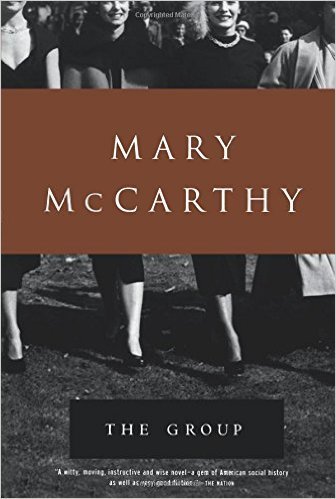
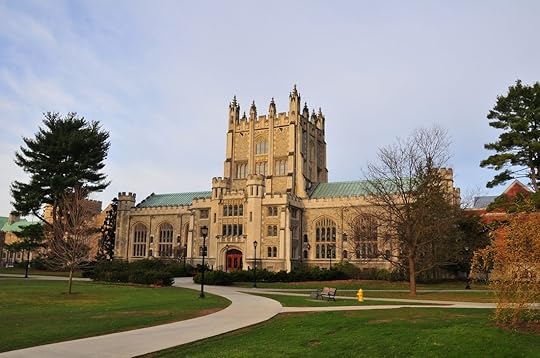
 First published in 1963, Mary McCarthy’s classic novel about nine female Vassar graduates in 1930s America, is a frank and honest description of life after college. Among the nine graduates, minor groupings exist. The original group consists of Lakey, Helena, Dottie, Pokey, Libby and Priss. Another classmate, but not a group mate, Norine provides a dissonant counterpart to the elitism of the others in the group. McCarthy refuses to shy away from the discomforting issues women of the 30’s were faced with: sex and contraceptions, career and marriage, love and lust, fidelity to one’s husband versus loyalty to one’s friends and an attempt to leave one’s mark on the world despite gender limitations. McCarthy’s writing is smart, tight, testy and unfaithful to the literary norms of classical balance. 50 years after it’s publication, the novel has become more of a sensation than ever. The uniqueness of The Group resides in the inherent irony of the very title of the novel. There is no single character or voice through whom the intellectually severe voice of the author is heard. The women in McCarthy’s novel have ideal images in their head as to how life after college will play out. Nevertheless, McCarthy focuses on the fact that all of her character’s plans fall short of success.
First published in 1963, Mary McCarthy’s classic novel about nine female Vassar graduates in 1930s America, is a frank and honest description of life after college. Among the nine graduates, minor groupings exist. The original group consists of Lakey, Helena, Dottie, Pokey, Libby and Priss. Another classmate, but not a group mate, Norine provides a dissonant counterpart to the elitism of the others in the group. McCarthy refuses to shy away from the discomforting issues women of the 30’s were faced with: sex and contraceptions, career and marriage, love and lust, fidelity to one’s husband versus loyalty to one’s friends and an attempt to leave one’s mark on the world despite gender limitations. McCarthy’s writing is smart, tight, testy and unfaithful to the literary norms of classical balance. 50 years after it’s publication, the novel has become more of a sensation than ever. The uniqueness of The Group resides in the inherent irony of the very title of the novel. There is no single character or voice through whom the intellectually severe voice of the author is heard. The women in McCarthy’s novel have ideal images in their head as to how life after college will play out. Nevertheless, McCarthy focuses on the fact that all of her character’s plans fall short of success.
For the Mount Holyoke Graduates: The Secret Life of Emily Dickinson by Jerome Charyn

 As Charyn assumes Dickinson’s own voice and surrounds her with invented as well as historical characters, he fills in the blanks of the inner imaginative world of America’s greatest poet. The story opens up in 1848 when Emily is still a student at Mount Holyoke and a struggling writer. Channeling the devilish rhythms and ghosts of a seemingly buried literary past, Charyn removes the mysterious veils that have cloaked Dickinson, revealing her inner turmoils and self-doubt when she finally enters the adult world. In a way, this literary tactic makes Dickinson more vulnerable as a character. Charyn reminds us that even the great Emily Dickinson herself was unsure about the future too, and endured the hardships of the real world like any other young adult. Through lyrical inflections and a dynamic breadth of Emily’s home life, Charyn pays homage to Dickinson’s past as she strifes to prove her indelible work of literature to the world.
As Charyn assumes Dickinson’s own voice and surrounds her with invented as well as historical characters, he fills in the blanks of the inner imaginative world of America’s greatest poet. The story opens up in 1848 when Emily is still a student at Mount Holyoke and a struggling writer. Channeling the devilish rhythms and ghosts of a seemingly buried literary past, Charyn removes the mysterious veils that have cloaked Dickinson, revealing her inner turmoils and self-doubt when she finally enters the adult world. In a way, this literary tactic makes Dickinson more vulnerable as a character. Charyn reminds us that even the great Emily Dickinson herself was unsure about the future too, and endured the hardships of the real world like any other young adult. Through lyrical inflections and a dynamic breadth of Emily’s home life, Charyn pays homage to Dickinson’s past as she strifes to prove her indelible work of literature to the world.
For the Bryn Mwar Graduates: The Year She Left Us by Kathryn Ma
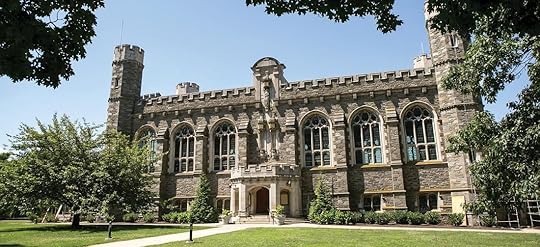
 Ma’s writing withholds and misdirects readers at nearly every turn, but she nevertheless successfully delivers a complicated but emotional novel that mirrors everyday life. When She Left Us centers around three generations of Chinese-Americans: Eighteen-year-old Ari (adopted when she was a baby from an orphanage in China), Charlie (Ari’s mother who lives in San Francisco) and Gran (who ended up moving to the U.S. after the Second Sino-Japanese War). These three women detail what it means to be Chinese-American, all while enduring the shifting of their own identities. Chapters told in the first person by Ari and Gran, alternate with third-person chapters describing Charlie’s life and her sister, Les. From Gran attending Bryn Mawr College and starting a brand new life for herself when she marries a Chinese man, to Charlie never marrying and entering the legal profession, and to finally Ari, whose attitude toward her upbringing is scathing. Ari is a “Whackadoodle,” a member of a group of adoptive Chinese girls. However, the first thing that Ari notices is that while her family is Chinese, most of the other girls in her group have been adopted by white families. After a disastrous trip to visit her “home” orphanage in China, Ari is unexpectedly plunged into a growing despair of searching for value in her life. Ma generates focus on the raw first-person ache of youth while calling attention to the reality that adulthood itself is both a cluttered and harrowing circumstance to endure.
Ma’s writing withholds and misdirects readers at nearly every turn, but she nevertheless successfully delivers a complicated but emotional novel that mirrors everyday life. When She Left Us centers around three generations of Chinese-Americans: Eighteen-year-old Ari (adopted when she was a baby from an orphanage in China), Charlie (Ari’s mother who lives in San Francisco) and Gran (who ended up moving to the U.S. after the Second Sino-Japanese War). These three women detail what it means to be Chinese-American, all while enduring the shifting of their own identities. Chapters told in the first person by Ari and Gran, alternate with third-person chapters describing Charlie’s life and her sister, Les. From Gran attending Bryn Mawr College and starting a brand new life for herself when she marries a Chinese man, to Charlie never marrying and entering the legal profession, and to finally Ari, whose attitude toward her upbringing is scathing. Ari is a “Whackadoodle,” a member of a group of adoptive Chinese girls. However, the first thing that Ari notices is that while her family is Chinese, most of the other girls in her group have been adopted by white families. After a disastrous trip to visit her “home” orphanage in China, Ari is unexpectedly plunged into a growing despair of searching for value in her life. Ma generates focus on the raw first-person ache of youth while calling attention to the reality that adulthood itself is both a cluttered and harrowing circumstance to endure.
For the Barnard Graduates: Breathless – An American Girl in Paris by Nancy K. Miller

 This memoir told through a series of short chapters, chronicles the moments of Miller’s misadventures. It’s 1962 which means that women had to prepare for three things: marriage, children and becoming a housewife. But then enters, Nancy Kepnis, a recent graduate from Barnard College who decides to rebel against the status quo of domesticity by setting out to live in Paris for a year. A big fan of Simone de Beauvoir and a frustrating product of her times, Nancy has it all planned out. Enamored by everything French, she decides to take classes at the Sorbonne while also striving to live out her life like a French romantic movie. Nancy is ready to become an entirely different person. What she finds along the way, isn’t what she hoped would be her perfect movie ending. She gives up her short-lived freedom in the iconic city of love to an American entrepreneur who promises her a lifetime of three-star meals and five-star hotels. Nevertheless, Nancy’s dreams are shattered when she discovers that her husband is actually a con man. What makes this memoir so fascinating is not Miller’s romantic mistakes that she is is able to recall so vividly, but her internal struggle to make her life fit at a certain ideal level. Miller’s younger self must deal with the dilemma of when your picture perfect life is broken apart piece by piece by the melancholy fingers of reality. Breathless is a unique window of youthful mistakes and surprisingly clarity upon jumping head first into the adult world.
This memoir told through a series of short chapters, chronicles the moments of Miller’s misadventures. It’s 1962 which means that women had to prepare for three things: marriage, children and becoming a housewife. But then enters, Nancy Kepnis, a recent graduate from Barnard College who decides to rebel against the status quo of domesticity by setting out to live in Paris for a year. A big fan of Simone de Beauvoir and a frustrating product of her times, Nancy has it all planned out. Enamored by everything French, she decides to take classes at the Sorbonne while also striving to live out her life like a French romantic movie. Nancy is ready to become an entirely different person. What she finds along the way, isn’t what she hoped would be her perfect movie ending. She gives up her short-lived freedom in the iconic city of love to an American entrepreneur who promises her a lifetime of three-star meals and five-star hotels. Nevertheless, Nancy’s dreams are shattered when she discovers that her husband is actually a con man. What makes this memoir so fascinating is not Miller’s romantic mistakes that she is is able to recall so vividly, but her internal struggle to make her life fit at a certain ideal level. Miller’s younger self must deal with the dilemma of when your picture perfect life is broken apart piece by piece by the melancholy fingers of reality. Breathless is a unique window of youthful mistakes and surprisingly clarity upon jumping head first into the adult world.
For the Wellesley Graduates: The List by Karin Tanabe

 When twenty-eight-year-old Wellesley College graduate, Adrienne Brown leaves her glamorous job at Town & Country for a spot at the Capitalist (known simply as the List, the only media outlet in D.C. that’s on the rise) she believes that this is a life-changing career. However, staffing at the Capitalist means a low wage salary, moving back in to live with her parents and mainlining five-hour energy shots while subsisting on five hours of sleep. But Adrienne is determined to make the necessary sacrifices that she sees fit to carve out a name for herself. But then she stumbles upon a scoop, a story that might be a major career boost. Yet, the scandal involves an affair between a back-stabbing co-worker and a married senator. Tanabe herself was a Politico reporter back in her day, and zeros in on the skewering of digital journalism through tweets and blogs by an army of underpaid 20-something adults who just want to make an impression upon the world.
When twenty-eight-year-old Wellesley College graduate, Adrienne Brown leaves her glamorous job at Town & Country for a spot at the Capitalist (known simply as the List, the only media outlet in D.C. that’s on the rise) she believes that this is a life-changing career. However, staffing at the Capitalist means a low wage salary, moving back in to live with her parents and mainlining five-hour energy shots while subsisting on five hours of sleep. But Adrienne is determined to make the necessary sacrifices that she sees fit to carve out a name for herself. But then she stumbles upon a scoop, a story that might be a major career boost. Yet, the scandal involves an affair between a back-stabbing co-worker and a married senator. Tanabe herself was a Politico reporter back in her day, and zeros in on the skewering of digital journalism through tweets and blogs by an army of underpaid 20-something adults who just want to make an impression upon the world.
For the Radcliffe Graduates: Class Reunion by Rona Jaffe

 Radcliffe College, the all-women institute that functioned as a feeder for potential wives and partners for the men that attended Harvard College in the 1950’s. In Jaffe’s novel, Class Reunion follows four Radcliffe girls during their years in college and the years after they’ve graduate. And if there’s one thing that these four girls have in common, it’s marriage. Upon entering college, Emily is worried about fitting in among her indifferent wealthy classmates. Chris, a career girl and marries a man whom she later discovers is gay. Annabel, is a high-spirited and flirtatious Southern bell, until she ruins her reputation by sleeping around. And then there’s Daphne, who tries to hold on to her bohemian existence in the hopes that nobody will find out that she has epilepsy. The novel itself is a chilling reminder of the double bind in which women were expected to conform to their repressive gender roles. They owed it to their families to settle down with a man – especially a Harvard man – and produce children. More so, Jaffe’s message to her readers is crystal clear: Following a linear path will never be fulfilling. One must venture off and take risks if they are to lead a fruitful life.
Radcliffe College, the all-women institute that functioned as a feeder for potential wives and partners for the men that attended Harvard College in the 1950’s. In Jaffe’s novel, Class Reunion follows four Radcliffe girls during their years in college and the years after they’ve graduate. And if there’s one thing that these four girls have in common, it’s marriage. Upon entering college, Emily is worried about fitting in among her indifferent wealthy classmates. Chris, a career girl and marries a man whom she later discovers is gay. Annabel, is a high-spirited and flirtatious Southern bell, until she ruins her reputation by sleeping around. And then there’s Daphne, who tries to hold on to her bohemian existence in the hopes that nobody will find out that she has epilepsy. The novel itself is a chilling reminder of the double bind in which women were expected to conform to their repressive gender roles. They owed it to their families to settle down with a man – especially a Harvard man – and produce children. More so, Jaffe’s message to her readers is crystal clear: Following a linear path will never be fulfilling. One must venture off and take risks if they are to lead a fruitful life.
So gather your fellow sisters, and start recording as to what the adult world has in store for you!

Needless to say, it was absolutely flawless and everyone looked awesome in their caps and gowns.

 It was a strange feeling being back on campus. One year ago, I too had graduated and walked away with my diploma, through the Mount Holyoke gates and into adulthood. My cap, spray painted with gold, spelled out one of the famous lines from the musical, Hamilton – “There’s a million things I haven’t done, but just you wait” – was currently back home on top of my desk in California. My gown, was stowed away at the bottom of one of my empty suitcases in my current apartment. And my hood . . . well, is somewhere. Most likely in my sock drawer.
It was a strange feeling being back on campus. One year ago, I too had graduated and walked away with my diploma, through the Mount Holyoke gates and into adulthood. My cap, spray painted with gold, spelled out one of the famous lines from the musical, Hamilton – “There’s a million things I haven’t done, but just you wait” – was currently back home on top of my desk in California. My gown, was stowed away at the bottom of one of my empty suitcases in my current apartment. And my hood . . . well, is somewhere. Most likely in my sock drawer.  I remembered all of the excitement that brewed up the day before graduation.
I remembered all of the excitement that brewed up the day before graduation. Marching in our white dresses in the Laurel Parade singing “Bread and Roses."
Staying up past midnight watching Dirty Dancing in the amphitheater; the entire senior class erupting in cheers when Jake Houseman proudly announced that “Baby’s starting Mount Holyoke in the fall.”
But the most important event that happened the night before graduation, was the baccalaureate ceremony in Abbey Church. There, the undergraduates attended, donning on their caps and gowns as the faculty made speeches, advising the to-be graduates to take a moment and feel proud of all of their accomplishments.
It was the penultimate send-off ceremony, before the actual send-off ceremony.
 My friend Lauren and I sat next to each other in Hooker Auditorium, where the entire Baccalaureate ceremony was being lived streamed. As we watched the class of 2017 file into Abbey Chapel, the faculty stood up and read aloud their speeches.
My friend Lauren and I sat next to each other in Hooker Auditorium, where the entire Baccalaureate ceremony was being lived streamed. As we watched the class of 2017 file into Abbey Chapel, the faculty stood up and read aloud their speeches.But I couldn’t help but wonder if all of the other sister schools were doing what we were doing right now.
Granted, two out of the seven sister schools are different compared to the characteristics of the remaining five sister schools (Mount Holyoke, Smith, Wellesley, Bryn Mawr and Barnard). Vassar decided to go coed in 1969, and Radcliffe merged with Harvard and is now a research institute and no longer an undergraduate institution.
Nevertheless, all seven of these schools produced some of the most intellectual and creative individuals in the country. Authors who’ve graduated from these schools looked back fondly on the memories of attending these women’s college and the bonds that were established. Mainly emphasizing how different the adult world is compared to the safe bubble that everyone lived in during their four years of college.
So if you’re a former seven sister student looking for a book that brings the sentimental memories of your school on every page, I’ve got you covered.
In addition, for those who’ve graduated from Vassar or who are finishing up degrees at the Radcliffe Institute, these books apply to you as well.
These stories are meant to help you ease into your life as full-fledged adults, while also providing you some advice on how to live a well-meaning life after college.
For the Smith Graduates: Commencement by J. Courtney Sullivan


 For anyone looking for a good book that revisits the nostalgia of Smith College, J. Courtney Sullivan’s Commencement is a page-turner, showcasing four hall-mates who become a group of unlikely friends during and after graduating from college. Sally (whose mother just died), Bree (who is already engaged), April (a strong-willed feminist) and Celia (a young woman with dreams of becoming a writer). As they all together experience the ecstatic highs and painful lows of early adulthood, Celia grows to distrust men after a night gone terribly wrong, Bree falls in love with someone she knows she could never bring home to her traditional Southern family, Sally connects with her English professor and April realizes that she has a group of friends she can confide in. Sullivan produces a definitive range of topics about the implications of big dreams clashing against harsh reality as the readers follow each of the characters during their four years of and out of college. She touches upon single-sex policy on feminism, transgender issues, lesbian behavior, dating and the aspirations of graduates. Just like adulthood, these four woman have all of the opportunities in the world, but they have no clear idea about what to choose.
For anyone looking for a good book that revisits the nostalgia of Smith College, J. Courtney Sullivan’s Commencement is a page-turner, showcasing four hall-mates who become a group of unlikely friends during and after graduating from college. Sally (whose mother just died), Bree (who is already engaged), April (a strong-willed feminist) and Celia (a young woman with dreams of becoming a writer). As they all together experience the ecstatic highs and painful lows of early adulthood, Celia grows to distrust men after a night gone terribly wrong, Bree falls in love with someone she knows she could never bring home to her traditional Southern family, Sally connects with her English professor and April realizes that she has a group of friends she can confide in. Sullivan produces a definitive range of topics about the implications of big dreams clashing against harsh reality as the readers follow each of the characters during their four years of and out of college. She touches upon single-sex policy on feminism, transgender issues, lesbian behavior, dating and the aspirations of graduates. Just like adulthood, these four woman have all of the opportunities in the world, but they have no clear idea about what to choose. For the Vassar Graduates: The Group by Mary McCarthy


 First published in 1963, Mary McCarthy’s classic novel about nine female Vassar graduates in 1930s America, is a frank and honest description of life after college. Among the nine graduates, minor groupings exist. The original group consists of Lakey, Helena, Dottie, Pokey, Libby and Priss. Another classmate, but not a group mate, Norine provides a dissonant counterpart to the elitism of the others in the group. McCarthy refuses to shy away from the discomforting issues women of the 30’s were faced with: sex and contraceptions, career and marriage, love and lust, fidelity to one’s husband versus loyalty to one’s friends and an attempt to leave one’s mark on the world despite gender limitations. McCarthy’s writing is smart, tight, testy and unfaithful to the literary norms of classical balance. 50 years after it’s publication, the novel has become more of a sensation than ever. The uniqueness of The Group resides in the inherent irony of the very title of the novel. There is no single character or voice through whom the intellectually severe voice of the author is heard. The women in McCarthy’s novel have ideal images in their head as to how life after college will play out. Nevertheless, McCarthy focuses on the fact that all of her character’s plans fall short of success.
First published in 1963, Mary McCarthy’s classic novel about nine female Vassar graduates in 1930s America, is a frank and honest description of life after college. Among the nine graduates, minor groupings exist. The original group consists of Lakey, Helena, Dottie, Pokey, Libby and Priss. Another classmate, but not a group mate, Norine provides a dissonant counterpart to the elitism of the others in the group. McCarthy refuses to shy away from the discomforting issues women of the 30’s were faced with: sex and contraceptions, career and marriage, love and lust, fidelity to one’s husband versus loyalty to one’s friends and an attempt to leave one’s mark on the world despite gender limitations. McCarthy’s writing is smart, tight, testy and unfaithful to the literary norms of classical balance. 50 years after it’s publication, the novel has become more of a sensation than ever. The uniqueness of The Group resides in the inherent irony of the very title of the novel. There is no single character or voice through whom the intellectually severe voice of the author is heard. The women in McCarthy’s novel have ideal images in their head as to how life after college will play out. Nevertheless, McCarthy focuses on the fact that all of her character’s plans fall short of success. For the Mount Holyoke Graduates: The Secret Life of Emily Dickinson by Jerome Charyn


 As Charyn assumes Dickinson’s own voice and surrounds her with invented as well as historical characters, he fills in the blanks of the inner imaginative world of America’s greatest poet. The story opens up in 1848 when Emily is still a student at Mount Holyoke and a struggling writer. Channeling the devilish rhythms and ghosts of a seemingly buried literary past, Charyn removes the mysterious veils that have cloaked Dickinson, revealing her inner turmoils and self-doubt when she finally enters the adult world. In a way, this literary tactic makes Dickinson more vulnerable as a character. Charyn reminds us that even the great Emily Dickinson herself was unsure about the future too, and endured the hardships of the real world like any other young adult. Through lyrical inflections and a dynamic breadth of Emily’s home life, Charyn pays homage to Dickinson’s past as she strifes to prove her indelible work of literature to the world.
As Charyn assumes Dickinson’s own voice and surrounds her with invented as well as historical characters, he fills in the blanks of the inner imaginative world of America’s greatest poet. The story opens up in 1848 when Emily is still a student at Mount Holyoke and a struggling writer. Channeling the devilish rhythms and ghosts of a seemingly buried literary past, Charyn removes the mysterious veils that have cloaked Dickinson, revealing her inner turmoils and self-doubt when she finally enters the adult world. In a way, this literary tactic makes Dickinson more vulnerable as a character. Charyn reminds us that even the great Emily Dickinson herself was unsure about the future too, and endured the hardships of the real world like any other young adult. Through lyrical inflections and a dynamic breadth of Emily’s home life, Charyn pays homage to Dickinson’s past as she strifes to prove her indelible work of literature to the world. For the Bryn Mwar Graduates: The Year She Left Us by Kathryn Ma


 Ma’s writing withholds and misdirects readers at nearly every turn, but she nevertheless successfully delivers a complicated but emotional novel that mirrors everyday life. When She Left Us centers around three generations of Chinese-Americans: Eighteen-year-old Ari (adopted when she was a baby from an orphanage in China), Charlie (Ari’s mother who lives in San Francisco) and Gran (who ended up moving to the U.S. after the Second Sino-Japanese War). These three women detail what it means to be Chinese-American, all while enduring the shifting of their own identities. Chapters told in the first person by Ari and Gran, alternate with third-person chapters describing Charlie’s life and her sister, Les. From Gran attending Bryn Mawr College and starting a brand new life for herself when she marries a Chinese man, to Charlie never marrying and entering the legal profession, and to finally Ari, whose attitude toward her upbringing is scathing. Ari is a “Whackadoodle,” a member of a group of adoptive Chinese girls. However, the first thing that Ari notices is that while her family is Chinese, most of the other girls in her group have been adopted by white families. After a disastrous trip to visit her “home” orphanage in China, Ari is unexpectedly plunged into a growing despair of searching for value in her life. Ma generates focus on the raw first-person ache of youth while calling attention to the reality that adulthood itself is both a cluttered and harrowing circumstance to endure.
Ma’s writing withholds and misdirects readers at nearly every turn, but she nevertheless successfully delivers a complicated but emotional novel that mirrors everyday life. When She Left Us centers around three generations of Chinese-Americans: Eighteen-year-old Ari (adopted when she was a baby from an orphanage in China), Charlie (Ari’s mother who lives in San Francisco) and Gran (who ended up moving to the U.S. after the Second Sino-Japanese War). These three women detail what it means to be Chinese-American, all while enduring the shifting of their own identities. Chapters told in the first person by Ari and Gran, alternate with third-person chapters describing Charlie’s life and her sister, Les. From Gran attending Bryn Mawr College and starting a brand new life for herself when she marries a Chinese man, to Charlie never marrying and entering the legal profession, and to finally Ari, whose attitude toward her upbringing is scathing. Ari is a “Whackadoodle,” a member of a group of adoptive Chinese girls. However, the first thing that Ari notices is that while her family is Chinese, most of the other girls in her group have been adopted by white families. After a disastrous trip to visit her “home” orphanage in China, Ari is unexpectedly plunged into a growing despair of searching for value in her life. Ma generates focus on the raw first-person ache of youth while calling attention to the reality that adulthood itself is both a cluttered and harrowing circumstance to endure. For the Barnard Graduates: Breathless – An American Girl in Paris by Nancy K. Miller


 This memoir told through a series of short chapters, chronicles the moments of Miller’s misadventures. It’s 1962 which means that women had to prepare for three things: marriage, children and becoming a housewife. But then enters, Nancy Kepnis, a recent graduate from Barnard College who decides to rebel against the status quo of domesticity by setting out to live in Paris for a year. A big fan of Simone de Beauvoir and a frustrating product of her times, Nancy has it all planned out. Enamored by everything French, she decides to take classes at the Sorbonne while also striving to live out her life like a French romantic movie. Nancy is ready to become an entirely different person. What she finds along the way, isn’t what she hoped would be her perfect movie ending. She gives up her short-lived freedom in the iconic city of love to an American entrepreneur who promises her a lifetime of three-star meals and five-star hotels. Nevertheless, Nancy’s dreams are shattered when she discovers that her husband is actually a con man. What makes this memoir so fascinating is not Miller’s romantic mistakes that she is is able to recall so vividly, but her internal struggle to make her life fit at a certain ideal level. Miller’s younger self must deal with the dilemma of when your picture perfect life is broken apart piece by piece by the melancholy fingers of reality. Breathless is a unique window of youthful mistakes and surprisingly clarity upon jumping head first into the adult world.
This memoir told through a series of short chapters, chronicles the moments of Miller’s misadventures. It’s 1962 which means that women had to prepare for three things: marriage, children and becoming a housewife. But then enters, Nancy Kepnis, a recent graduate from Barnard College who decides to rebel against the status quo of domesticity by setting out to live in Paris for a year. A big fan of Simone de Beauvoir and a frustrating product of her times, Nancy has it all planned out. Enamored by everything French, she decides to take classes at the Sorbonne while also striving to live out her life like a French romantic movie. Nancy is ready to become an entirely different person. What she finds along the way, isn’t what she hoped would be her perfect movie ending. She gives up her short-lived freedom in the iconic city of love to an American entrepreneur who promises her a lifetime of three-star meals and five-star hotels. Nevertheless, Nancy’s dreams are shattered when she discovers that her husband is actually a con man. What makes this memoir so fascinating is not Miller’s romantic mistakes that she is is able to recall so vividly, but her internal struggle to make her life fit at a certain ideal level. Miller’s younger self must deal with the dilemma of when your picture perfect life is broken apart piece by piece by the melancholy fingers of reality. Breathless is a unique window of youthful mistakes and surprisingly clarity upon jumping head first into the adult world. For the Wellesley Graduates: The List by Karin Tanabe


 When twenty-eight-year-old Wellesley College graduate, Adrienne Brown leaves her glamorous job at Town & Country for a spot at the Capitalist (known simply as the List, the only media outlet in D.C. that’s on the rise) she believes that this is a life-changing career. However, staffing at the Capitalist means a low wage salary, moving back in to live with her parents and mainlining five-hour energy shots while subsisting on five hours of sleep. But Adrienne is determined to make the necessary sacrifices that she sees fit to carve out a name for herself. But then she stumbles upon a scoop, a story that might be a major career boost. Yet, the scandal involves an affair between a back-stabbing co-worker and a married senator. Tanabe herself was a Politico reporter back in her day, and zeros in on the skewering of digital journalism through tweets and blogs by an army of underpaid 20-something adults who just want to make an impression upon the world.
When twenty-eight-year-old Wellesley College graduate, Adrienne Brown leaves her glamorous job at Town & Country for a spot at the Capitalist (known simply as the List, the only media outlet in D.C. that’s on the rise) she believes that this is a life-changing career. However, staffing at the Capitalist means a low wage salary, moving back in to live with her parents and mainlining five-hour energy shots while subsisting on five hours of sleep. But Adrienne is determined to make the necessary sacrifices that she sees fit to carve out a name for herself. But then she stumbles upon a scoop, a story that might be a major career boost. Yet, the scandal involves an affair between a back-stabbing co-worker and a married senator. Tanabe herself was a Politico reporter back in her day, and zeros in on the skewering of digital journalism through tweets and blogs by an army of underpaid 20-something adults who just want to make an impression upon the world. For the Radcliffe Graduates: Class Reunion by Rona Jaffe


 Radcliffe College, the all-women institute that functioned as a feeder for potential wives and partners for the men that attended Harvard College in the 1950’s. In Jaffe’s novel, Class Reunion follows four Radcliffe girls during their years in college and the years after they’ve graduate. And if there’s one thing that these four girls have in common, it’s marriage. Upon entering college, Emily is worried about fitting in among her indifferent wealthy classmates. Chris, a career girl and marries a man whom she later discovers is gay. Annabel, is a high-spirited and flirtatious Southern bell, until she ruins her reputation by sleeping around. And then there’s Daphne, who tries to hold on to her bohemian existence in the hopes that nobody will find out that she has epilepsy. The novel itself is a chilling reminder of the double bind in which women were expected to conform to their repressive gender roles. They owed it to their families to settle down with a man – especially a Harvard man – and produce children. More so, Jaffe’s message to her readers is crystal clear: Following a linear path will never be fulfilling. One must venture off and take risks if they are to lead a fruitful life.
Radcliffe College, the all-women institute that functioned as a feeder for potential wives and partners for the men that attended Harvard College in the 1950’s. In Jaffe’s novel, Class Reunion follows four Radcliffe girls during their years in college and the years after they’ve graduate. And if there’s one thing that these four girls have in common, it’s marriage. Upon entering college, Emily is worried about fitting in among her indifferent wealthy classmates. Chris, a career girl and marries a man whom she later discovers is gay. Annabel, is a high-spirited and flirtatious Southern bell, until she ruins her reputation by sleeping around. And then there’s Daphne, who tries to hold on to her bohemian existence in the hopes that nobody will find out that she has epilepsy. The novel itself is a chilling reminder of the double bind in which women were expected to conform to their repressive gender roles. They owed it to their families to settle down with a man – especially a Harvard man – and produce children. More so, Jaffe’s message to her readers is crystal clear: Following a linear path will never be fulfilling. One must venture off and take risks if they are to lead a fruitful life. So gather your fellow sisters, and start recording as to what the adult world has in store for you!

Published on May 22, 2017 16:06
April 25, 2017
10 Books To Read After Watching “The Handmaid’s Tale"
If you’ve already binged watched the first three episodes of Hulu’s adaptation of The Handmaid’s Tale, and the wait for the next episode has sent you into a spiral of withdrawals, then in the words of it’s author, Margaret Atwood, “Don’t let the bastards grind you down.” 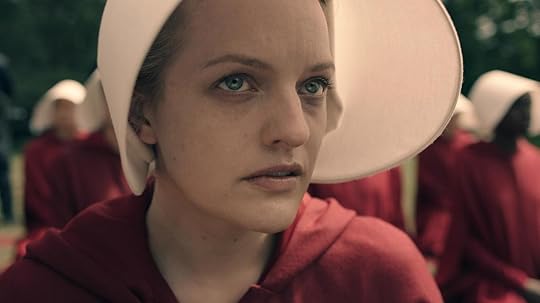 On Wednesday, April 26th, Hulu aired the first three episodes of their highly anticipated, dystopian series. The premise of the story, imagines America in which Christian fundamentalists have staged a coup in the wake of the declining birthrates. This replacement of American democracy ushers in a repressive theocratic regime called the Republic of Gilead. The new government enslaves fertile women to become “handmaids,” assigned to bear children for wealthy and powerful men and their barren wives. The main character, Offred, is sent to live in sexual servitude with Commander Fred Waterford and his former televangelist wife, Serena Joy. Offred reveals through flashbacks what the bygone days were like before the Republic of Gilead was established, and reminisces over her husband and loving daughter.
On Wednesday, April 26th, Hulu aired the first three episodes of their highly anticipated, dystopian series. The premise of the story, imagines America in which Christian fundamentalists have staged a coup in the wake of the declining birthrates. This replacement of American democracy ushers in a repressive theocratic regime called the Republic of Gilead. The new government enslaves fertile women to become “handmaids,” assigned to bear children for wealthy and powerful men and their barren wives. The main character, Offred, is sent to live in sexual servitude with Commander Fred Waterford and his former televangelist wife, Serena Joy. Offred reveals through flashbacks what the bygone days were like before the Republic of Gilead was established, and reminisces over her husband and loving daughter.
Atwood’s novel, and the Hulu miniseries adaption revel in not just feminist ideologies, but humanitarian principals as well. It is a story about the ways in which one group of women are oppressed in a society run by the benefit of the patriarchy, while another group of women take advantage of the situation to ally themselves with male power for personal gain. Drawing on that theme, the titles below will keep you out of a slump once you’re finished watching every last second of The Handmaid’s Tale.
#10: When She Woke by Hillary Jordan If you get your kicks from retellings of fairytales or literary classics, Hillary Jordan’s When She Woke is right up your alley. The story is a revamped dystopian version of Nathanial Hawthorne’s The Scarlett Letter, detailing the terrifying future if we used the Ten Commandments as a legal code, while also losing all sense of Christian humility. When Jordan’s heroine, Hannah, finds that her adulterous affair with the nation’s most celebrated pastor leads her to an unwanted pregnancy, she breaks the nation’s most sacred law and seeks a back-alley abortion. However, when she gets caught and refuses to give up the name of her lover or the doctor who performed the procedure to the authorities, Hannah loses everything. In this newly developed government, Christians have done away with capital punishment, and long prison sentences have been replaced by “chroming” in which criminals are injected with a virus that turns their skin a color that represents what crimes they have committed. After Hannah is released from her month of solitary confinement, she becomes visible for her crimes, when the authorities dye her skin a bright red. While Jordan’s novel sounds like another unsubtle excoriation of American Christianity, When She Woke holds many questioning layers of prison reform, conservative church vs. conservative state, and judging someone (quite literary) by the color of their skin.
If you get your kicks from retellings of fairytales or literary classics, Hillary Jordan’s When She Woke is right up your alley. The story is a revamped dystopian version of Nathanial Hawthorne’s The Scarlett Letter, detailing the terrifying future if we used the Ten Commandments as a legal code, while also losing all sense of Christian humility. When Jordan’s heroine, Hannah, finds that her adulterous affair with the nation’s most celebrated pastor leads her to an unwanted pregnancy, she breaks the nation’s most sacred law and seeks a back-alley abortion. However, when she gets caught and refuses to give up the name of her lover or the doctor who performed the procedure to the authorities, Hannah loses everything. In this newly developed government, Christians have done away with capital punishment, and long prison sentences have been replaced by “chroming” in which criminals are injected with a virus that turns their skin a color that represents what crimes they have committed. After Hannah is released from her month of solitary confinement, she becomes visible for her crimes, when the authorities dye her skin a bright red. While Jordan’s novel sounds like another unsubtle excoriation of American Christianity, When She Woke holds many questioning layers of prison reform, conservative church vs. conservative state, and judging someone (quite literary) by the color of their skin.
#9: Wither by Lauren DeStefano Sex! Lies! And sister wives? In Lauren DeStefano’s debut novel, Wither, genetic engineering leads to the creation of perfect children, however no one suspects the long-term effects until from the second generation onward, children who were born seemingly healthy and strong start dying at the ages of 20 and 25. In a desperate attempt to save the human race from extinction, the rich and privileged, kidnap young girls and sell them into polygamous marriages in the hopes that the babies conceived to such unions will give them time to discovering a cure. When sixteen-year-old Rhine ends up as one of these kidnapped victims along with two other girls, she finds herself bought and shuffled off to a new life as one of the Governor’s pampered wives. However, Rhine quickly comes to grips with the reality of her situation. The Governor’s first wife – and childhood sweetheart – has hit the fatal age of 20 and is dying. Rhine, with her heterochromatic eyes is intended to take her place as the Governor’s first wife. Along with Jenna, a girl who is vocal about her hatred to the world they’ve entered, and Cecily, a thirteen-year-old orphan who is too overly excited to be one of the Governor’s wives. Despite being imprisoned within the Governor’s house, Rhine’s predicament becomes even more complicated when she begins a forbidden relationship with one of the Governor’s servants named Gabriel. Wither is the first book in DeStefano’s The Chemical Garden Trilogy.
Sex! Lies! And sister wives? In Lauren DeStefano’s debut novel, Wither, genetic engineering leads to the creation of perfect children, however no one suspects the long-term effects until from the second generation onward, children who were born seemingly healthy and strong start dying at the ages of 20 and 25. In a desperate attempt to save the human race from extinction, the rich and privileged, kidnap young girls and sell them into polygamous marriages in the hopes that the babies conceived to such unions will give them time to discovering a cure. When sixteen-year-old Rhine ends up as one of these kidnapped victims along with two other girls, she finds herself bought and shuffled off to a new life as one of the Governor’s pampered wives. However, Rhine quickly comes to grips with the reality of her situation. The Governor’s first wife – and childhood sweetheart – has hit the fatal age of 20 and is dying. Rhine, with her heterochromatic eyes is intended to take her place as the Governor’s first wife. Along with Jenna, a girl who is vocal about her hatred to the world they’ve entered, and Cecily, a thirteen-year-old orphan who is too overly excited to be one of the Governor’s wives. Despite being imprisoned within the Governor’s house, Rhine’s predicament becomes even more complicated when she begins a forbidden relationship with one of the Governor’s servants named Gabriel. Wither is the first book in DeStefano’s The Chemical Garden Trilogy.
#8: Only Ever Yours by Louise O'Neill
 Delving into the concept of how we treat women in our day-to-day lives, Louise O’Neill’s harrowing novel, Only Ever Yours takes a magnifying glass and amplifies the misogynistic attitudes of how women are objectified. Set in a dystopian world where baby girls are no longer born naturally, genetically engineered women have been created who are able to conceive only male children. However, these engineered women are seen as state property and are therefore of extremely low status. Men view these women as second-class citizens, so much so that no one even give them the courtesy of providing them with capital letters at the start of their names. By the age of sixteen, these girls are sent to an institution called “School” where the lessons include Beauty Therapy and Comparison Studies. The ultimate goal for every girl in the School is to be chosen as a companion (a wife). However, the unchosen girls get left behind as concubines or teachers, because they have been deemed unable to please a man. Worse, because of the limited spaces available to find a companion, the girls are set against one another and tear each other apart. For best friends freida and isabel, they are certain to be chosen as companions until isabel starts to put on some pounds – a quality that is frowned upon at the School. The characters are subjected to more extreme version of the pressures women face everyday. They are encouraged to starve themselves, always act happy-go-lucky and forbid tears in the presence of men. O’Neill dark version of female suppression forces readers to take a long hard look at our own society, and recognize the possibility that fiction might actually be on the brink to fact.
Delving into the concept of how we treat women in our day-to-day lives, Louise O’Neill’s harrowing novel, Only Ever Yours takes a magnifying glass and amplifies the misogynistic attitudes of how women are objectified. Set in a dystopian world where baby girls are no longer born naturally, genetically engineered women have been created who are able to conceive only male children. However, these engineered women are seen as state property and are therefore of extremely low status. Men view these women as second-class citizens, so much so that no one even give them the courtesy of providing them with capital letters at the start of their names. By the age of sixteen, these girls are sent to an institution called “School” where the lessons include Beauty Therapy and Comparison Studies. The ultimate goal for every girl in the School is to be chosen as a companion (a wife). However, the unchosen girls get left behind as concubines or teachers, because they have been deemed unable to please a man. Worse, because of the limited spaces available to find a companion, the girls are set against one another and tear each other apart. For best friends freida and isabel, they are certain to be chosen as companions until isabel starts to put on some pounds – a quality that is frowned upon at the School. The characters are subjected to more extreme version of the pressures women face everyday. They are encouraged to starve themselves, always act happy-go-lucky and forbid tears in the presence of men. O’Neill dark version of female suppression forces readers to take a long hard look at our own society, and recognize the possibility that fiction might actually be on the brink to fact.
#7: The Jewel by Amy Ewing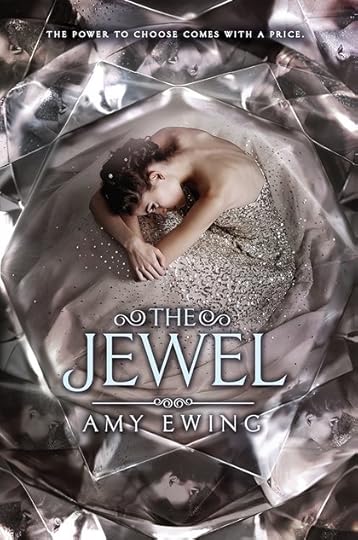 The Jewel is the first book from The Lone City series by Amy Ewing. A tense tale about Violet Lasting’s life after she gets auctioned off as surrogate mother. Violet’s job is to carry the child of the woman who buys her, until she realizes that the true purchaser is the Duchess of the Lake, one of the four founding families of the city called The Jewel. The Duchess of the Lake begins to pamper and punish Violet, eager to implant a child within her that will win the ruling Electress and Exeter’s favor. Violet was born with a certain gene and the special power of Augury (transformative magic) that makes the royals of the land take more notice of her. However, Violet soon discovers how dangerous it is to be a surrogate for the aristocratic circle of The Jewel as she tries to hold on to her identity and sanity under the watchful eyes of the Duchess. Then she meets Ash, the hired companion for the Duchess’s niece. Together, they come to realize the scale of the treachery that The Jewel holds, as well as becoming the others endangerment.
The Jewel is the first book from The Lone City series by Amy Ewing. A tense tale about Violet Lasting’s life after she gets auctioned off as surrogate mother. Violet’s job is to carry the child of the woman who buys her, until she realizes that the true purchaser is the Duchess of the Lake, one of the four founding families of the city called The Jewel. The Duchess of the Lake begins to pamper and punish Violet, eager to implant a child within her that will win the ruling Electress and Exeter’s favor. Violet was born with a certain gene and the special power of Augury (transformative magic) that makes the royals of the land take more notice of her. However, Violet soon discovers how dangerous it is to be a surrogate for the aristocratic circle of The Jewel as she tries to hold on to her identity and sanity under the watchful eyes of the Duchess. Then she meets Ash, the hired companion for the Duchess’s niece. Together, they come to realize the scale of the treachery that The Jewel holds, as well as becoming the others endangerment.
#6: Bumped by Megan McCafferty
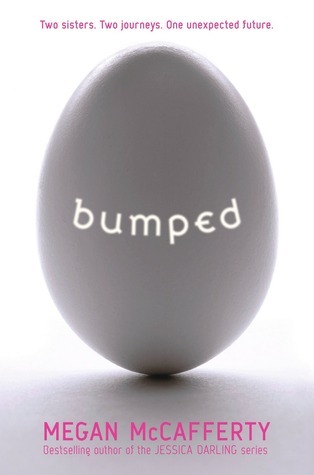 Yes, another dystopian title, but with teen pregnancies. Are you starting to sense a theme here? A virus has come along, making people over the age of 18 sterile. Teenagers and pre-teens are encouraged to by society to “bump” as early as possible. In this universe, boys and girls are bound by contracts, rewarded with luxury, and are paid in six figure advances for their offspring. Melody gets adopted by a pair of aspiring professors and must fulfill her contract by finding a suitable match that is compatible with her genetic desirability. Then there’s Harmony, Melody’s identical twin sister. The two girls were separated at birth, and unlike Melody who has an agent scouting out the perfect companion for her, Harmony is taken in by a small religious community called Goodside. When Harmony discovers that she has a missing twin, she immediately leaves Goodside to find her. However, Harmony’s presence might screw up Melody’s chance of a secure and successful future.
Yes, another dystopian title, but with teen pregnancies. Are you starting to sense a theme here? A virus has come along, making people over the age of 18 sterile. Teenagers and pre-teens are encouraged to by society to “bump” as early as possible. In this universe, boys and girls are bound by contracts, rewarded with luxury, and are paid in six figure advances for their offspring. Melody gets adopted by a pair of aspiring professors and must fulfill her contract by finding a suitable match that is compatible with her genetic desirability. Then there’s Harmony, Melody’s identical twin sister. The two girls were separated at birth, and unlike Melody who has an agent scouting out the perfect companion for her, Harmony is taken in by a small religious community called Goodside. When Harmony discovers that she has a missing twin, she immediately leaves Goodside to find her. However, Harmony’s presence might screw up Melody’s chance of a secure and successful future.
#5: Herland by Charlotte Perkins Gilman
 Written in 1915, Herland is the first book in the Gilman’s feminist utopian trilogy. The story describes a society cut off from civilization composed entirely of women, who’ve learned how to reproduced via asexual reproduction, and who are free from wars, conflicts and dominations. That is, until three men learn about this all-female society and try to take it over. Little do they know, that the women of Herland are not only self-sufficient, but are also capable of doing “men’s work.” Each of the men draw their own stereotypes on the women. Jeff regards women as thing to be serves and protected. Terry views the women as prized possessions to be conquered and won. And unlike his two companions, Van tries to understand the principles on which Herland is built. Gilman’s argument for gender equality is thought-provoking and asks its readers to recognize that women are just as valuable and intelligent as men.
Written in 1915, Herland is the first book in the Gilman’s feminist utopian trilogy. The story describes a society cut off from civilization composed entirely of women, who’ve learned how to reproduced via asexual reproduction, and who are free from wars, conflicts and dominations. That is, until three men learn about this all-female society and try to take it over. Little do they know, that the women of Herland are not only self-sufficient, but are also capable of doing “men’s work.” Each of the men draw their own stereotypes on the women. Jeff regards women as thing to be serves and protected. Terry views the women as prized possessions to be conquered and won. And unlike his two companions, Van tries to understand the principles on which Herland is built. Gilman’s argument for gender equality is thought-provoking and asks its readers to recognize that women are just as valuable and intelligent as men.
#4: Daughters of the North by Sarah Hall Think of this novel as a reversed version of The Handmaid’s Tale. Instead of women living in a repressive theocratic regime forced into involuntary breeding due to declined birthrates; Daughters of the North takes place in post-apocalyptic England where only those selected in a lottery are allowed to become pregnant. Every other women of childbearing age is forced to be fitted for an IUD or to be sterilized to avoid overpopulation. The main character, Sister, escapes from her zone after being traumatized by her procedure, and finds herself in the female utopia of Carhullan. However, while Carhullan is a sanctuary for women, Sister begins to realize that the place she has fled too is not so dissimilar from the cruel society that she left behind.
Think of this novel as a reversed version of The Handmaid’s Tale. Instead of women living in a repressive theocratic regime forced into involuntary breeding due to declined birthrates; Daughters of the North takes place in post-apocalyptic England where only those selected in a lottery are allowed to become pregnant. Every other women of childbearing age is forced to be fitted for an IUD or to be sterilized to avoid overpopulation. The main character, Sister, escapes from her zone after being traumatized by her procedure, and finds herself in the female utopia of Carhullan. However, while Carhullan is a sanctuary for women, Sister begins to realize that the place she has fled too is not so dissimilar from the cruel society that she left behind.
#3: The Glass Arrow by Kristen Simmons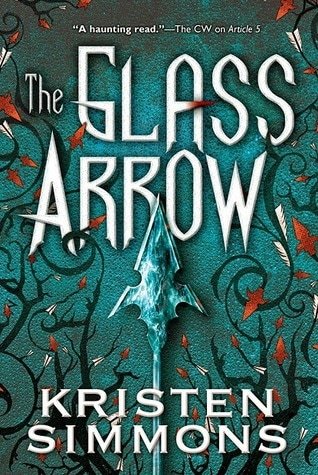 Featuring a dystopian society where a caste system reduces women to become enslaved, Aya becomes captured after living and surviving in the wilderness. She is sold to a facility called “The Garden” where women are housed and sold for breeding rights. When Aya is sold to the wealthy Mayor Rykor, she begins to plan her escape, all the while striking up an unexpected friendship with the mayor’s son.
Featuring a dystopian society where a caste system reduces women to become enslaved, Aya becomes captured after living and surviving in the wilderness. She is sold to a facility called “The Garden” where women are housed and sold for breeding rights. When Aya is sold to the wealthy Mayor Rykor, she begins to plan her escape, all the while striking up an unexpected friendship with the mayor’s son.
#2: Children of Men by PD James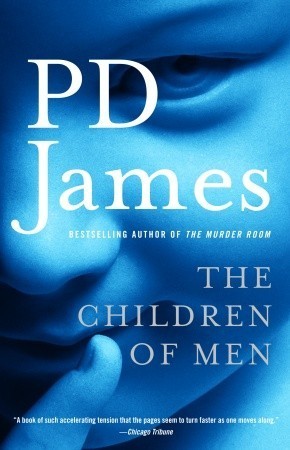 The world in Children of Men has been plagued by infertility. After the planet’s youngest person dies, hope becomes diminished for future generations. The race to find a scientific cure has bred distrust between nations, leaving England to be cut off from the rest of the world under a dictatorship. Told in his diary entires, the novel focuses on Theo Faron, a 50-year-old Oxford man and cousin to the Warden of England. He’s one day approached by a young woman asking him to meet a group known as Five Fishes. The group’s aim is to erase human rights abuses and restore a democratic government. But Theo has his own demons to be burden with, and is uninterested in the Five Fishes morals. That is, until he and a group of rebels discover a life-changing secret – a pregnant women. Theo later learns that while some fight to keep her identity under wraps, other have much more sinister intentions.
The world in Children of Men has been plagued by infertility. After the planet’s youngest person dies, hope becomes diminished for future generations. The race to find a scientific cure has bred distrust between nations, leaving England to be cut off from the rest of the world under a dictatorship. Told in his diary entires, the novel focuses on Theo Faron, a 50-year-old Oxford man and cousin to the Warden of England. He’s one day approached by a young woman asking him to meet a group known as Five Fishes. The group’s aim is to erase human rights abuses and restore a democratic government. But Theo has his own demons to be burden with, and is uninterested in the Five Fishes morals. That is, until he and a group of rebels discover a life-changing secret – a pregnant women. Theo later learns that while some fight to keep her identity under wraps, other have much more sinister intentions.
#1: The Core of the Sun by Johanna Sinisalo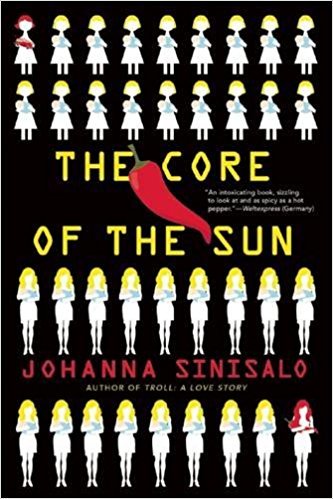 In this Finnish modern classic, there are two types of women: the “eloi” and the “morlocks.” The elois are bred and taught to be the ideal housewife and mother, while the morlocks – smarter but unfeminine – are banned from having children. Vanna is a young woman who looks and acts like an eloi but is secretly a morlock. When she gets separated from her eloi sister, Vanna must keep her secret as a morlock from the authorities, or risk getting sterilized. That is, if her chili pepper addiction doesn’t kill her first.
In this Finnish modern classic, there are two types of women: the “eloi” and the “morlocks.” The elois are bred and taught to be the ideal housewife and mother, while the morlocks – smarter but unfeminine – are banned from having children. Vanna is a young woman who looks and acts like an eloi but is secretly a morlock. When she gets separated from her eloi sister, Vanna must keep her secret as a morlock from the authorities, or risk getting sterilized. That is, if her chili pepper addiction doesn’t kill her first.
Happy Readings!!!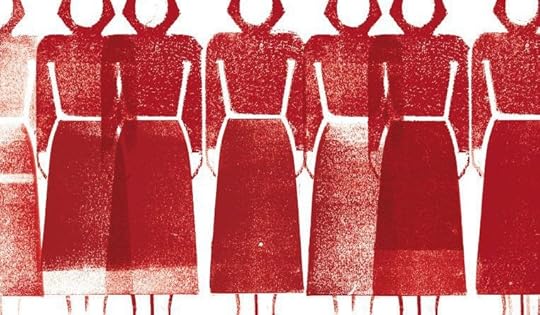
 On Wednesday, April 26th, Hulu aired the first three episodes of their highly anticipated, dystopian series. The premise of the story, imagines America in which Christian fundamentalists have staged a coup in the wake of the declining birthrates. This replacement of American democracy ushers in a repressive theocratic regime called the Republic of Gilead. The new government enslaves fertile women to become “handmaids,” assigned to bear children for wealthy and powerful men and their barren wives. The main character, Offred, is sent to live in sexual servitude with Commander Fred Waterford and his former televangelist wife, Serena Joy. Offred reveals through flashbacks what the bygone days were like before the Republic of Gilead was established, and reminisces over her husband and loving daughter.
On Wednesday, April 26th, Hulu aired the first three episodes of their highly anticipated, dystopian series. The premise of the story, imagines America in which Christian fundamentalists have staged a coup in the wake of the declining birthrates. This replacement of American democracy ushers in a repressive theocratic regime called the Republic of Gilead. The new government enslaves fertile women to become “handmaids,” assigned to bear children for wealthy and powerful men and their barren wives. The main character, Offred, is sent to live in sexual servitude with Commander Fred Waterford and his former televangelist wife, Serena Joy. Offred reveals through flashbacks what the bygone days were like before the Republic of Gilead was established, and reminisces over her husband and loving daughter. Atwood’s novel, and the Hulu miniseries adaption revel in not just feminist ideologies, but humanitarian principals as well. It is a story about the ways in which one group of women are oppressed in a society run by the benefit of the patriarchy, while another group of women take advantage of the situation to ally themselves with male power for personal gain. Drawing on that theme, the titles below will keep you out of a slump once you’re finished watching every last second of The Handmaid’s Tale.
#10: When She Woke by Hillary Jordan
 If you get your kicks from retellings of fairytales or literary classics, Hillary Jordan’s When She Woke is right up your alley. The story is a revamped dystopian version of Nathanial Hawthorne’s The Scarlett Letter, detailing the terrifying future if we used the Ten Commandments as a legal code, while also losing all sense of Christian humility. When Jordan’s heroine, Hannah, finds that her adulterous affair with the nation’s most celebrated pastor leads her to an unwanted pregnancy, she breaks the nation’s most sacred law and seeks a back-alley abortion. However, when she gets caught and refuses to give up the name of her lover or the doctor who performed the procedure to the authorities, Hannah loses everything. In this newly developed government, Christians have done away with capital punishment, and long prison sentences have been replaced by “chroming” in which criminals are injected with a virus that turns their skin a color that represents what crimes they have committed. After Hannah is released from her month of solitary confinement, she becomes visible for her crimes, when the authorities dye her skin a bright red. While Jordan’s novel sounds like another unsubtle excoriation of American Christianity, When She Woke holds many questioning layers of prison reform, conservative church vs. conservative state, and judging someone (quite literary) by the color of their skin.
If you get your kicks from retellings of fairytales or literary classics, Hillary Jordan’s When She Woke is right up your alley. The story is a revamped dystopian version of Nathanial Hawthorne’s The Scarlett Letter, detailing the terrifying future if we used the Ten Commandments as a legal code, while also losing all sense of Christian humility. When Jordan’s heroine, Hannah, finds that her adulterous affair with the nation’s most celebrated pastor leads her to an unwanted pregnancy, she breaks the nation’s most sacred law and seeks a back-alley abortion. However, when she gets caught and refuses to give up the name of her lover or the doctor who performed the procedure to the authorities, Hannah loses everything. In this newly developed government, Christians have done away with capital punishment, and long prison sentences have been replaced by “chroming” in which criminals are injected with a virus that turns their skin a color that represents what crimes they have committed. After Hannah is released from her month of solitary confinement, she becomes visible for her crimes, when the authorities dye her skin a bright red. While Jordan’s novel sounds like another unsubtle excoriation of American Christianity, When She Woke holds many questioning layers of prison reform, conservative church vs. conservative state, and judging someone (quite literary) by the color of their skin. #9: Wither by Lauren DeStefano
 Sex! Lies! And sister wives? In Lauren DeStefano’s debut novel, Wither, genetic engineering leads to the creation of perfect children, however no one suspects the long-term effects until from the second generation onward, children who were born seemingly healthy and strong start dying at the ages of 20 and 25. In a desperate attempt to save the human race from extinction, the rich and privileged, kidnap young girls and sell them into polygamous marriages in the hopes that the babies conceived to such unions will give them time to discovering a cure. When sixteen-year-old Rhine ends up as one of these kidnapped victims along with two other girls, she finds herself bought and shuffled off to a new life as one of the Governor’s pampered wives. However, Rhine quickly comes to grips with the reality of her situation. The Governor’s first wife – and childhood sweetheart – has hit the fatal age of 20 and is dying. Rhine, with her heterochromatic eyes is intended to take her place as the Governor’s first wife. Along with Jenna, a girl who is vocal about her hatred to the world they’ve entered, and Cecily, a thirteen-year-old orphan who is too overly excited to be one of the Governor’s wives. Despite being imprisoned within the Governor’s house, Rhine’s predicament becomes even more complicated when she begins a forbidden relationship with one of the Governor’s servants named Gabriel. Wither is the first book in DeStefano’s The Chemical Garden Trilogy.
Sex! Lies! And sister wives? In Lauren DeStefano’s debut novel, Wither, genetic engineering leads to the creation of perfect children, however no one suspects the long-term effects until from the second generation onward, children who were born seemingly healthy and strong start dying at the ages of 20 and 25. In a desperate attempt to save the human race from extinction, the rich and privileged, kidnap young girls and sell them into polygamous marriages in the hopes that the babies conceived to such unions will give them time to discovering a cure. When sixteen-year-old Rhine ends up as one of these kidnapped victims along with two other girls, she finds herself bought and shuffled off to a new life as one of the Governor’s pampered wives. However, Rhine quickly comes to grips with the reality of her situation. The Governor’s first wife – and childhood sweetheart – has hit the fatal age of 20 and is dying. Rhine, with her heterochromatic eyes is intended to take her place as the Governor’s first wife. Along with Jenna, a girl who is vocal about her hatred to the world they’ve entered, and Cecily, a thirteen-year-old orphan who is too overly excited to be one of the Governor’s wives. Despite being imprisoned within the Governor’s house, Rhine’s predicament becomes even more complicated when she begins a forbidden relationship with one of the Governor’s servants named Gabriel. Wither is the first book in DeStefano’s The Chemical Garden Trilogy. #8: Only Ever Yours by Louise O'Neill
 Delving into the concept of how we treat women in our day-to-day lives, Louise O’Neill’s harrowing novel, Only Ever Yours takes a magnifying glass and amplifies the misogynistic attitudes of how women are objectified. Set in a dystopian world where baby girls are no longer born naturally, genetically engineered women have been created who are able to conceive only male children. However, these engineered women are seen as state property and are therefore of extremely low status. Men view these women as second-class citizens, so much so that no one even give them the courtesy of providing them with capital letters at the start of their names. By the age of sixteen, these girls are sent to an institution called “School” where the lessons include Beauty Therapy and Comparison Studies. The ultimate goal for every girl in the School is to be chosen as a companion (a wife). However, the unchosen girls get left behind as concubines or teachers, because they have been deemed unable to please a man. Worse, because of the limited spaces available to find a companion, the girls are set against one another and tear each other apart. For best friends freida and isabel, they are certain to be chosen as companions until isabel starts to put on some pounds – a quality that is frowned upon at the School. The characters are subjected to more extreme version of the pressures women face everyday. They are encouraged to starve themselves, always act happy-go-lucky and forbid tears in the presence of men. O’Neill dark version of female suppression forces readers to take a long hard look at our own society, and recognize the possibility that fiction might actually be on the brink to fact.
Delving into the concept of how we treat women in our day-to-day lives, Louise O’Neill’s harrowing novel, Only Ever Yours takes a magnifying glass and amplifies the misogynistic attitudes of how women are objectified. Set in a dystopian world where baby girls are no longer born naturally, genetically engineered women have been created who are able to conceive only male children. However, these engineered women are seen as state property and are therefore of extremely low status. Men view these women as second-class citizens, so much so that no one even give them the courtesy of providing them with capital letters at the start of their names. By the age of sixteen, these girls are sent to an institution called “School” where the lessons include Beauty Therapy and Comparison Studies. The ultimate goal for every girl in the School is to be chosen as a companion (a wife). However, the unchosen girls get left behind as concubines or teachers, because they have been deemed unable to please a man. Worse, because of the limited spaces available to find a companion, the girls are set against one another and tear each other apart. For best friends freida and isabel, they are certain to be chosen as companions until isabel starts to put on some pounds – a quality that is frowned upon at the School. The characters are subjected to more extreme version of the pressures women face everyday. They are encouraged to starve themselves, always act happy-go-lucky and forbid tears in the presence of men. O’Neill dark version of female suppression forces readers to take a long hard look at our own society, and recognize the possibility that fiction might actually be on the brink to fact. #7: The Jewel by Amy Ewing
 The Jewel is the first book from The Lone City series by Amy Ewing. A tense tale about Violet Lasting’s life after she gets auctioned off as surrogate mother. Violet’s job is to carry the child of the woman who buys her, until she realizes that the true purchaser is the Duchess of the Lake, one of the four founding families of the city called The Jewel. The Duchess of the Lake begins to pamper and punish Violet, eager to implant a child within her that will win the ruling Electress and Exeter’s favor. Violet was born with a certain gene and the special power of Augury (transformative magic) that makes the royals of the land take more notice of her. However, Violet soon discovers how dangerous it is to be a surrogate for the aristocratic circle of The Jewel as she tries to hold on to her identity and sanity under the watchful eyes of the Duchess. Then she meets Ash, the hired companion for the Duchess’s niece. Together, they come to realize the scale of the treachery that The Jewel holds, as well as becoming the others endangerment.
The Jewel is the first book from The Lone City series by Amy Ewing. A tense tale about Violet Lasting’s life after she gets auctioned off as surrogate mother. Violet’s job is to carry the child of the woman who buys her, until she realizes that the true purchaser is the Duchess of the Lake, one of the four founding families of the city called The Jewel. The Duchess of the Lake begins to pamper and punish Violet, eager to implant a child within her that will win the ruling Electress and Exeter’s favor. Violet was born with a certain gene and the special power of Augury (transformative magic) that makes the royals of the land take more notice of her. However, Violet soon discovers how dangerous it is to be a surrogate for the aristocratic circle of The Jewel as she tries to hold on to her identity and sanity under the watchful eyes of the Duchess. Then she meets Ash, the hired companion for the Duchess’s niece. Together, they come to realize the scale of the treachery that The Jewel holds, as well as becoming the others endangerment. #6: Bumped by Megan McCafferty
 Yes, another dystopian title, but with teen pregnancies. Are you starting to sense a theme here? A virus has come along, making people over the age of 18 sterile. Teenagers and pre-teens are encouraged to by society to “bump” as early as possible. In this universe, boys and girls are bound by contracts, rewarded with luxury, and are paid in six figure advances for their offspring. Melody gets adopted by a pair of aspiring professors and must fulfill her contract by finding a suitable match that is compatible with her genetic desirability. Then there’s Harmony, Melody’s identical twin sister. The two girls were separated at birth, and unlike Melody who has an agent scouting out the perfect companion for her, Harmony is taken in by a small religious community called Goodside. When Harmony discovers that she has a missing twin, she immediately leaves Goodside to find her. However, Harmony’s presence might screw up Melody’s chance of a secure and successful future.
Yes, another dystopian title, but with teen pregnancies. Are you starting to sense a theme here? A virus has come along, making people over the age of 18 sterile. Teenagers and pre-teens are encouraged to by society to “bump” as early as possible. In this universe, boys and girls are bound by contracts, rewarded with luxury, and are paid in six figure advances for their offspring. Melody gets adopted by a pair of aspiring professors and must fulfill her contract by finding a suitable match that is compatible with her genetic desirability. Then there’s Harmony, Melody’s identical twin sister. The two girls were separated at birth, and unlike Melody who has an agent scouting out the perfect companion for her, Harmony is taken in by a small religious community called Goodside. When Harmony discovers that she has a missing twin, she immediately leaves Goodside to find her. However, Harmony’s presence might screw up Melody’s chance of a secure and successful future. #5: Herland by Charlotte Perkins Gilman
 Written in 1915, Herland is the first book in the Gilman’s feminist utopian trilogy. The story describes a society cut off from civilization composed entirely of women, who’ve learned how to reproduced via asexual reproduction, and who are free from wars, conflicts and dominations. That is, until three men learn about this all-female society and try to take it over. Little do they know, that the women of Herland are not only self-sufficient, but are also capable of doing “men’s work.” Each of the men draw their own stereotypes on the women. Jeff regards women as thing to be serves and protected. Terry views the women as prized possessions to be conquered and won. And unlike his two companions, Van tries to understand the principles on which Herland is built. Gilman’s argument for gender equality is thought-provoking and asks its readers to recognize that women are just as valuable and intelligent as men.
Written in 1915, Herland is the first book in the Gilman’s feminist utopian trilogy. The story describes a society cut off from civilization composed entirely of women, who’ve learned how to reproduced via asexual reproduction, and who are free from wars, conflicts and dominations. That is, until three men learn about this all-female society and try to take it over. Little do they know, that the women of Herland are not only self-sufficient, but are also capable of doing “men’s work.” Each of the men draw their own stereotypes on the women. Jeff regards women as thing to be serves and protected. Terry views the women as prized possessions to be conquered and won. And unlike his two companions, Van tries to understand the principles on which Herland is built. Gilman’s argument for gender equality is thought-provoking and asks its readers to recognize that women are just as valuable and intelligent as men. #4: Daughters of the North by Sarah Hall
 Think of this novel as a reversed version of The Handmaid’s Tale. Instead of women living in a repressive theocratic regime forced into involuntary breeding due to declined birthrates; Daughters of the North takes place in post-apocalyptic England where only those selected in a lottery are allowed to become pregnant. Every other women of childbearing age is forced to be fitted for an IUD or to be sterilized to avoid overpopulation. The main character, Sister, escapes from her zone after being traumatized by her procedure, and finds herself in the female utopia of Carhullan. However, while Carhullan is a sanctuary for women, Sister begins to realize that the place she has fled too is not so dissimilar from the cruel society that she left behind.
Think of this novel as a reversed version of The Handmaid’s Tale. Instead of women living in a repressive theocratic regime forced into involuntary breeding due to declined birthrates; Daughters of the North takes place in post-apocalyptic England where only those selected in a lottery are allowed to become pregnant. Every other women of childbearing age is forced to be fitted for an IUD or to be sterilized to avoid overpopulation. The main character, Sister, escapes from her zone after being traumatized by her procedure, and finds herself in the female utopia of Carhullan. However, while Carhullan is a sanctuary for women, Sister begins to realize that the place she has fled too is not so dissimilar from the cruel society that she left behind. #3: The Glass Arrow by Kristen Simmons
 Featuring a dystopian society where a caste system reduces women to become enslaved, Aya becomes captured after living and surviving in the wilderness. She is sold to a facility called “The Garden” where women are housed and sold for breeding rights. When Aya is sold to the wealthy Mayor Rykor, she begins to plan her escape, all the while striking up an unexpected friendship with the mayor’s son.
Featuring a dystopian society where a caste system reduces women to become enslaved, Aya becomes captured after living and surviving in the wilderness. She is sold to a facility called “The Garden” where women are housed and sold for breeding rights. When Aya is sold to the wealthy Mayor Rykor, she begins to plan her escape, all the while striking up an unexpected friendship with the mayor’s son. #2: Children of Men by PD James
 The world in Children of Men has been plagued by infertility. After the planet’s youngest person dies, hope becomes diminished for future generations. The race to find a scientific cure has bred distrust between nations, leaving England to be cut off from the rest of the world under a dictatorship. Told in his diary entires, the novel focuses on Theo Faron, a 50-year-old Oxford man and cousin to the Warden of England. He’s one day approached by a young woman asking him to meet a group known as Five Fishes. The group’s aim is to erase human rights abuses and restore a democratic government. But Theo has his own demons to be burden with, and is uninterested in the Five Fishes morals. That is, until he and a group of rebels discover a life-changing secret – a pregnant women. Theo later learns that while some fight to keep her identity under wraps, other have much more sinister intentions.
The world in Children of Men has been plagued by infertility. After the planet’s youngest person dies, hope becomes diminished for future generations. The race to find a scientific cure has bred distrust between nations, leaving England to be cut off from the rest of the world under a dictatorship. Told in his diary entires, the novel focuses on Theo Faron, a 50-year-old Oxford man and cousin to the Warden of England. He’s one day approached by a young woman asking him to meet a group known as Five Fishes. The group’s aim is to erase human rights abuses and restore a democratic government. But Theo has his own demons to be burden with, and is uninterested in the Five Fishes morals. That is, until he and a group of rebels discover a life-changing secret – a pregnant women. Theo later learns that while some fight to keep her identity under wraps, other have much more sinister intentions. #1: The Core of the Sun by Johanna Sinisalo
 In this Finnish modern classic, there are two types of women: the “eloi” and the “morlocks.” The elois are bred and taught to be the ideal housewife and mother, while the morlocks – smarter but unfeminine – are banned from having children. Vanna is a young woman who looks and acts like an eloi but is secretly a morlock. When she gets separated from her eloi sister, Vanna must keep her secret as a morlock from the authorities, or risk getting sterilized. That is, if her chili pepper addiction doesn’t kill her first.
In this Finnish modern classic, there are two types of women: the “eloi” and the “morlocks.” The elois are bred and taught to be the ideal housewife and mother, while the morlocks – smarter but unfeminine – are banned from having children. Vanna is a young woman who looks and acts like an eloi but is secretly a morlock. When she gets separated from her eloi sister, Vanna must keep her secret as a morlock from the authorities, or risk getting sterilized. That is, if her chili pepper addiction doesn’t kill her first. Happy Readings!!!

Published on April 25, 2017 16:30
March 25, 2017
Celebrating St. Patrick’s Day in Boston
If no one has told you yet, St. Patrick’s Day in Boston is pretty crazy.
From a city that has one of the largest Irish populations in the country, you can be sure that every Irish pub, nightclub and neighborhood goes all out for the celebration of Ireland’s patron saint.
Pools are dyed green, people chug entire cans of Guinness, and everyone gets drunk.
And if St. Patrick’s Day falls on a Friday, your weekend will feel like a never ending party, followed by a lovely hangover on Monday morning.
So how does one survive this mass chaos of green insanity?
Well, you can stay in-doors to avoid whole weekend shenanigans all together.
Or, you can dig through of what remains in your pot of gold and purchase yourself some bright green clothes to wear as you hit up the town.
#1: Ned Devine’s! As soon as work ends, you get yourself over to the nearest nightclub as soon as possible. It’s known that people on St. Patrick’s Day start drinking as early as 8 AM and don’t stop until 2 AM. Lines will be formed out the door at 5 o’clock, for young partiers seeking admission into the most popular nightclubs in Boston.
As soon as work ends, you get yourself over to the nearest nightclub as soon as possible. It’s known that people on St. Patrick’s Day start drinking as early as 8 AM and don’t stop until 2 AM. Lines will be formed out the door at 5 o’clock, for young partiers seeking admission into the most popular nightclubs in Boston.
And the most sought after nightclub in all of Boston on St. Patrick’s Day is Ned Devine’s.
What’s not to love about Ned’s? Ned's reputation promises the vibrant authenticity of an Irish atmosphere. With live music, and a fantastic location in the Faneuil Hall and Quincy Market area, this triple threat establishment is the hottest spot to be when the sun goes down and the party really begins.
If St. Patrick’s Day doesn’t fall on a workday, you can possibly stay and celebrate the whole time at Ned Devine’s. It’s a restaurant by day, and an amped up party destination at night.
Filled with dim lighting from the wrought iron chandeliers to create a laid-back ambiance, the third floor of Ned Devine’s is a sociable and eclectic watering hole, for partying up St. Patrick’s Day to the fullest.
#2: The Southie St. Patrick’s Day Parade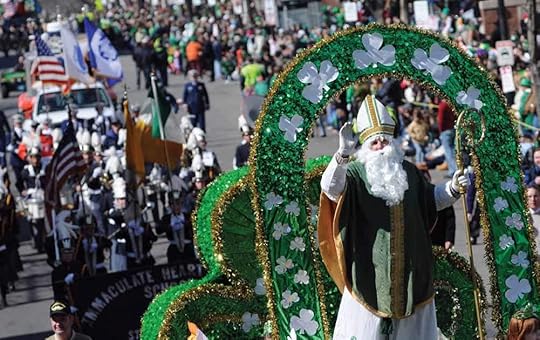 If you’re not too hungover, the Sunday that follows St. Patrick’s Day, is the annual Southie St. Patrick’s Day Parade. Join the large crowds as they descend onto the street of South Boston to watch the parade take place. There’s no shortage of green clothing, shamrock headbands and someone dressed up as a leprechaun. The only downside is that the Boston police have a strict public drinking policy, so watching the parade outside with your green beer may not happen.
If you’re not too hungover, the Sunday that follows St. Patrick’s Day, is the annual Southie St. Patrick’s Day Parade. Join the large crowds as they descend onto the street of South Boston to watch the parade take place. There’s no shortage of green clothing, shamrock headbands and someone dressed up as a leprechaun. The only downside is that the Boston police have a strict public drinking policy, so watching the parade outside with your green beer may not happen.
But it’s not all bad.
If you really want to celebrate St. Patrick’s Day properly, there’s no better place than observing the holiday in Southie. House parties will be happening before, during and after the parade. And if there’s one thing that people love after standing and watching a parade, it's getting wasted.
#3: Irish Pubs Nothing is better on St. Patrick’s Day Party than a bar crawling to all of the best Irish pubs in Boston. Boston’s Irish pubs are ingrained into the city’s history, inviting an authentic feel for those who enter. Just to name a few:
Nothing is better on St. Patrick’s Day Party than a bar crawling to all of the best Irish pubs in Boston. Boston’s Irish pubs are ingrained into the city’s history, inviting an authentic feel for those who enter. Just to name a few:
The Banshee
934 Dorchester Ave.
Boston, MA 02125 A lively sports bar, the Banshee is the official home to watching international soccer. It’s also the most reliable place in town to catch Gaelic sports like rugby and hurling. Chances are that if you’re big into European sports, your game will most likely be broadcasted on one of the Banshee's 10 flat screen TVs.
A lively sports bar, the Banshee is the official home to watching international soccer. It’s also the most reliable place in town to catch Gaelic sports like rugby and hurling. Chances are that if you’re big into European sports, your game will most likely be broadcasted on one of the Banshee's 10 flat screen TVs.
McGreevy's
911 Boylston St.
Boston, MA 02115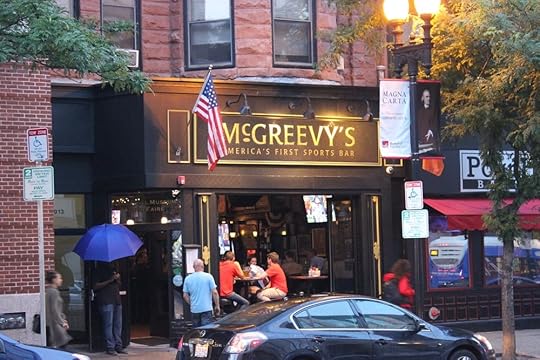 Boston Red Sox fans will find a lot to love in McGreevy’s. For starters, this is the Boston bar where the first Red Sox's fan club began. Now given new life by local Celtic punk rockers, The Dropkick Murphys, McGreevy's also doubles as a Boston Irish pub and a popular sports bar. Better yet, McGreevy's is America's first documented sports-themed bar and is a big hit for baseball enthusiasts.
Boston Red Sox fans will find a lot to love in McGreevy’s. For starters, this is the Boston bar where the first Red Sox's fan club began. Now given new life by local Celtic punk rockers, The Dropkick Murphys, McGreevy's also doubles as a Boston Irish pub and a popular sports bar. Better yet, McGreevy's is America's first documented sports-themed bar and is a big hit for baseball enthusiasts.
The Black Rose
160 State St.
Boston, MA 02109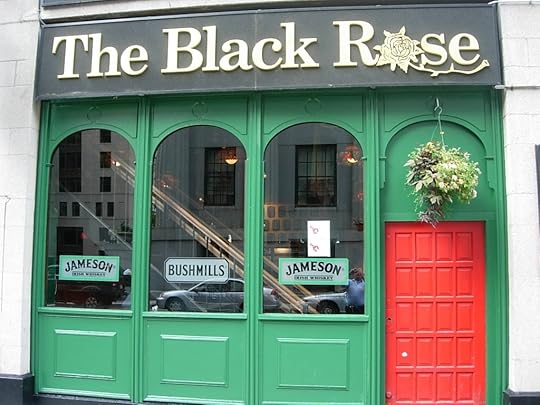 If you're seeking an Irish pub near Faneuil Hall (that isn’t Ned Devine’s) visit this spot that’s been serving pints in Boston for the past 40 years. Traditional Irish music happens there seven days a week, and the menu manages to combine the taste of New England with Irish treats. It really is the best of both worlds.
If you're seeking an Irish pub near Faneuil Hall (that isn’t Ned Devine’s) visit this spot that’s been serving pints in Boston for the past 40 years. Traditional Irish music happens there seven days a week, and the menu manages to combine the taste of New England with Irish treats. It really is the best of both worlds.
The L Street Tavern
658 E 8th St.
Boston, MA 02127 This corner bar has dark woodwork, stained glass details, and (often crowded) community atmosphere you’d expect from a classic Boston Irish pub. This is likely why the producers of Good Will Hunting chose to film some scenes from the Oscar-winning movie. It was here at The L Street Tavern that the first glass of legal suds was poured immediately after the repeal of Prohibition in 1933. That said, the establishment was most likely selling illegal alcohol when they operated as a speakeasies back in the day.
This corner bar has dark woodwork, stained glass details, and (often crowded) community atmosphere you’d expect from a classic Boston Irish pub. This is likely why the producers of Good Will Hunting chose to film some scenes from the Oscar-winning movie. It was here at The L Street Tavern that the first glass of legal suds was poured immediately after the repeal of Prohibition in 1933. That said, the establishment was most likely selling illegal alcohol when they operated as a speakeasies back in the day.
#4: Dropkick Murphys in Boston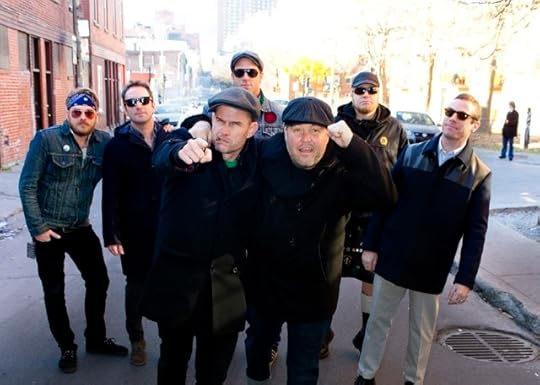 While Boston's famous Celtic punk rock group spends most of their time touring around the states, they always return on St. Patrick’s Day to perform around the city.
While Boston's famous Celtic punk rock group spends most of their time touring around the states, they always return on St. Patrick’s Day to perform around the city.
With Beantown anthems like “I’m Shipping Up to Boston” and “Tessie”, it goes without saying that the Dropkick Murphy’s performances sell out quickly. Their performances are now a St. Patrick’s Day tradition. They’ll play six shows around the holiday: four at the House of Blues, one at Agannis Arena, and one at a secret to-be-announced location.
But if you’re a huge fan and want to catch them in concert on St. Patrick’s Day, buy your tickets months in advance.
#5: St. Patrick’s Day Celebration at Harpoon Brewery St. Patrick’s Day doesn’t officially start until Harpoon throws its annual St. Patrick’s Day festival. Thousands of people gather, dancing to live music, enjoying beers, and the freshly homemade soft pretzels at Boston’s largest brewery. The Harpoon St. Patrick’s Day Festival traditionally takes place a couple of weeks before March 17th.
St. Patrick’s Day doesn’t officially start until Harpoon throws its annual St. Patrick’s Day festival. Thousands of people gather, dancing to live music, enjoying beers, and the freshly homemade soft pretzels at Boston’s largest brewery. The Harpoon St. Patrick’s Day Festival traditionally takes place a couple of weeks before March 17th.
So dance a jig to traditional Irish music while enjoying a nice freshly brewed Harpoon beer. Cover charge includes a souvenir pint glass and two free drink tickets. So everybody is a little bit Irish this time of year around Boston. Whether you are looking at going hard and drinking from Friday to Sunday, enjoying the semi-warm weather outside to watch the parade, or getting together with friends to participate in all of the city’s festivities.
So everybody is a little bit Irish this time of year around Boston. Whether you are looking at going hard and drinking from Friday to Sunday, enjoying the semi-warm weather outside to watch the parade, or getting together with friends to participate in all of the city’s festivities.
You’ll have a lot to choose from in Massachusetts.
And remember, if all else fails, you can always dye your pool green.
From a city that has one of the largest Irish populations in the country, you can be sure that every Irish pub, nightclub and neighborhood goes all out for the celebration of Ireland’s patron saint.
Pools are dyed green, people chug entire cans of Guinness, and everyone gets drunk.
And if St. Patrick’s Day falls on a Friday, your weekend will feel like a never ending party, followed by a lovely hangover on Monday morning.
So how does one survive this mass chaos of green insanity?
Well, you can stay in-doors to avoid whole weekend shenanigans all together.
Or, you can dig through of what remains in your pot of gold and purchase yourself some bright green clothes to wear as you hit up the town.
#1: Ned Devine’s!
 As soon as work ends, you get yourself over to the nearest nightclub as soon as possible. It’s known that people on St. Patrick’s Day start drinking as early as 8 AM and don’t stop until 2 AM. Lines will be formed out the door at 5 o’clock, for young partiers seeking admission into the most popular nightclubs in Boston.
As soon as work ends, you get yourself over to the nearest nightclub as soon as possible. It’s known that people on St. Patrick’s Day start drinking as early as 8 AM and don’t stop until 2 AM. Lines will be formed out the door at 5 o’clock, for young partiers seeking admission into the most popular nightclubs in Boston.And the most sought after nightclub in all of Boston on St. Patrick’s Day is Ned Devine’s.
What’s not to love about Ned’s? Ned's reputation promises the vibrant authenticity of an Irish atmosphere. With live music, and a fantastic location in the Faneuil Hall and Quincy Market area, this triple threat establishment is the hottest spot to be when the sun goes down and the party really begins.
If St. Patrick’s Day doesn’t fall on a workday, you can possibly stay and celebrate the whole time at Ned Devine’s. It’s a restaurant by day, and an amped up party destination at night.
Filled with dim lighting from the wrought iron chandeliers to create a laid-back ambiance, the third floor of Ned Devine’s is a sociable and eclectic watering hole, for partying up St. Patrick’s Day to the fullest.
#2: The Southie St. Patrick’s Day Parade
 If you’re not too hungover, the Sunday that follows St. Patrick’s Day, is the annual Southie St. Patrick’s Day Parade. Join the large crowds as they descend onto the street of South Boston to watch the parade take place. There’s no shortage of green clothing, shamrock headbands and someone dressed up as a leprechaun. The only downside is that the Boston police have a strict public drinking policy, so watching the parade outside with your green beer may not happen.
If you’re not too hungover, the Sunday that follows St. Patrick’s Day, is the annual Southie St. Patrick’s Day Parade. Join the large crowds as they descend onto the street of South Boston to watch the parade take place. There’s no shortage of green clothing, shamrock headbands and someone dressed up as a leprechaun. The only downside is that the Boston police have a strict public drinking policy, so watching the parade outside with your green beer may not happen. But it’s not all bad.
If you really want to celebrate St. Patrick’s Day properly, there’s no better place than observing the holiday in Southie. House parties will be happening before, during and after the parade. And if there’s one thing that people love after standing and watching a parade, it's getting wasted.
#3: Irish Pubs
 Nothing is better on St. Patrick’s Day Party than a bar crawling to all of the best Irish pubs in Boston. Boston’s Irish pubs are ingrained into the city’s history, inviting an authentic feel for those who enter. Just to name a few:
Nothing is better on St. Patrick’s Day Party than a bar crawling to all of the best Irish pubs in Boston. Boston’s Irish pubs are ingrained into the city’s history, inviting an authentic feel for those who enter. Just to name a few:
The Banshee
934 Dorchester Ave.
Boston, MA 02125
 A lively sports bar, the Banshee is the official home to watching international soccer. It’s also the most reliable place in town to catch Gaelic sports like rugby and hurling. Chances are that if you’re big into European sports, your game will most likely be broadcasted on one of the Banshee's 10 flat screen TVs.
A lively sports bar, the Banshee is the official home to watching international soccer. It’s also the most reliable place in town to catch Gaelic sports like rugby and hurling. Chances are that if you’re big into European sports, your game will most likely be broadcasted on one of the Banshee's 10 flat screen TVs.McGreevy's
911 Boylston St.
Boston, MA 02115
 Boston Red Sox fans will find a lot to love in McGreevy’s. For starters, this is the Boston bar where the first Red Sox's fan club began. Now given new life by local Celtic punk rockers, The Dropkick Murphys, McGreevy's also doubles as a Boston Irish pub and a popular sports bar. Better yet, McGreevy's is America's first documented sports-themed bar and is a big hit for baseball enthusiasts.
Boston Red Sox fans will find a lot to love in McGreevy’s. For starters, this is the Boston bar where the first Red Sox's fan club began. Now given new life by local Celtic punk rockers, The Dropkick Murphys, McGreevy's also doubles as a Boston Irish pub and a popular sports bar. Better yet, McGreevy's is America's first documented sports-themed bar and is a big hit for baseball enthusiasts. The Black Rose
160 State St.
Boston, MA 02109
 If you're seeking an Irish pub near Faneuil Hall (that isn’t Ned Devine’s) visit this spot that’s been serving pints in Boston for the past 40 years. Traditional Irish music happens there seven days a week, and the menu manages to combine the taste of New England with Irish treats. It really is the best of both worlds.
If you're seeking an Irish pub near Faneuil Hall (that isn’t Ned Devine’s) visit this spot that’s been serving pints in Boston for the past 40 years. Traditional Irish music happens there seven days a week, and the menu manages to combine the taste of New England with Irish treats. It really is the best of both worlds.The L Street Tavern
658 E 8th St.
Boston, MA 02127
 This corner bar has dark woodwork, stained glass details, and (often crowded) community atmosphere you’d expect from a classic Boston Irish pub. This is likely why the producers of Good Will Hunting chose to film some scenes from the Oscar-winning movie. It was here at The L Street Tavern that the first glass of legal suds was poured immediately after the repeal of Prohibition in 1933. That said, the establishment was most likely selling illegal alcohol when they operated as a speakeasies back in the day.
This corner bar has dark woodwork, stained glass details, and (often crowded) community atmosphere you’d expect from a classic Boston Irish pub. This is likely why the producers of Good Will Hunting chose to film some scenes from the Oscar-winning movie. It was here at The L Street Tavern that the first glass of legal suds was poured immediately after the repeal of Prohibition in 1933. That said, the establishment was most likely selling illegal alcohol when they operated as a speakeasies back in the day.#4: Dropkick Murphys in Boston
 While Boston's famous Celtic punk rock group spends most of their time touring around the states, they always return on St. Patrick’s Day to perform around the city.
While Boston's famous Celtic punk rock group spends most of their time touring around the states, they always return on St. Patrick’s Day to perform around the city. With Beantown anthems like “I’m Shipping Up to Boston” and “Tessie”, it goes without saying that the Dropkick Murphy’s performances sell out quickly. Their performances are now a St. Patrick’s Day tradition. They’ll play six shows around the holiday: four at the House of Blues, one at Agannis Arena, and one at a secret to-be-announced location.
But if you’re a huge fan and want to catch them in concert on St. Patrick’s Day, buy your tickets months in advance.
#5: St. Patrick’s Day Celebration at Harpoon Brewery
 St. Patrick’s Day doesn’t officially start until Harpoon throws its annual St. Patrick’s Day festival. Thousands of people gather, dancing to live music, enjoying beers, and the freshly homemade soft pretzels at Boston’s largest brewery. The Harpoon St. Patrick’s Day Festival traditionally takes place a couple of weeks before March 17th.
St. Patrick’s Day doesn’t officially start until Harpoon throws its annual St. Patrick’s Day festival. Thousands of people gather, dancing to live music, enjoying beers, and the freshly homemade soft pretzels at Boston’s largest brewery. The Harpoon St. Patrick’s Day Festival traditionally takes place a couple of weeks before March 17th. So dance a jig to traditional Irish music while enjoying a nice freshly brewed Harpoon beer. Cover charge includes a souvenir pint glass and two free drink tickets.
 So everybody is a little bit Irish this time of year around Boston. Whether you are looking at going hard and drinking from Friday to Sunday, enjoying the semi-warm weather outside to watch the parade, or getting together with friends to participate in all of the city’s festivities.
So everybody is a little bit Irish this time of year around Boston. Whether you are looking at going hard and drinking from Friday to Sunday, enjoying the semi-warm weather outside to watch the parade, or getting together with friends to participate in all of the city’s festivities. You’ll have a lot to choose from in Massachusetts.
And remember, if all else fails, you can always dye your pool green.

Published on March 25, 2017 22:26
February 28, 2017
How To Survive A New England Snowstorm
To all my California friends, there’s a whole lot of snow in New England right now.
For many, you might not even care. If so, I would suggest that you remain ignorant to the East Coast weather and enjoy your round the clock sunny forecast. Although, last time I checked, the Glendale Galleria parking structure was completely flooded thanks to the storm that hit Southern California last weekend.
When I first saw snow for the first time, I freaked out.
Mind you, I lived in a part of the state where the changing of the seasons was essentially non-existent. We didn’t have the vibrant beautiful fall foliage like in New Hampshire or in Massachusetts. The San Gabriel Mountains never flooded upon thousands of gold, red, yellow, orange or even purple hues to match the autumn weather. In the winter, the air got a bit chilly, but it was always sunny. It never snowed in Los Angeles nor in my hometown. So I had to base my assumptions on snow from watching television and reading books.
For 20 years, I had no idea what snow formally looked like nor knew what snow felt like. From the literature I would pick up and the programs I would watch, I had these preconceived ideas that snow was fluffy, it was soft, and that it weighed and tasted the same as cotton candy.
Don’t ask why.
So when I finally – FINALLY – saw snow and touched it for the first time, I was very confused. It was nothing compared to the image that I originally had in my head of what snow was like. My fingers hurt from holding it with my barehands, it was sometimes more hard than powdery, and it definitely didn’t taste like cotton candy.
That was the most disappointing realization.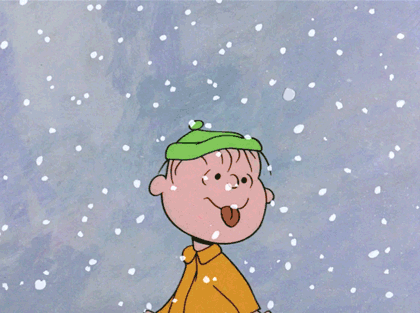 Then came my first ever snow storm and I had no idea what was happening.
Then came my first ever snow storm and I had no idea what was happening.
Again, in Southern California, we NEVER took a day off from school because of the weather. The ONLY time that had ever happened was when we had those damn Santa Ana winds mess up Pasadena back in 2012. We didn’t even take the day off if there was a wildfire. But windy weather? Oh, you better stay home.
The first time classes were canceled on my friends and I, was during the November 2012 nor’easter, Sandy. Followed by a second nor’easter in February of 2013 when classes were canceled for almost a week thanks to Hurricane Nemo.
Unfortunately, my experience staying indoors during the Santa Ana windstorms was nothing compared to the snow storms that I endured while I was in college.
Because they were so FUN!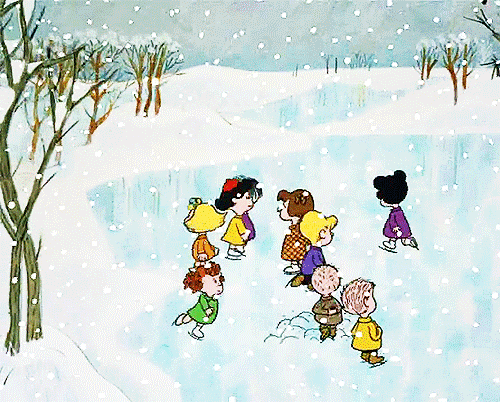 If you think I’m crazy for saying that, you’re probably right.
If you think I’m crazy for saying that, you’re probably right.
Granted, going outside during a snowstorm isn’t all that great.
But staying indoors, is awesome!
If you have the right supplies, of course.
So if you’re like me, and like watching the snow fall outside the comfort of your own home, here is how to make the most of surviving your next winter storm. All you need is good planning and determination.
#1: Purchase Alcohol While staying in during a snowstorm can be fun, it can sometimes lead to unexpected events (i.e. if your electricity or your Internet goes out), so you’ll need something to make the time pass as you wait out the blizzard.
While staying in during a snowstorm can be fun, it can sometimes lead to unexpected events (i.e. if your electricity or your Internet goes out), so you’ll need something to make the time pass as you wait out the blizzard.
Your answer: Alcohol
Make sure to run down to that liquor store around the corner of your apartment to pick up any much needed booze the day before the big storm. While you may browse between the aisles for that Budlight Beer or that hard Angry Orchard Cider, you’re allowed to spend a few extra dollars on some top-notch hooch. After all, you’re probably not going to leave your place for a while, so you’ll want something that A) Tastes good and B) Lasts for a long time.
I’m not saying that you shouldn't fill your cart with Moet & Chandon champaign up to the brim – I mean, you can, I won’t judge you – but it’s also okay to purchase that bottle of Jameson Whiskey you had your eye on for a long time, or that Patron Tequila all of your friends said tasted like honeyed caramel.
And if you really want to put some effort into your drink, make yourself a cocktail the day of the snowstorm.
I hear that hot chocolate and a shot of tequila makes a great warm winter drink.
#2: Buy ALL The Food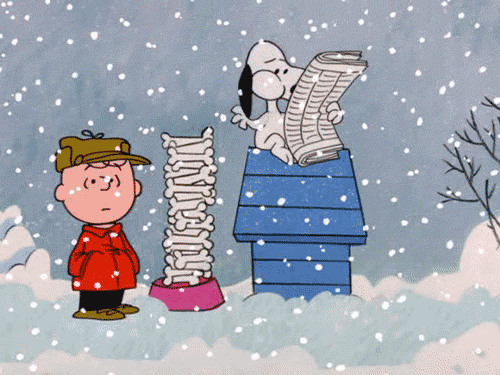 In all seriousness, while it’s great to have a bottle of Grey Goose hidden somewhere within your fridge for you and your roommates to share when the wind starts howling outside, it is crucial to also stock up the day before on food.
In all seriousness, while it’s great to have a bottle of Grey Goose hidden somewhere within your fridge for you and your roommates to share when the wind starts howling outside, it is crucial to also stock up the day before on food.
But what’s great, is that you can actually splurge on buying all of the junk food you’ve always wanted to eat.
This is now your chance to try those s’mores Goldfishes you’ve been curious about buying since you saw them on display on Aisle Five!
It goes without saying that you should definitely stock up on the necessities: bottled water, pasta, bread and spread to make sandwiches, eggs and milk.
But knowing that a snowstorm is coming, also gives you the perfect excuse to buy all the popcorn and chips you’ve always dreamed off.
It’s like buying food for a Super Bowl Party, except it’s all for you.
#3: Netflix And Chill (But For Real Though) One of the upsides of staying in during a winter snow storm, is catching up on all of those shows everyone has been chatting about at work or at school. If you get a snow weekend, that only justifies your motives to binge watch the latest Netflix, Amazon or Hulu shows online.
One of the upsides of staying in during a winter snow storm, is catching up on all of those shows everyone has been chatting about at work or at school. If you get a snow weekend, that only justifies your motives to binge watch the latest Netflix, Amazon or Hulu shows online.
If you haven’t already seen Stranger Things or The Crown, now’s your chance to do so!
Curl up on your couch (with your spiked hot chocolate no doubt) and let the marathon begin.
The entire season of The Sopranos? Boom! Done!
Mad Men? Finished!
The six hour version of Pride and Prejudice with Colin Firth? You bet you’re sweet ass you’ll be watching that.
If you’re feeling overwhelmed with selecting a TV show to watch, then movies are always a good option.
Maybe you’ll finally watch all three Lord of the Rings movies back to back while the storm rages on outside.
Or be prompted to watch Mad Max: Fury Road.
The possibilities are endless! And better yet, you have no excuse to NOT watch these movies or TV shows while you’re shut in.
#4: Catch Up On Your Reading List If you wish to feel somewhat useful during the storm, getting around to reading the books you have piled up on your bookshelf is a good place to start.
If you wish to feel somewhat useful during the storm, getting around to reading the books you have piled up on your bookshelf is a good place to start.
You know which books I’m talking about.
The ones you’ve bought six months ago and they’re still waiting to be read on your shelf.
Waiting and waiting so patiently, to have someone leaf through their pages.
It’s every bookworm’s problem to excessively buy large quantities of book and then NEVER get around to actually reading them.
Well, if you’ve stocked up the day before on food, and have a nice cozy blanket to snuggle into, then reading might be a key piece to you surviving the blizzard.
If you’re feeling lucky, you might be fortunate enough to cut down your “To-Read” list.
For others, you may want to take a nostalgic trip and crack open that dusty old copy of Edith Wharton’s Ethan Frome as you sip on some freshly brewed tea. Sure, this may be the hundredth time you have read Ethan Frome, but you can’t get enough of Wharton’s haunting winter’s tale.
Talk about setting the mood.
#5: Break Out The Games Nothing says snow day than finding out that it was Colonel Mustard who was in the study room with a candlestick in Clue; or the satisfying feeling of slapping down a WILD CARD on your opponents when playing Uno.
Nothing says snow day than finding out that it was Colonel Mustard who was in the study room with a candlestick in Clue; or the satisfying feeling of slapping down a WILD CARD on your opponents when playing Uno.
When it comes to preparing for the worst case scenario when the power and the Internet go out, board games and card games are always the best option to make the hours go by. When you think about it, no one really plays boardgames anymore because nowadays the majority of the popular games can now be played on your phone. While this is convenient for those who wish to play a game anywhere and anytime, board games on the other hand are an opportunity to interact with others face to face rather than behind a screen.
And better yet, unlike iPhone/Android games, board games don’t require batteries or charging, so you can play an epic game of Monopoly by candlelight.
#6: Get Baked Who really commits to their diet when it’s cold outside and the idea of the cozy warmth and delicious smell of baked goods is mouthwatering?
Who really commits to their diet when it’s cold outside and the idea of the cozy warmth and delicious smell of baked goods is mouthwatering?
If you’re looking for something to take up some time, then undertaking a baking project of a fresh batch of cupcakes or cookies is an resourceful way to make your entire home smell like Christmas morning.
Other soul-warming recipes are rich, flavorful broth, savory-scented vegetables, or tender and juicy meats.
So if you are an inner chef, and snow is in the forecast, have your grocery list ready and buy all of the ingredients you will need to warm up your stomach the day before.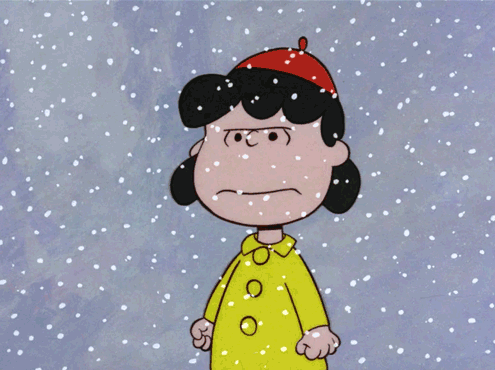 If the windows are rattling, and the sky has darkened, and you can feel the cold sneaking into your living room, just remember that there is always a way to combat against the fidget environment.
If the windows are rattling, and the sky has darkened, and you can feel the cold sneaking into your living room, just remember that there is always a way to combat against the fidget environment.
What is paramount is that you are prepared before the storm hits. Check the weather at the beginning of the week to get a good sense if the storm will be mild or monstrous.
Get your grocery shopping done immediately.
Check with your local electric company if they think the storm will cause any power outages.
And – if you’re like me – order your books off from Amazon Prime a couple of days before, so that you have them on hand and ready to read.
Good luck, and enjoy the snow from the comfort of your home!
For many, you might not even care. If so, I would suggest that you remain ignorant to the East Coast weather and enjoy your round the clock sunny forecast. Although, last time I checked, the Glendale Galleria parking structure was completely flooded thanks to the storm that hit Southern California last weekend.
When I first saw snow for the first time, I freaked out.
Mind you, I lived in a part of the state where the changing of the seasons was essentially non-existent. We didn’t have the vibrant beautiful fall foliage like in New Hampshire or in Massachusetts. The San Gabriel Mountains never flooded upon thousands of gold, red, yellow, orange or even purple hues to match the autumn weather. In the winter, the air got a bit chilly, but it was always sunny. It never snowed in Los Angeles nor in my hometown. So I had to base my assumptions on snow from watching television and reading books.
For 20 years, I had no idea what snow formally looked like nor knew what snow felt like. From the literature I would pick up and the programs I would watch, I had these preconceived ideas that snow was fluffy, it was soft, and that it weighed and tasted the same as cotton candy.
Don’t ask why.
So when I finally – FINALLY – saw snow and touched it for the first time, I was very confused. It was nothing compared to the image that I originally had in my head of what snow was like. My fingers hurt from holding it with my barehands, it was sometimes more hard than powdery, and it definitely didn’t taste like cotton candy.
That was the most disappointing realization.
 Then came my first ever snow storm and I had no idea what was happening.
Then came my first ever snow storm and I had no idea what was happening. Again, in Southern California, we NEVER took a day off from school because of the weather. The ONLY time that had ever happened was when we had those damn Santa Ana winds mess up Pasadena back in 2012. We didn’t even take the day off if there was a wildfire. But windy weather? Oh, you better stay home.
The first time classes were canceled on my friends and I, was during the November 2012 nor’easter, Sandy. Followed by a second nor’easter in February of 2013 when classes were canceled for almost a week thanks to Hurricane Nemo.
Unfortunately, my experience staying indoors during the Santa Ana windstorms was nothing compared to the snow storms that I endured while I was in college.
Because they were so FUN!
 If you think I’m crazy for saying that, you’re probably right.
If you think I’m crazy for saying that, you’re probably right.Granted, going outside during a snowstorm isn’t all that great.
But staying indoors, is awesome!
If you have the right supplies, of course.
So if you’re like me, and like watching the snow fall outside the comfort of your own home, here is how to make the most of surviving your next winter storm. All you need is good planning and determination.
#1: Purchase Alcohol
 While staying in during a snowstorm can be fun, it can sometimes lead to unexpected events (i.e. if your electricity or your Internet goes out), so you’ll need something to make the time pass as you wait out the blizzard.
While staying in during a snowstorm can be fun, it can sometimes lead to unexpected events (i.e. if your electricity or your Internet goes out), so you’ll need something to make the time pass as you wait out the blizzard. Your answer: Alcohol
Make sure to run down to that liquor store around the corner of your apartment to pick up any much needed booze the day before the big storm. While you may browse between the aisles for that Budlight Beer or that hard Angry Orchard Cider, you’re allowed to spend a few extra dollars on some top-notch hooch. After all, you’re probably not going to leave your place for a while, so you’ll want something that A) Tastes good and B) Lasts for a long time.
I’m not saying that you shouldn't fill your cart with Moet & Chandon champaign up to the brim – I mean, you can, I won’t judge you – but it’s also okay to purchase that bottle of Jameson Whiskey you had your eye on for a long time, or that Patron Tequila all of your friends said tasted like honeyed caramel.
And if you really want to put some effort into your drink, make yourself a cocktail the day of the snowstorm.
I hear that hot chocolate and a shot of tequila makes a great warm winter drink.
#2: Buy ALL The Food
 In all seriousness, while it’s great to have a bottle of Grey Goose hidden somewhere within your fridge for you and your roommates to share when the wind starts howling outside, it is crucial to also stock up the day before on food.
In all seriousness, while it’s great to have a bottle of Grey Goose hidden somewhere within your fridge for you and your roommates to share when the wind starts howling outside, it is crucial to also stock up the day before on food.But what’s great, is that you can actually splurge on buying all of the junk food you’ve always wanted to eat.
This is now your chance to try those s’mores Goldfishes you’ve been curious about buying since you saw them on display on Aisle Five!
It goes without saying that you should definitely stock up on the necessities: bottled water, pasta, bread and spread to make sandwiches, eggs and milk.
But knowing that a snowstorm is coming, also gives you the perfect excuse to buy all the popcorn and chips you’ve always dreamed off.
It’s like buying food for a Super Bowl Party, except it’s all for you.
#3: Netflix And Chill (But For Real Though)
 One of the upsides of staying in during a winter snow storm, is catching up on all of those shows everyone has been chatting about at work or at school. If you get a snow weekend, that only justifies your motives to binge watch the latest Netflix, Amazon or Hulu shows online.
One of the upsides of staying in during a winter snow storm, is catching up on all of those shows everyone has been chatting about at work or at school. If you get a snow weekend, that only justifies your motives to binge watch the latest Netflix, Amazon or Hulu shows online. If you haven’t already seen Stranger Things or The Crown, now’s your chance to do so!
Curl up on your couch (with your spiked hot chocolate no doubt) and let the marathon begin.
The entire season of The Sopranos? Boom! Done!
Mad Men? Finished!
The six hour version of Pride and Prejudice with Colin Firth? You bet you’re sweet ass you’ll be watching that.
If you’re feeling overwhelmed with selecting a TV show to watch, then movies are always a good option.
Maybe you’ll finally watch all three Lord of the Rings movies back to back while the storm rages on outside.
Or be prompted to watch Mad Max: Fury Road.
The possibilities are endless! And better yet, you have no excuse to NOT watch these movies or TV shows while you’re shut in.
#4: Catch Up On Your Reading List
 If you wish to feel somewhat useful during the storm, getting around to reading the books you have piled up on your bookshelf is a good place to start.
If you wish to feel somewhat useful during the storm, getting around to reading the books you have piled up on your bookshelf is a good place to start.You know which books I’m talking about.
The ones you’ve bought six months ago and they’re still waiting to be read on your shelf.
Waiting and waiting so patiently, to have someone leaf through their pages.
It’s every bookworm’s problem to excessively buy large quantities of book and then NEVER get around to actually reading them.
Well, if you’ve stocked up the day before on food, and have a nice cozy blanket to snuggle into, then reading might be a key piece to you surviving the blizzard.
If you’re feeling lucky, you might be fortunate enough to cut down your “To-Read” list.
For others, you may want to take a nostalgic trip and crack open that dusty old copy of Edith Wharton’s Ethan Frome as you sip on some freshly brewed tea. Sure, this may be the hundredth time you have read Ethan Frome, but you can’t get enough of Wharton’s haunting winter’s tale.
Talk about setting the mood.
#5: Break Out The Games
 Nothing says snow day than finding out that it was Colonel Mustard who was in the study room with a candlestick in Clue; or the satisfying feeling of slapping down a WILD CARD on your opponents when playing Uno.
Nothing says snow day than finding out that it was Colonel Mustard who was in the study room with a candlestick in Clue; or the satisfying feeling of slapping down a WILD CARD on your opponents when playing Uno. When it comes to preparing for the worst case scenario when the power and the Internet go out, board games and card games are always the best option to make the hours go by. When you think about it, no one really plays boardgames anymore because nowadays the majority of the popular games can now be played on your phone. While this is convenient for those who wish to play a game anywhere and anytime, board games on the other hand are an opportunity to interact with others face to face rather than behind a screen.
And better yet, unlike iPhone/Android games, board games don’t require batteries or charging, so you can play an epic game of Monopoly by candlelight.
#6: Get Baked
 Who really commits to their diet when it’s cold outside and the idea of the cozy warmth and delicious smell of baked goods is mouthwatering?
Who really commits to their diet when it’s cold outside and the idea of the cozy warmth and delicious smell of baked goods is mouthwatering?If you’re looking for something to take up some time, then undertaking a baking project of a fresh batch of cupcakes or cookies is an resourceful way to make your entire home smell like Christmas morning.
Other soul-warming recipes are rich, flavorful broth, savory-scented vegetables, or tender and juicy meats.
So if you are an inner chef, and snow is in the forecast, have your grocery list ready and buy all of the ingredients you will need to warm up your stomach the day before.
 If the windows are rattling, and the sky has darkened, and you can feel the cold sneaking into your living room, just remember that there is always a way to combat against the fidget environment.
If the windows are rattling, and the sky has darkened, and you can feel the cold sneaking into your living room, just remember that there is always a way to combat against the fidget environment. What is paramount is that you are prepared before the storm hits. Check the weather at the beginning of the week to get a good sense if the storm will be mild or monstrous.
Get your grocery shopping done immediately.
Check with your local electric company if they think the storm will cause any power outages.
And – if you’re like me – order your books off from Amazon Prime a couple of days before, so that you have them on hand and ready to read.
Good luck, and enjoy the snow from the comfort of your home!

Published on February 28, 2017 00:00



